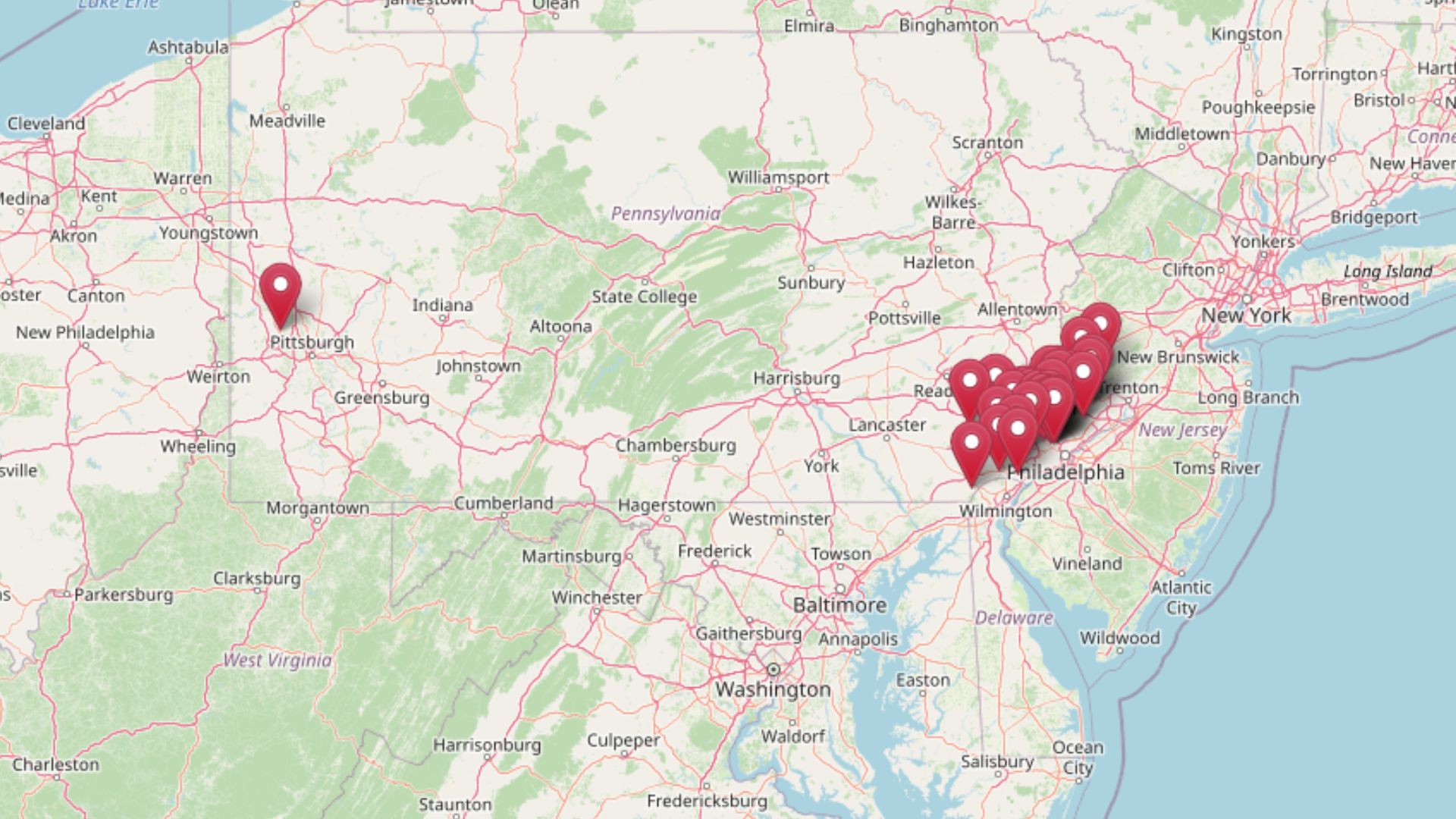
Using the latest Zillow Home Value Index data, we’ve identified the 30 most expensive towns in Pennsylvania where home prices command top dollar. These communities stand apart from the state’s broader market, where the average home value sits at $286,351. Each town on this list reflects decades of steady appreciation, premium locations, and sustained buyer demand.
From the Main Line suburbs of Philadelphia to exclusive enclaves in Chester County, these expensive markets tell the story of Pennsylvania’s housing wealth. Home values in these areas have grown far faster than the state average, with many towns seeing increases of 60% to 100% since 2010.
30. Lafayette Hill – 3% Home Price Increase Since 2024

- 2010: N/A
- 2011: N/A
- 2012: N/A
- 2013: N/A
- 2014: N/A
- 2015: N/A
- 2016: N/A
- 2017: N/A
- 2018: N/A
- 2019: N/A
- 2020: N/A
- 2021: N/A
- 2022: N/A
- 2023: N/A
- 2024: $616,494
- 2025: $634,455
Lafayette Hill has shown modest but consistent growth from 2024 to 2025, with home prices climbing 3%. The current median price of $634,455 reflects the area’s appeal among Philadelphia-area buyers. While historical data is limited, this Montgomery County community has maintained steady demand.
Why Lafayette Hill?

Why are people willing to pay so much to live here? What’s special about it?
Lafayette Hill offers buyers a perfect balance of suburban tranquility and urban accessibility, sitting just northwest of Philadelphia along the Schuylkill River. The community draws families with its highly-rated Whitpain Township Elementary School and Colonial School District. Residents appreciate the tree-lined neighborhoods, historic charm, and easy access to major highways like Route 476.
The area’s appeal extends beyond schools and commuter convenience to include recreational amenities like the Schuylkill River Trail and nearby Valley Forge National Historical Park. Lafayette Hill maintains a small-town feel while offering proximity to Philadelphia’s job market. Property values here reflect the premium buyers place on this rare combination of convenience, education, and quality of life.
How Lafayette Hill Rose to Prominence
Lafayette Hill’s prominence grew from its strategic location along the Schuylkill River, where early mills and transportation routes established the foundation for suburban development. Originally settled in the 1700s, the area was named after the Marquis de Lafayette, reflecting the region’s Revolutionary War heritage. The community remained largely agricultural until the 20th century brought suburban expansion from Philadelphia.
As Philadelphia’s metropolitan area expanded westward, Lafayette Hill became increasingly attractive to families seeking larger lots and better schools while maintaining reasonable commuting distances. The development of major highways and the improvement of local infrastructure helped transform Lafayette Hill from a rural outpost into one of Montgomery County’s more desirable residential areas.
3 Interesting Tidbits
1. Revolutionary Roots – The town sits near several Revolutionary War sites, with Valley Forge National Historical Park just minutes away, giving residents direct access to American history.
2. River Access – Lafayette Hill borders the Schuylkill River, providing residents with waterfront recreation opportunities and scenic views that enhance property values.
3. School Excellence – The Colonial School District, which serves Lafayette Hill, consistently ranks among Pennsylvania’s top districts, driving sustained housing demand from families.
29. Landenberg – 5% Home Price Increase Since 2024
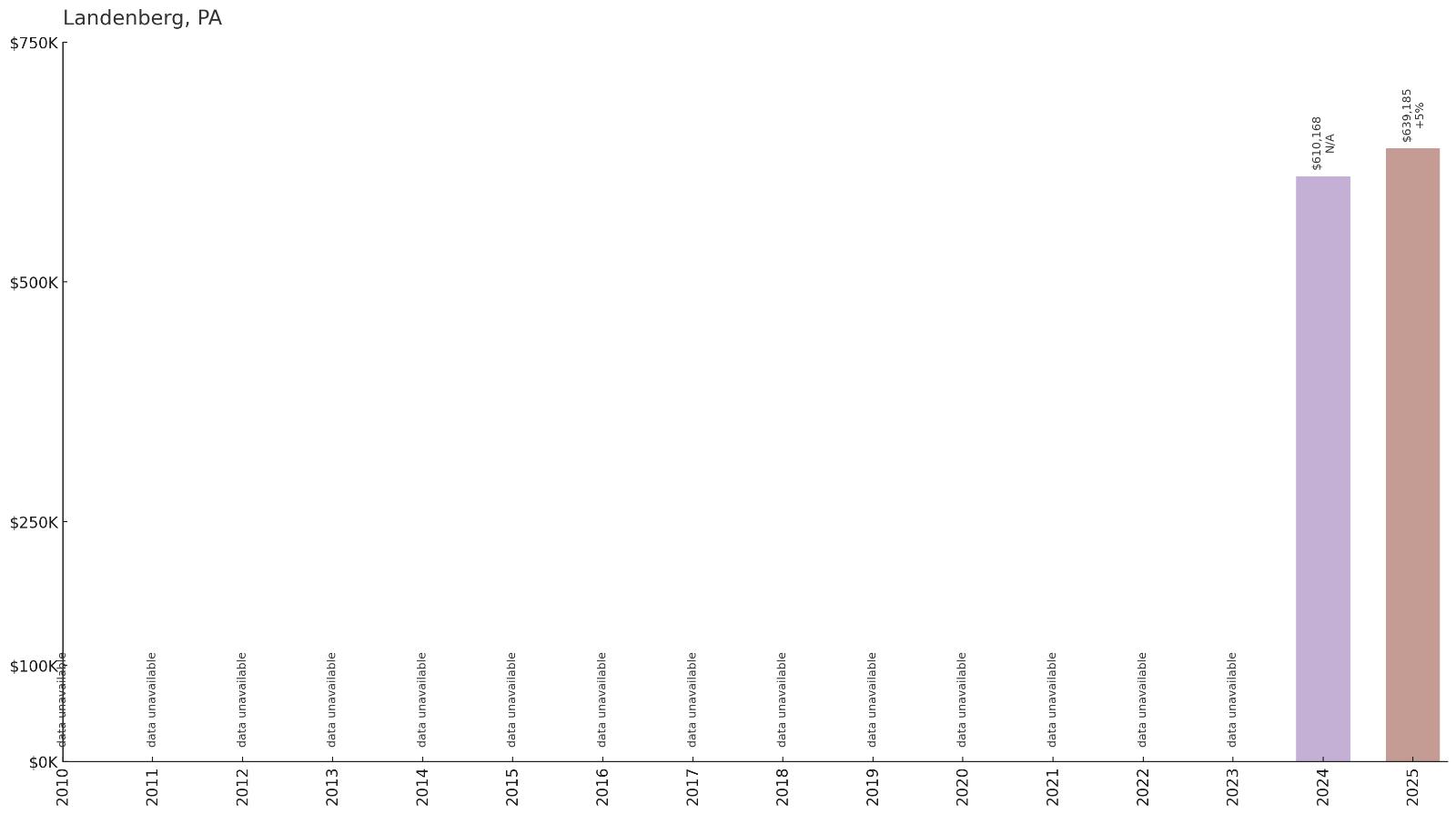
- 2010: N/A
- 2011: N/A
- 2012: N/A
- 2013: N/A
- 2014: N/A
- 2015: N/A
- 2016: N/A
- 2017: N/A
- 2018: N/A
- 2019: N/A
- 2020: N/A
- 2021: N/A
- 2022: N/A
- 2023: N/A
- 2024: $610,168
- 2025: $639,185
Landenberg experienced a solid 5% price increase from 2024 to 2025, reaching $639,185 in median home value. This Chester County community has attracted buyers seeking rural character with suburban amenities. The steady price appreciation reflects consistent demand in this southeastern Pennsylvania market.
Why Landenberg?
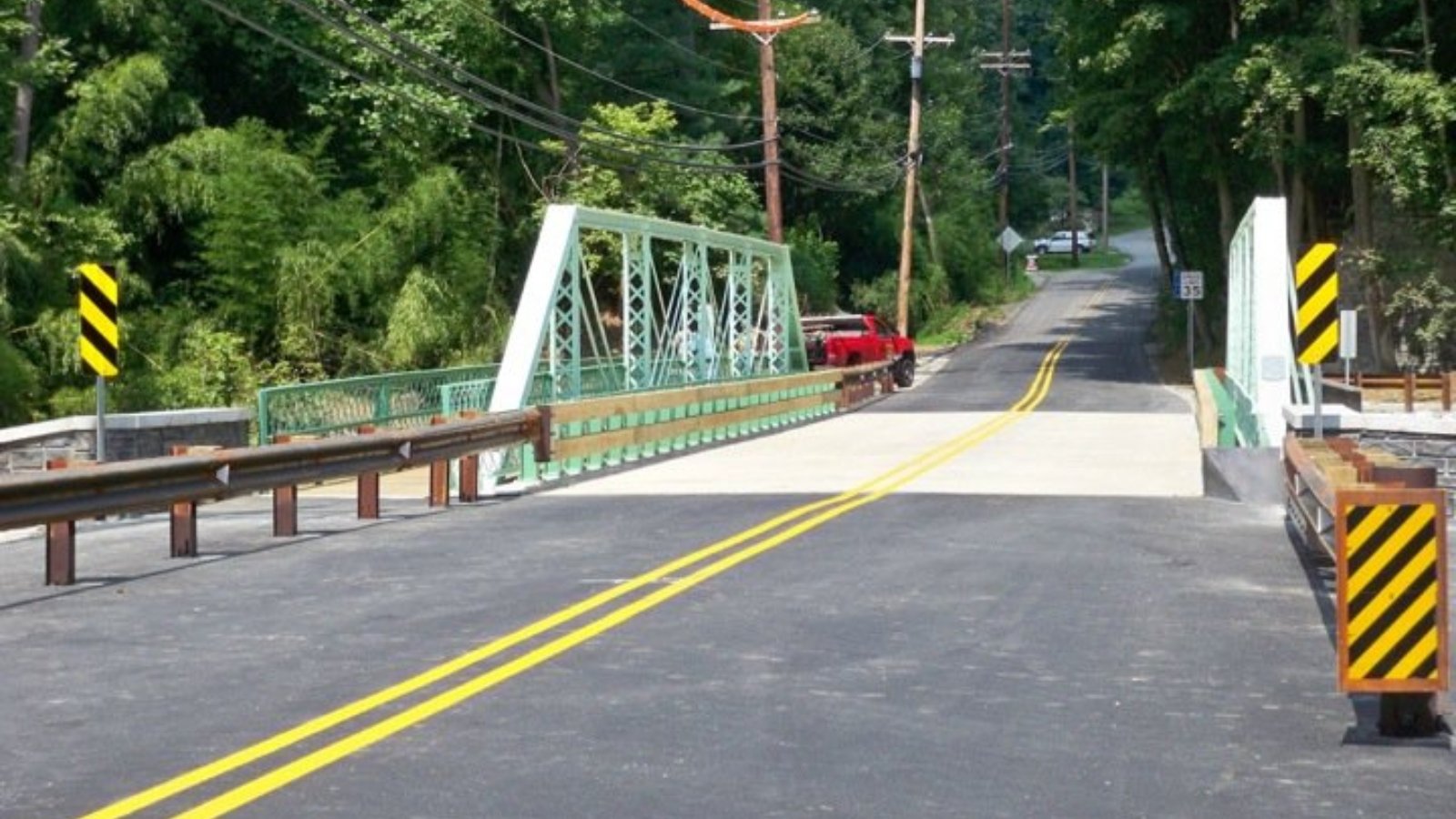
Why are people willing to pay so much to live here? What’s special about it?
Landenberg appeals to buyers seeking a rural lifestyle without sacrificing access to major employment centers in Philadelphia and Wilmington. The community offers large lots, custom homes, and a peaceful atmosphere that feels far removed from urban pressures. Families are drawn to the excellent Avon Grove School District and the area’s reputation for safety and community involvement.
The town’s location in southern Chester County provides easy access to both Pennsylvania and Delaware job markets, making it attractive to commuters. Landenberg’s rolling hills, horse farms, and preserved open space create a distinctive character that commands premium prices. Buyers here value privacy, space, and the semi-rural lifestyle that’s become increasingly rare in the Philadelphia suburbs.
How Landenberg Rose to Prominence
Landenberg’s prominence developed from its agricultural roots in Chester County’s fertile farmland, where dairy farming and horse breeding established the area’s rural character. Originally settled by Quakers in the late 1600s, the community remained primarily agricultural through most of the 20th century. The name itself reflects the area’s German and English heritage, with “berg” meaning hill or mountain.
As suburban sprawl from Philadelphia and Wilmington reached southern Chester County in recent decades, Landenberg became increasingly desirable for its combination of rural setting and suburban conveniences. The community successfully preserved much of its agricultural character while accommodating new housing developments, creating the blend of old and new that attracts today’s buyers.
3 Interesting Tidbits
1. Equestrian Heritage – Landenberg maintains a strong horse culture with numerous stables, riding trails, and equestrian events that preserve the area’s agricultural traditions.
2. Dual State Appeal – Located near the Pennsylvania-Delaware border, Landenberg residents can easily access employment and cultural opportunities in both states.
3. Historic Preservation – Many properties feature historic stone houses and barns dating back centuries, adding architectural character that appeals to buyers seeking authentic rural charm.
28. West Chester – 76% Home Price Increase Since 2010
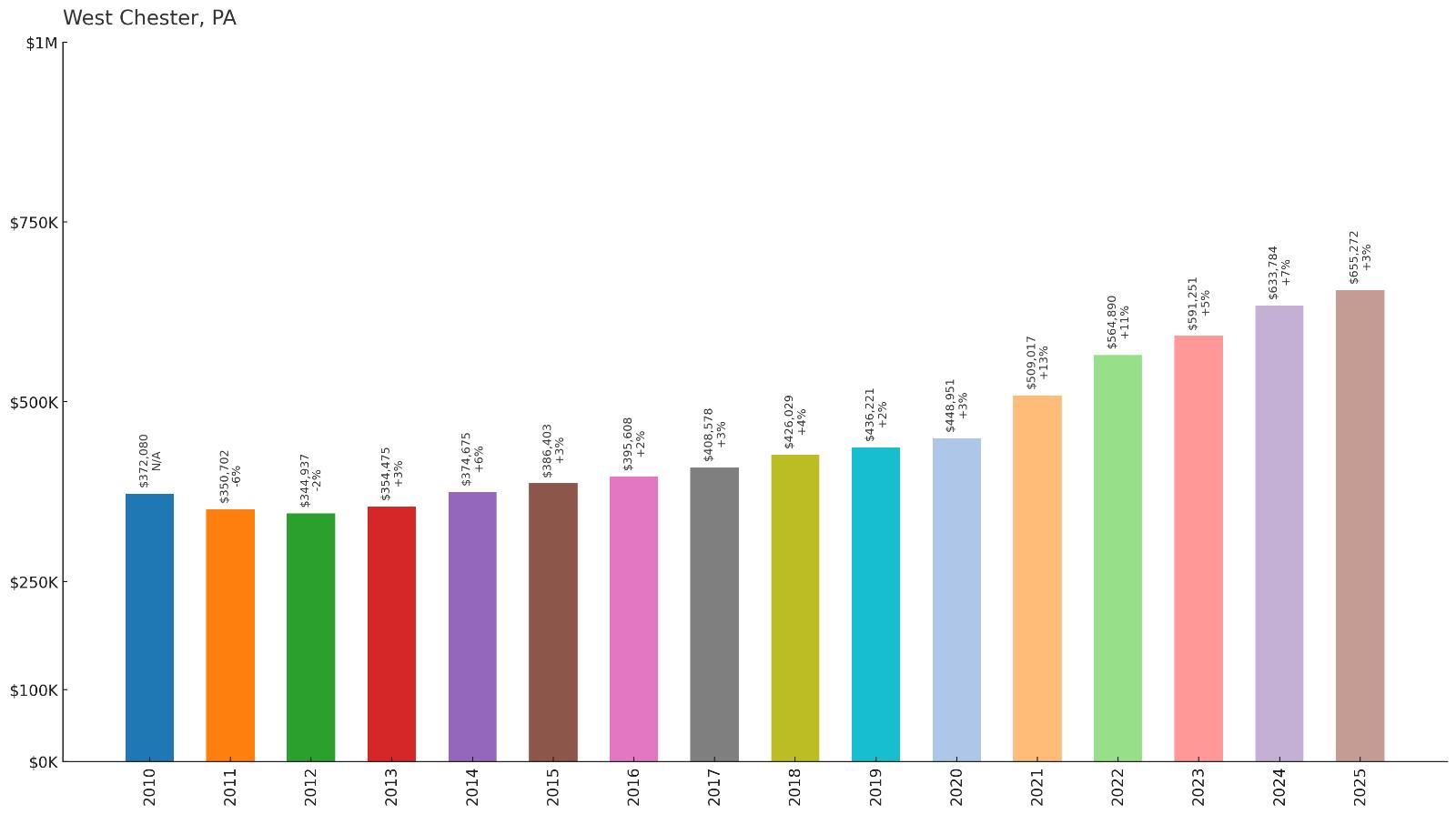
- 2010: $372,080
- 2011: $350,702
- 2012: $344,937
- 2013: $354,475
- 2014: $374,675
- 2015: $386,403
- 2016: $395,608
- 2017: $408,578
- 2018: $426,029
- 2019: $436,221
- 2020: $448,951
- 2021: $509,017
- 2022: $564,890
- 2023: $591,251
- 2024: $633,784
- 2025: $655,272
West Chester has delivered impressive returns for homeowners, with values climbing 76% since 2010 to reach $655,272. The most significant acceleration occurred during the pandemic years, with particularly strong growth in 2021 and 2022. This county seat has proven its staying power as one of Chester County’s most sought-after communities.
Why West Chester?
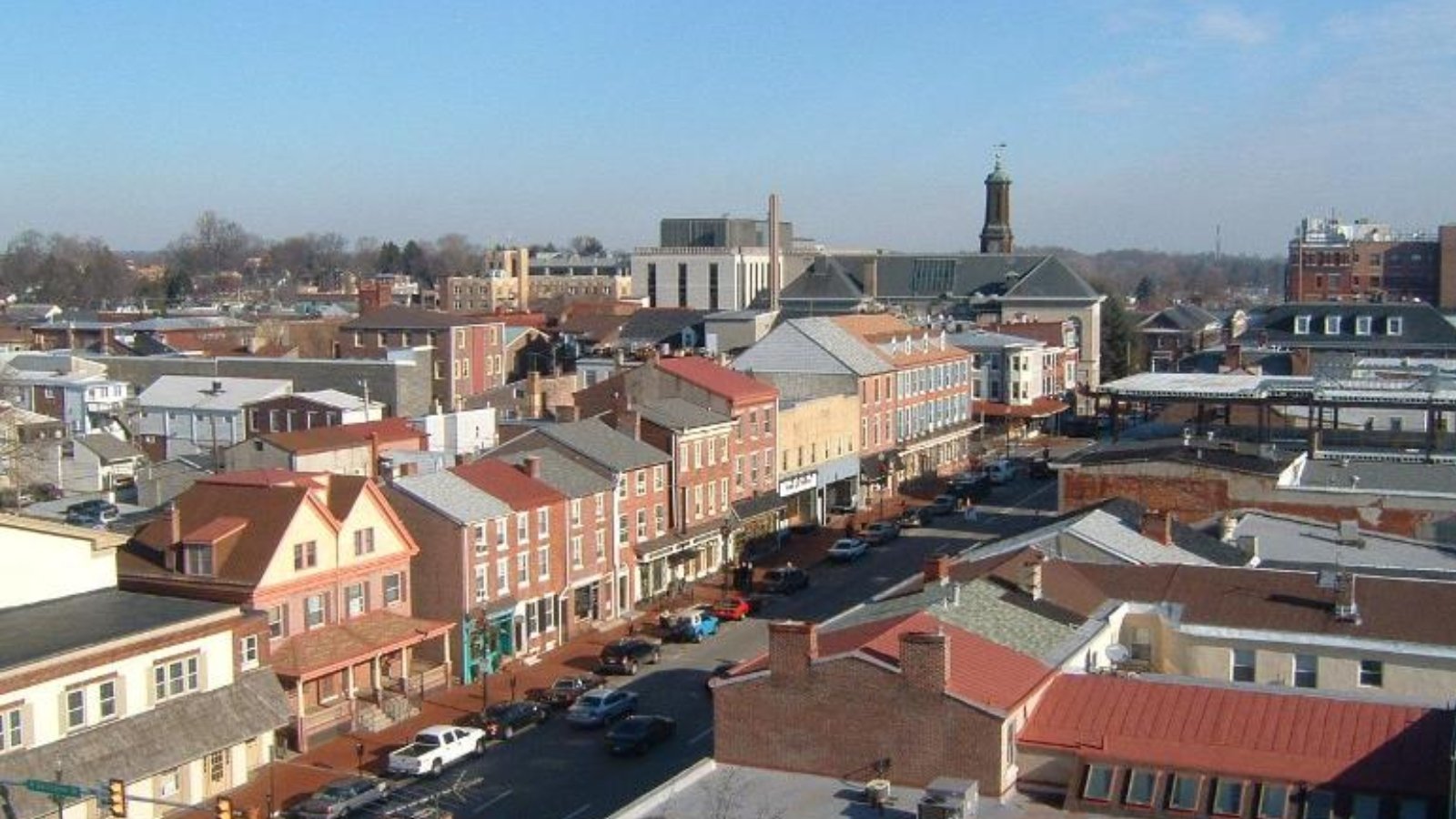
Why are people willing to pay so much to live here? What’s special about it?
West Chester combines the best of small-town charm with big-city amenities, centered around a vibrant downtown filled with restaurants, shops, and cultural attractions. The presence of West Chester University brings energy and educational resources to the community. Families are particularly drawn to the highly-rated West Chester Area School District and the town’s walkable neighborhoods.
The community’s location provides excellent access to Philadelphia, making it popular with commuters who want suburban living without sacrificing career opportunities. West Chester’s historic architecture, tree-lined streets, and active community calendar create an appealing lifestyle that justifies premium housing costs. The town successfully balances growth with preservation, maintaining character while adding modern conveniences.
How West Chester Rose to Prominence
West Chester’s prominence began as the Chester County seat, established in 1786 when it replaced Chester as the county’s governmental center due to its more central location. The town’s strategic position along major transportation routes helped it grow into a regional hub for commerce and education. The arrival of the railroad in the 19th century further enhanced its connectivity and economic importance.
West Chester University, founded in 1871 as a teachers’ college, became a major factor in the town’s development and continued growth. The university brought stability, cultural enrichment, and a steady influx of students, faculty, and staff who contributed to the local economy and housing demand. This educational foundation helped West Chester weather economic downturns while maintaining its appeal to families and young professionals.
3 Interesting Tidbits
1. Underground Railroad History – West Chester played a significant role in the Underground Railroad, with several buildings serving as stops for escaped slaves heading north to freedom.
2. Festival Central – The town hosts numerous annual events including the West Chester Restaurant Festival and Old Fashioned Christmas, drawing visitors from across the region.
3. Architecture Showcase – West Chester’s historic district features well-preserved examples of Federal, Georgian, and Victorian architecture, creating a visually distinctive downtown core.
27. Bala-Cynwyd – 5% Home Price Increase Since 2024
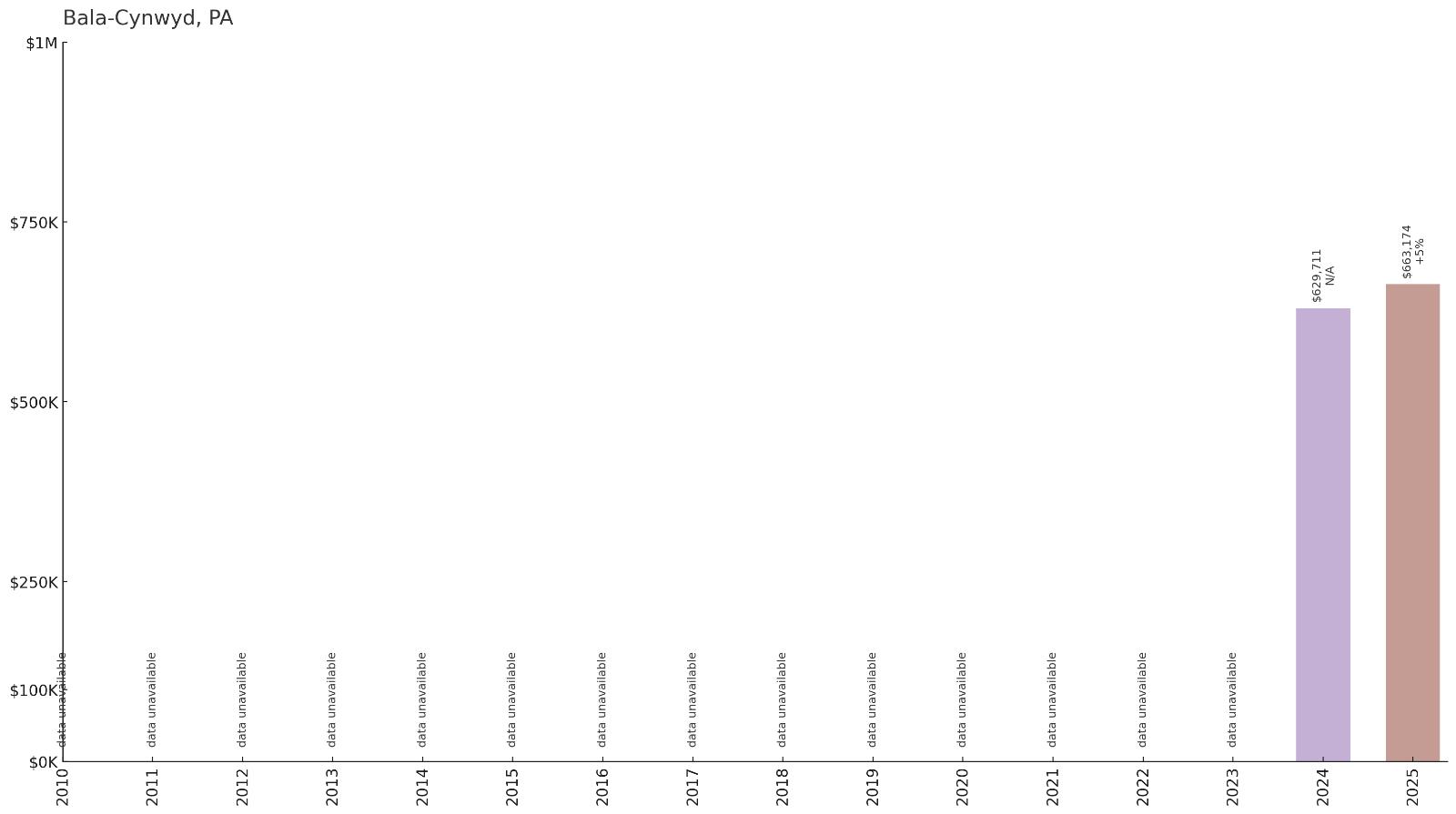
- 2010: N/A
- 2011: N/A
- 2012: N/A
- 2013: N/A
- 2014: N/A
- 2015: N/A
- 2016: N/A
- 2017: N/A
- 2018: N/A
- 2019: N/A
- 2020: N/A
- 2021: N/A
- 2022: N/A
- 2023: N/A
- 2024: $629,711
- 2025: $663,174
Bala-Cynwyd posted a healthy 5% gain from 2024 to 2025, with median home values reaching $663,174. This Montgomery County community continues to attract buyers with its Main Line prestige and proximity to Philadelphia. The steady appreciation reflects ongoing demand for this well-established suburban enclave.
Why Bala-Cynwyd?
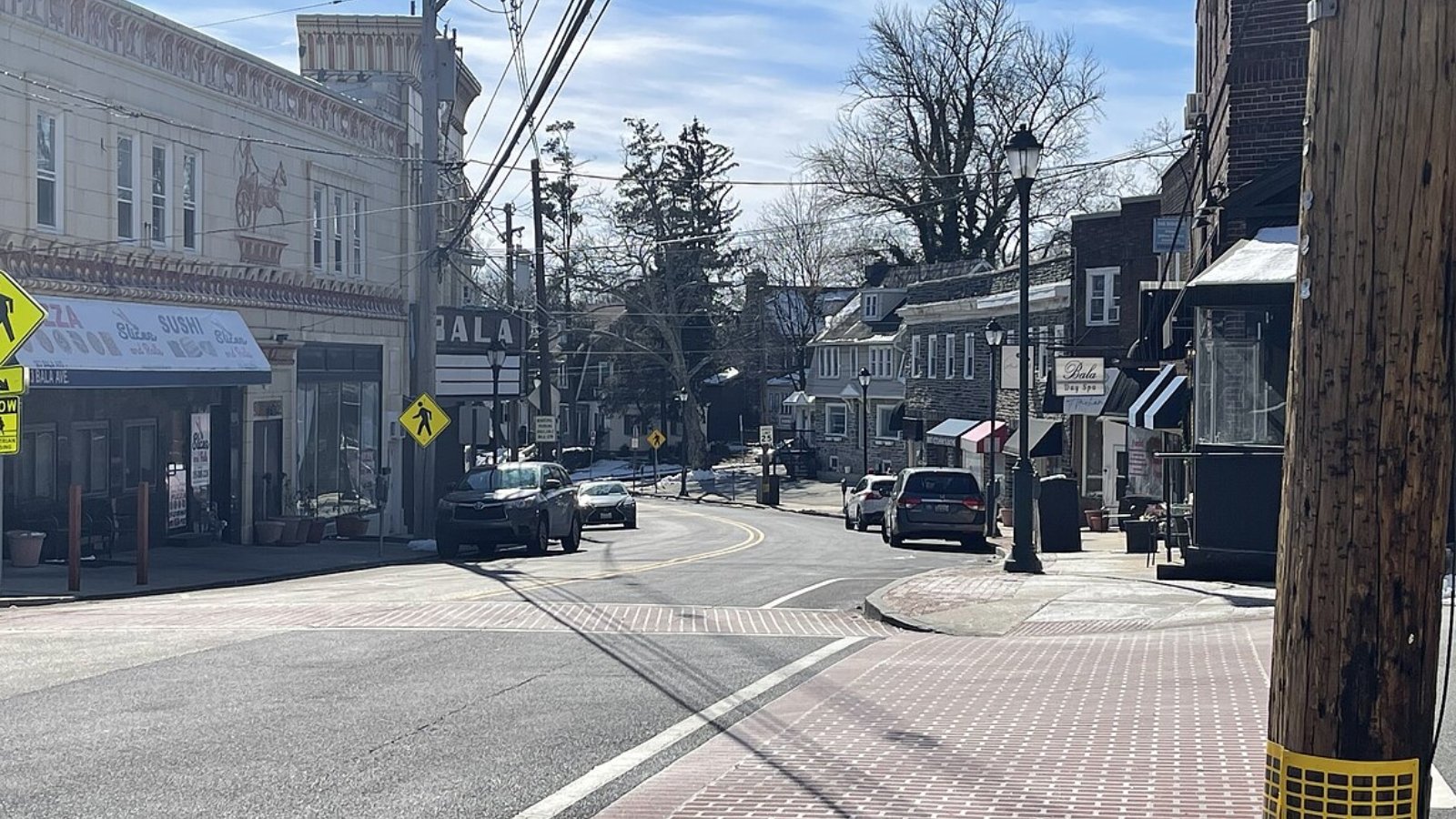
Why are people willing to pay so much to live here? What’s special about it?
Bala-Cynwyd offers Main Line prestige at a more accessible price point than some neighboring communities, making it attractive to professionals and families seeking suburban elegance. The area features beautiful tree-lined streets, well-maintained homes, and excellent access to Philadelphia via multiple transportation options. Parents value the Lower Merion School District, consistently ranked among Pennsylvania’s best.
The community’s location along City Avenue provides easy access to Philadelphia’s Center City and major employment centers while maintaining a distinctly suburban feel. Bala-Cynwyd’s mix of architectural styles, from colonial revivals to mid-century modern homes, appeals to diverse buyer preferences. The area’s shopping, dining, and recreational amenities create a complete lifestyle package that justifies premium pricing.
How Bala-Cynwyd Rose to Prominence
Bala-Cynwyd’s prominence grew from its position as one of the original Main Line communities, developed during the late 19th and early 20th centuries as Philadelphia’s wealthy elite sought suburban retreats. The Pennsylvania Railroad’s Main Line facilitated this transformation, making it possible for affluent families to live in the suburbs while maintaining business connections in the city.
The community’s Welsh-inspired name reflects the area’s early development patterns, as many streets and neighborhoods were named after places in Wales. Post-World War II suburban expansion brought new housing developments and increased population density, but Bala-Cynwyd maintained its reputation as an upscale address with excellent schools and convenient transportation access.
3 Interesting Tidbits
1. Media Hub – Bala-Cynwyd has been home to several major media companies and radio stations, earning it recognition as a regional communications center.
2. Shopping Legacy – The community was once home to one of the area’s first major shopping centers, helping establish suburban retail patterns that spread throughout the region.
3. Transportation Hub – Multiple SEPTA train lines serve the area, providing residents with exceptional access to Philadelphia and surrounding communities.
26. Glenmoore – 78% Home Price Increase Since 2010
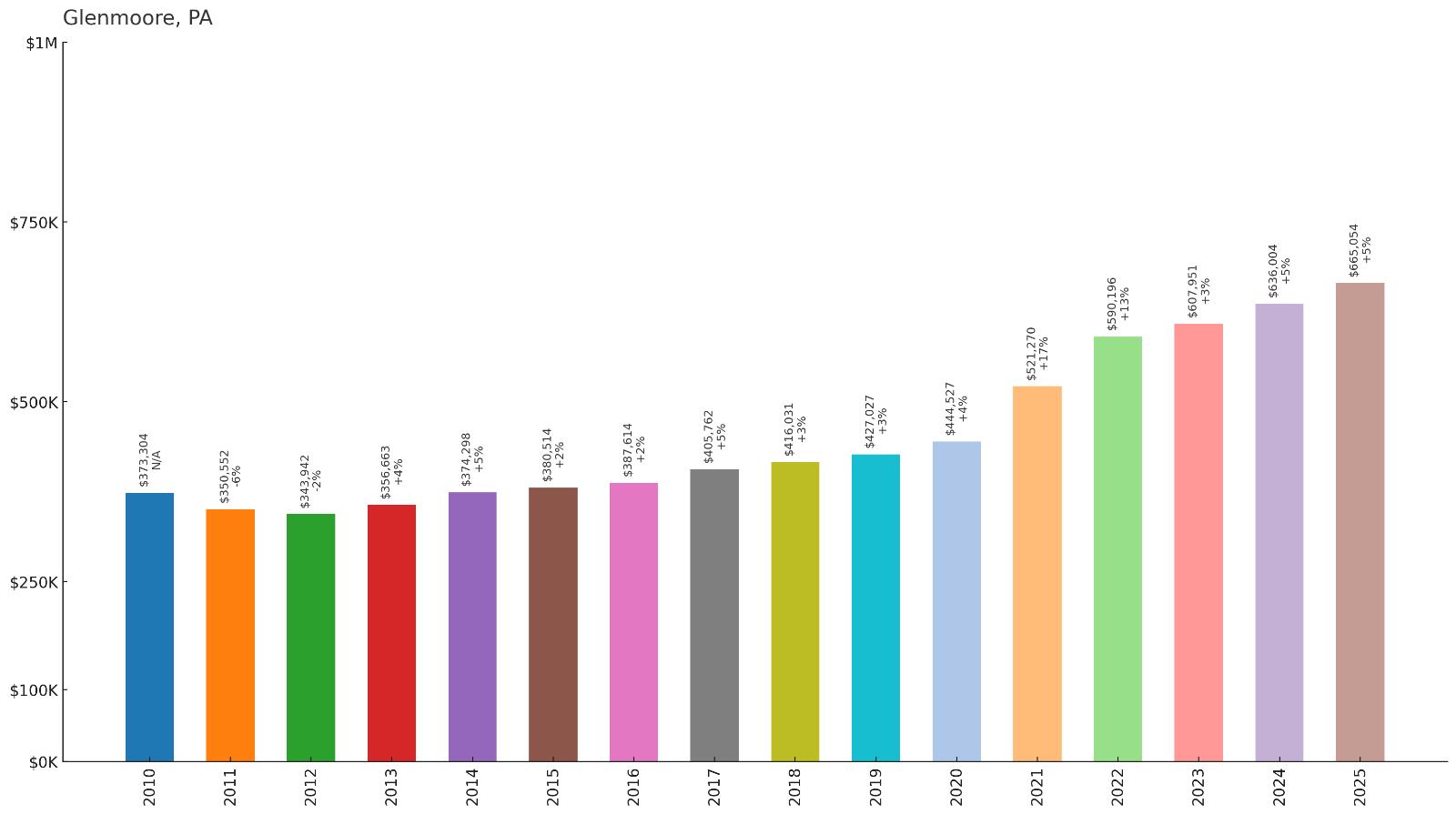
- 2010: $373,304
- 2011: $350,552
- 2012: $343,942
- 2013: $356,663
- 2014: $374,298
- 2015: $380,514
- 2016: $387,614
- 2017: $405,762
- 2018: $416,031
- 2019: $427,027
- 2020: $444,527
- 2021: $521,270
- 2022: $590,196
- 2023: $607,951
- 2024: $636,004
- 2025: $665,054
Glenmoore has rewarded homeowners with a remarkable 78% increase in home values since 2010, now reaching $665,054. The community experienced steady growth through the 2010s before accelerating significantly during and after the pandemic. This Chester County location has proven particularly attractive to buyers seeking rural character with suburban conveniences.
Why Glenmoore?
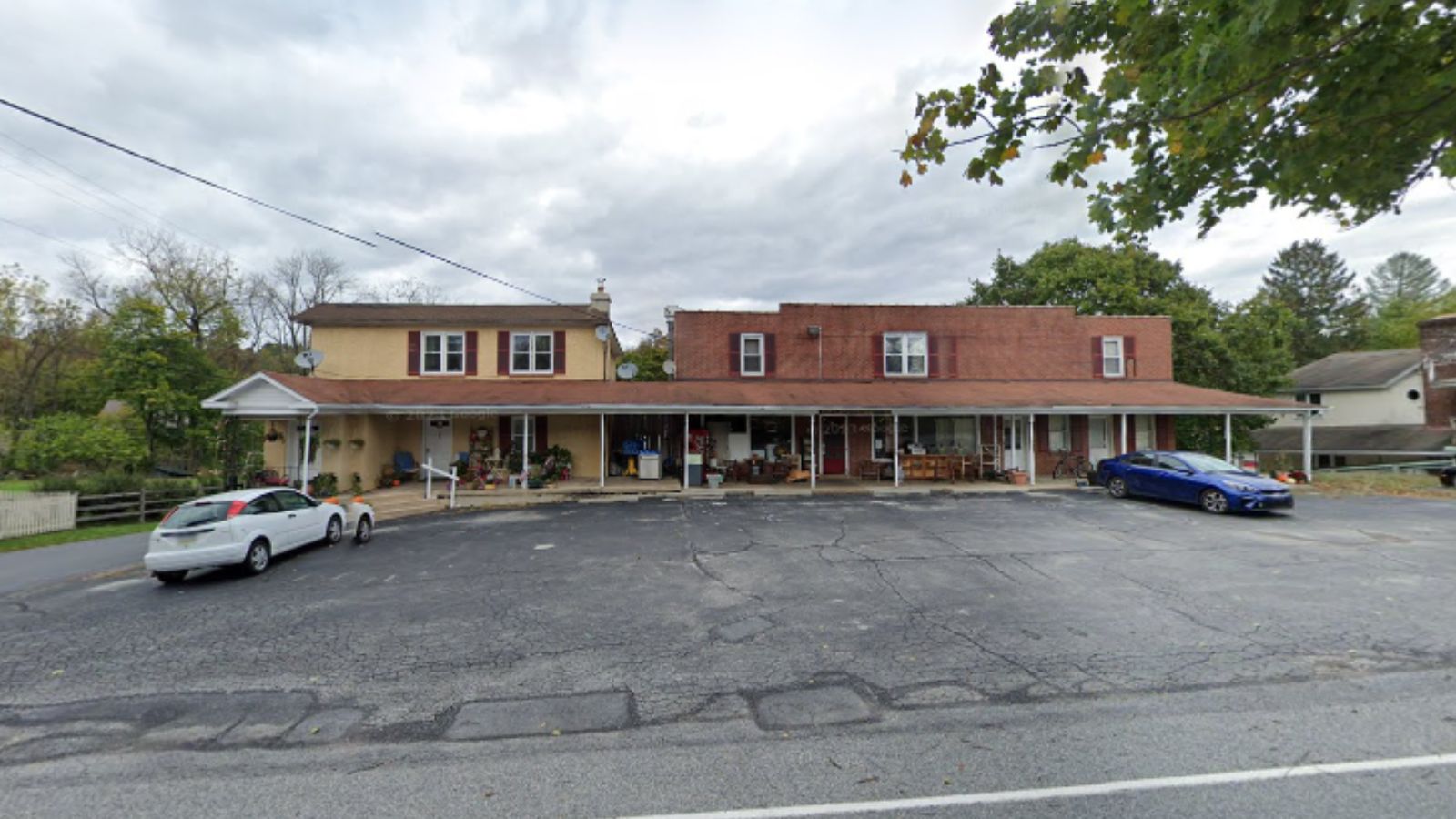
Why are people willing to pay so much to live here? What’s special about it?
Glenmoore attracts buyers seeking a rural lifestyle with modern amenities, offering large lots, custom homes, and a peaceful setting in western Chester County. The area appeals to families who value the highly-rated Downingtown Area School District while wanting more space and privacy than typical suburban developments provide. The community’s rolling hills and preserved farmland create a distinctive character.
Horse enthusiasts particularly value Glenmoore’s equestrian-friendly zoning and numerous stables throughout the area. The location provides reasonable access to Philadelphia employment centers while maintaining a country atmosphere that feels worlds away from urban pressures. Buyers here are willing to pay premium prices for this rare combination of space, schools, and semi-rural lifestyle.
How Glenmoore Rose to Prominence
Glenmoore’s prominence developed from its agricultural heritage in Chester County’s fertile western reaches, where dairy farming and horse breeding established the area’s rural character. Originally settled by Quakers and other early Pennsylvania colonists, the community remained largely agricultural through most of the 20th century. The name reflects the area’s Scottish and Irish heritage, with “glen” meaning valley and “moore” referring to open land.
As suburban sprawl reached western Chester County in recent decades, Glenmoore became increasingly attractive to buyers seeking larger properties and rural settings. The community successfully balanced new development with agricultural preservation, creating zoning that allows for custom homes on substantial lots while protecting the area’s distinctive character.
3 Interesting Tidbits
1. Horse Country – Glenmoore sits in the heart of Chester County’s horse country, with numerous training facilities, boarding stables, and equestrian events throughout the year.
2. Historic Preservation – Many properties feature restored 18th and 19th-century stone farmhouses and barns, preserving the area’s agricultural architectural heritage.
3. Rural Zoning – The township maintains large minimum lot sizes that help preserve the area’s rural character and prevent overdevelopment that has affected other suburban communities.
25. Bryn Athyn – 4% Home Price Increase Since 2024
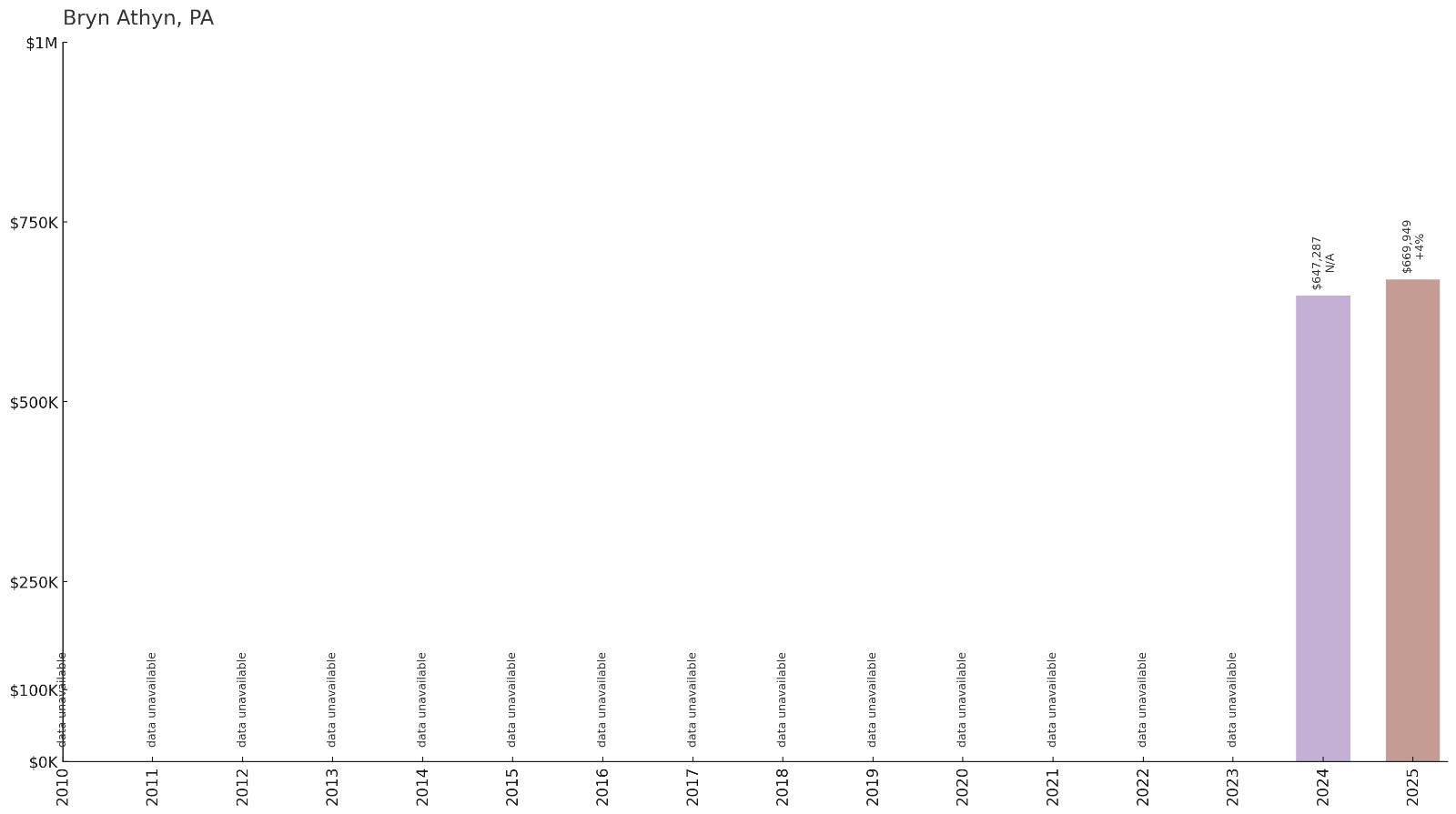
- 2010: N/A
- 2011: N/A
- 2012: N/A
- 2013: N/A
- 2014: N/A
- 2015: N/A
- 2016: N/A
- 2017: N/A
- 2018: N/A
- 2019: N/A
- 2020: N/A
- 2021: N/A
- 2022: N/A
- 2023: N/A
- 2024: $647,287
- 2025: $669,949
Bryn Athyn achieved a steady 4% appreciation from 2024 to 2025, with home values reaching $669,949. This Montgomery County borough continues to attract buyers drawn to its unique character and proximity to Philadelphia. The consistent growth reflects sustained demand for this distinctive community.
Why Bryn Athyn?
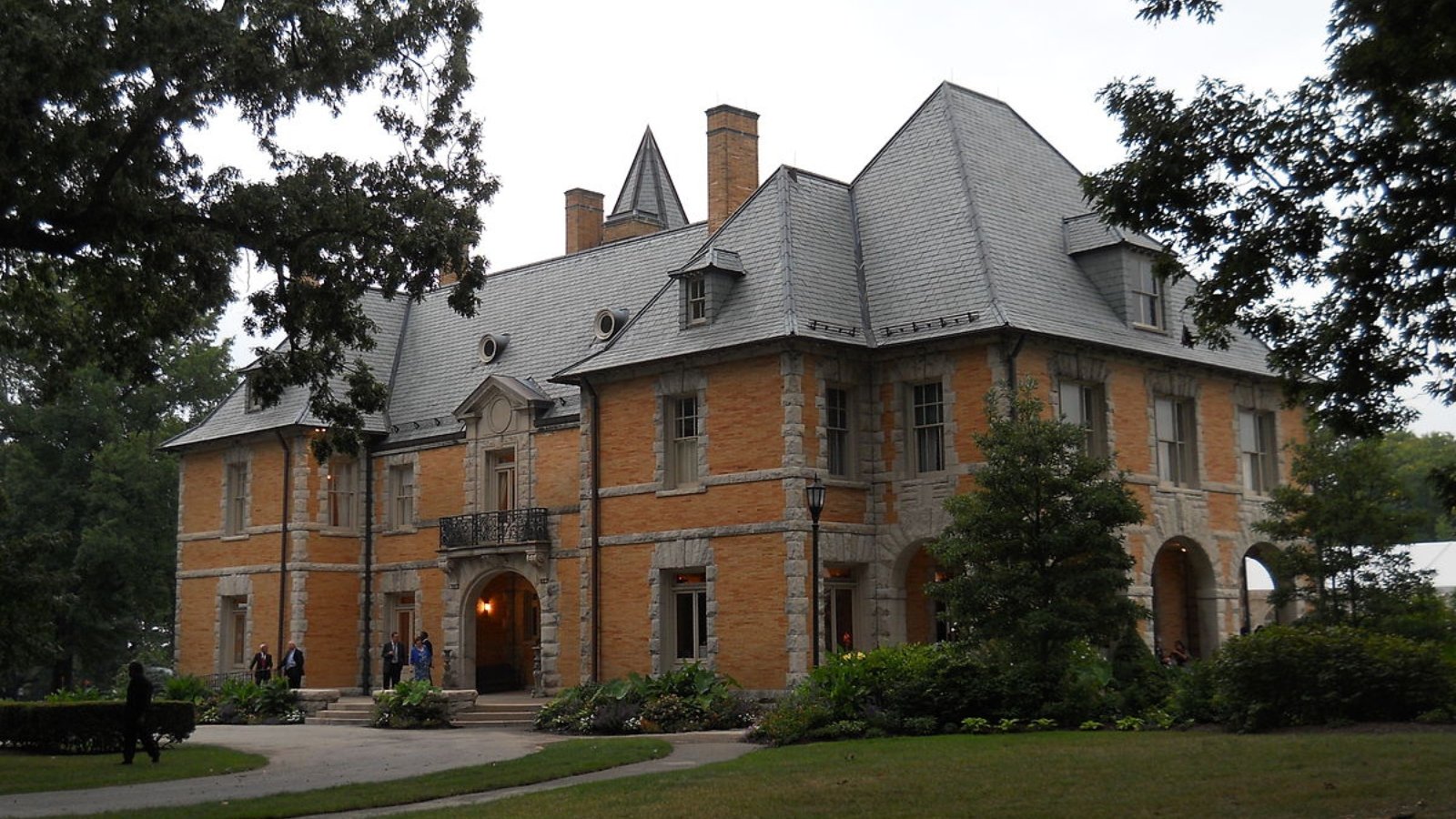
Why are people willing to pay so much to live here? What’s special about it?
Bryn Athyn offers buyers a truly unique community experience, built around the New Church (Swedenborgian) religious movement and featuring remarkable architecture including the Gothic Revival cathedral and Glencairn Museum. The community maintains a village-like atmosphere with tree-lined streets, historic buildings, and carefully preserved green spaces. Families value the area’s safety, community involvement, and proximity to excellent schools.
The borough’s location provides convenient access to Philadelphia while maintaining a distinctly different character from typical suburban developments. Bryn Athyn College adds cultural and educational resources to the community, creating an environment that appeals to intellectually-minded residents. Property values reflect the premium buyers place on this rare combination of history, architecture, and community cohesion.
How Bryn Athyn Rose to Prominence
Bryn Athyn’s prominence grew from its founding in the early 1900s as a planned religious community centered around the New Church movement. The Pitcairn family, wealthy Pittsburgh industrialists who converted to Swedenborgianism, purchased land north of Philadelphia to create an ideal community reflecting their religious values. They commissioned renowned architects to design the cathedral, college, and residential areas in cohesive architectural styles.
The community was carefully planned with wide streets, substantial lots, and architectural guidelines that created a unified aesthetic still evident today. Unlike typical suburban developments driven by market forces, Bryn Athyn was designed as a complete community with religious, educational, and residential components working together to create a distinctive place.
3 Interesting Tidbits
1. Architectural Marvel – The Bryn Athyn Cathedral, completed in 1919, features medieval craftsmanship techniques and stained glass windows made on-site in the community’s own glassworks.
2. Museum Quality – Glencairn Museum houses one of the country’s finest collections of medieval art and religious artifacts, making the community a cultural destination.
3. Planned Community – Unlike most Pennsylvania towns that grew organically, Bryn Athyn was carefully designed from the beginning with coordinated architecture, landscaping, and community facilities.
24. Ambler – 87% Home Price Increase Since 2010
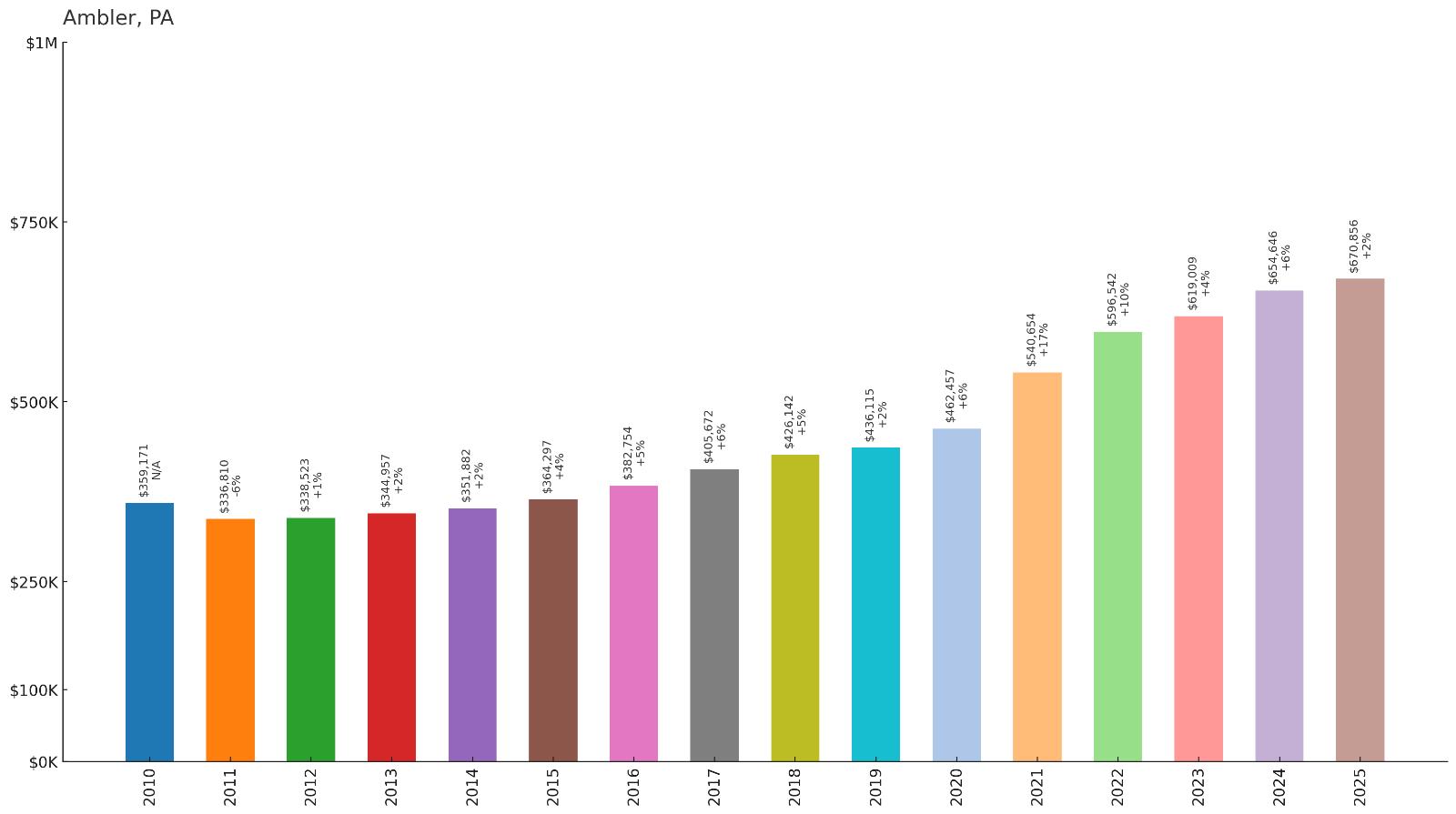
- 2010: $359,171
- 2011: $336,810
- 2012: $338,523
- 2013: $344,957
- 2014: $351,882
- 2015: $364,297
- 2016: $382,754
- 2017: $405,672
- 2018: $426,142
- 2019: $436,115
- 2020: $462,457
- 2021: $540,654
- 2022: $596,542
- 2023: $619,009
- 2024: $654,646
- 2025: $670,856
Ambler has delivered exceptional returns with an 87% increase in home values since 2010, reaching $670,856 in 2025. The community showed steady appreciation through the decade before accelerating during the pandemic years. This Montgomery County borough has established itself as one of the area’s most desirable communities for families and commuters.
Why Ambler?
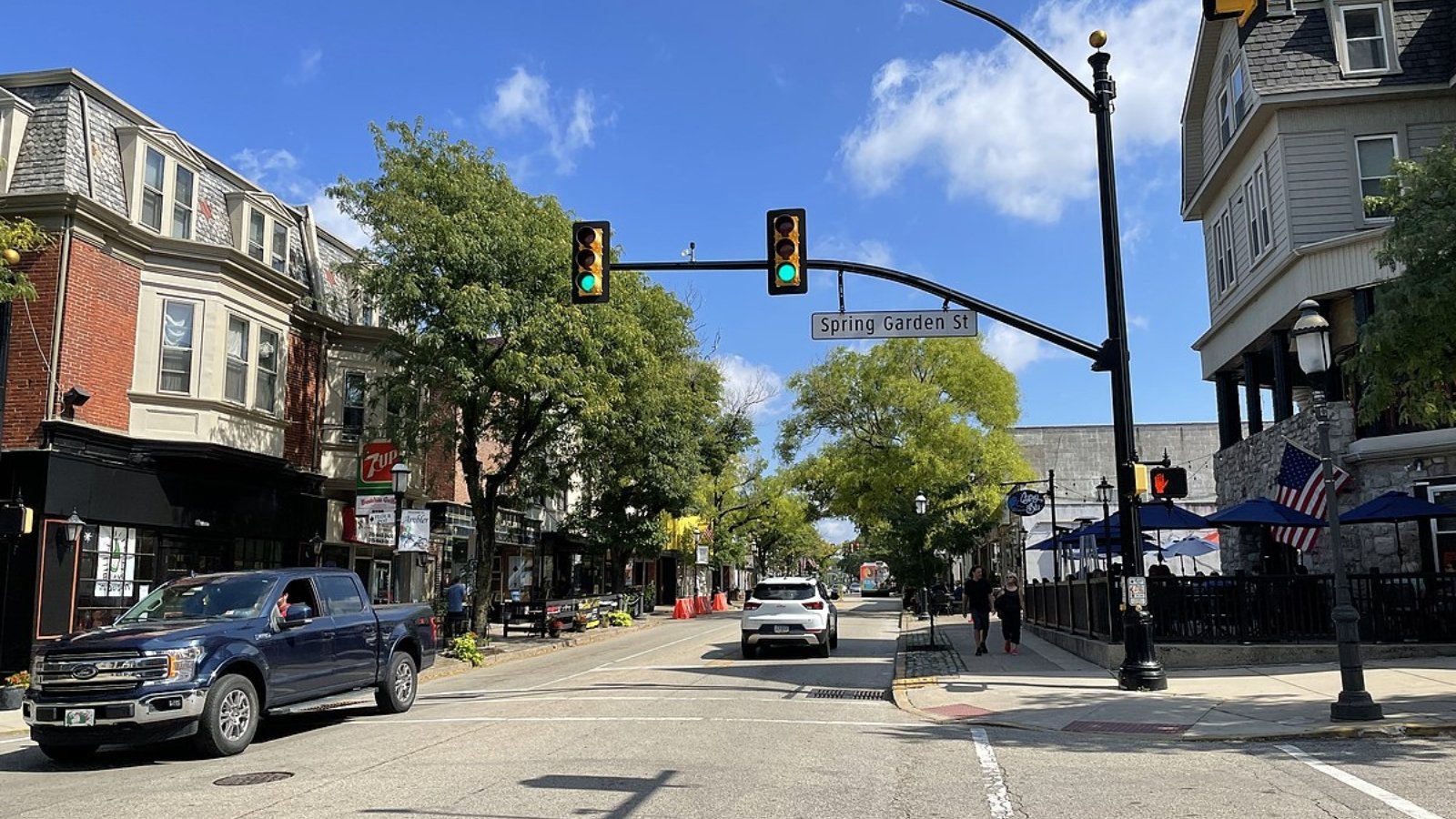
Why are people willing to pay so much to live here? What’s special about it?
Ambler combines small-town charm with excellent transportation access, making it incredibly popular with Philadelphia commuters who want walkable neighborhoods and community character. The vibrant downtown area features local shops, restaurants, and regular community events that create a strong sense of place. Families are particularly drawn to the highly-rated Wissahickon School District and the borough’s tree-lined residential streets.
The community’s SEPTA rail station provides direct access to Philadelphia’s Center City in under an hour, making it attractive to professionals who want suburban living without lengthy commutes. Ambler’s mix of housing types, from historic homes to newer developments, appeals to diverse buyer preferences. The area’s parks, including the popular Wissahickon Creek trails, add recreational value that justifies premium pricing.
How Ambler Rose to Prominence
Ambler’s prominence grew from its establishment as a railroad town in the 1850s, when the North Pennsylvania Railroad brought transportation connectivity and industrial development to the area. Named after Mary Ambler, the daughter of a local landowner, the community quickly developed around the railroad station as a residential and commercial center. The railroad made it possible for residents to commute to Philadelphia while enjoying suburban living.
The town’s growth accelerated in the early 20th century as trolley lines and improved roads enhanced connectivity with surrounding areas. Ambler successfully transformed from an industrial town to a primarily residential community while preserving its historic downtown core. The combination of transportation access, small-town character, and proximity to Philadelphia created enduring appeal that continues to drive housing demand.
3 Interesting Tidbits
1. Asbestos History – Ambler was once known as the “Asbestos Capital of the World” due to a major manufacturing plant that operated from 1881 to 1986, now successfully remediated and redeveloped.
2. Arts Hub – The restored Ambler Theater, built in 1928, serves as a cultural centerpiece with live performances and community events throughout the year.
3. Green Spaces – The borough maintains extensive parkland including access to Wissahickon Creek trails, providing residents with abundant outdoor recreation opportunities.
23. Churchville – 77% Home Price Increase Since 2010
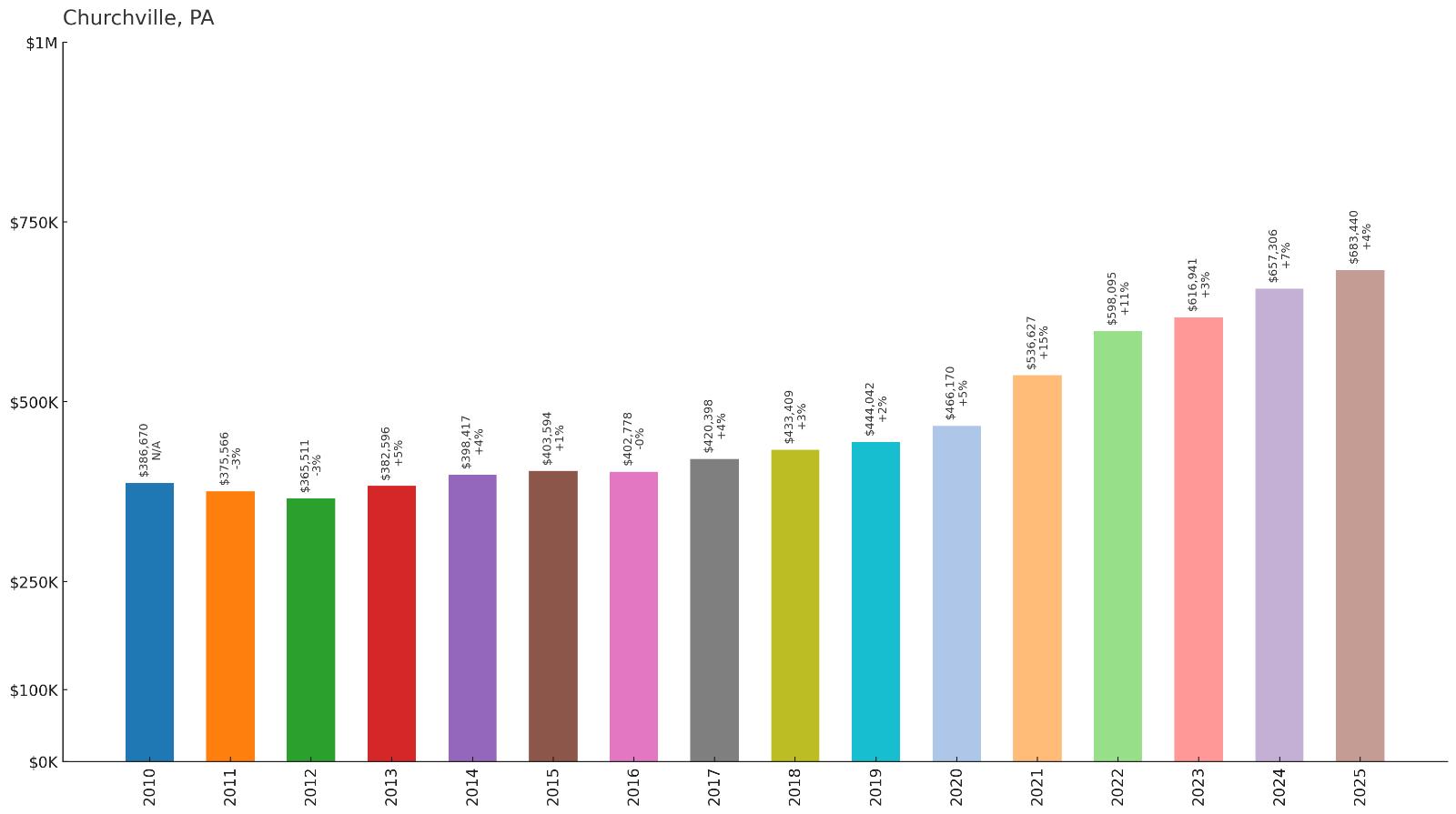
- 2010: $386,670
- 2011: $375,566
- 2012: $365,511
- 2013: $382,596
- 2014: $398,417
- 2015: $403,594
- 2016: $402,778
- 2017: $420,398
- 2018: $433,409
- 2019: $444,042
- 2020: $466,170
- 2021: $536,627
- 2022: $598,095
- 2023: $616,941
- 2024: $657,306
- 2025: $683,440
Churchville has provided strong returns with a 77% increase in home values since 2010, now reaching $683,440. The community experienced steady growth through the 2010s before surging during the pandemic years, with particularly impressive gains in 2021 and 2022. This Bucks County community has attracted buyers seeking suburban excellence with Philadelphia access.
Why Churchville?

Why are people willing to pay so much to live here? What’s special about it?
Churchville appeals to families seeking top-tier education combined with suburban tranquility, served by the highly-regarded Council Rock School District known for academic excellence and extensive extracurricular programs. The community features well-maintained neighborhoods with mature trees, sidewalks, and a strong sense of safety that parents value. The area offers a perfect balance of residential quiet and convenient access to shopping, dining, and recreation.
Located in central Bucks County, Churchville provides reasonable commuting access to both Philadelphia and New York employment markets while maintaining a distinctly suburban character. The community’s parks, including the popular Core Creek Park, offer extensive recreational opportunities from hiking trails to sports fields. Property values reflect the premium buyers place on this combination of excellent schools, community amenities, and location.
How Churchville Rose to Prominence
Churchville’s prominence developed from its agricultural roots in fertile Bucks County farmland, where early Quaker and German settlers established farming communities in the 18th century. The area remained largely rural through the mid-20th century, with small villages serving local farming needs. The name reflects the area’s early religious heritage, with several churches serving as community centers.
Suburban development accelerated after World War II as improved highways made commuting to Philadelphia more feasible, transforming farmland into residential subdivisions. The establishment of the Council Rock School District in the 1950s created a reputation for educational excellence that attracted families and drove continued development. Churchville successfully balanced growth with preservation of green space, creating the suburban ideal that continues to appeal to homebuyers.
3 Interesting Tidbits
1. School Excellence – The Council Rock School District consistently ranks among Pennsylvania’s top districts, with multiple schools receiving national recognition for academic achievement.
2. Park Paradise – Core Creek Park offers over 1,200 acres of recreational space including lakes, trails, and sports facilities that serve the entire community.
3. Historic Preservation – The area maintains several historic sites including old stone houses and barns that preserve connections to its agricultural heritage.
22. Garnet Valley – 85% Home Price Increase Since 2010
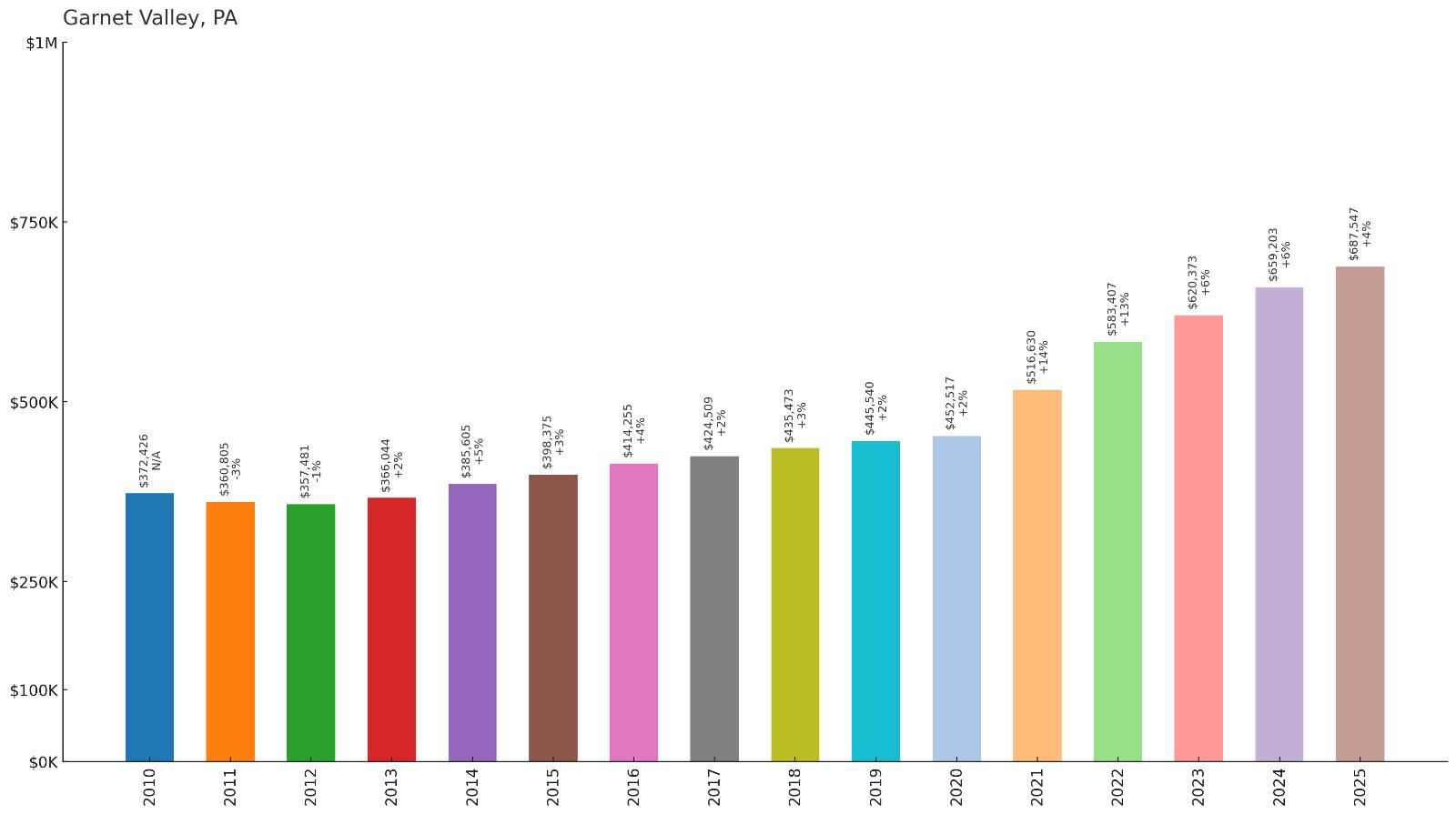
- 2010: $372,426
- 2011: $360,805
- 2012: $357,481
- 2013: $366,044
- 2014: $385,605
- 2015: $398,375
- 2016: $414,255
- 2017: $424,509
- 2018: $435,473
- 2019: $445,540
- 2020: $452,517
- 2021: $516,630
- 2022: $583,407
- 2023: $620,373
- 2024: $659,203
- 2025: $687,547
Garnet Valley has achieved impressive growth with an 85% increase in home values since 2010, reaching $687,547 in 2025. The community showed consistent appreciation throughout the decade, with significant acceleration during the pandemic years. This Delaware County location has become increasingly popular with families seeking excellent schools and suburban amenities.
Why Garnet Valley?

Why are people willing to pay so much to live here? What’s special about it?
Garnet Valley attracts families primarily for its outstanding school district, consistently ranked among Pennsylvania’s best with exceptional academic programs and extensive extracurricular offerings. The community features newer housing developments with modern amenities, well-planned neighborhoods, and abundant green space that creates an appealing suburban environment. Parents particularly value the area’s safety, community involvement, and family-oriented atmosphere.
The location in Delaware County provides convenient access to Philadelphia employment centers while maintaining a distinctly suburban character with shopping centers, recreational facilities, and community amenities. Garnet Valley’s blend of newer construction and preserved natural areas appeals to buyers seeking modern conveniences in a well-planned setting. Property values reflect the premium families place on top-tier education and suburban quality of life.
How Garnet Valley Rose to Prominence
Garnet Valley’s prominence is relatively recent, emerging from the consolidation of several smaller school districts in the 1960s to form the Garnet Valley School District. This created an educational anchor that attracted residential development to previously rural areas of Delaware County. The name “Garnet Valley” was adopted to reflect the new district’s identity, chosen for its association with the gemstone and the valley topography of the region.
Large-scale residential development accelerated in the 1980s and 1990s as developers recognized the appeal of combining excellent schools with convenient suburban locations. The community’s growth was carefully managed to preserve green space and create cohesive neighborhoods, establishing the planned suburban character that continues to attract families seeking modern amenities and educational excellence.
3 Interesting Tidbits
1. Academic Powerhouse – Garnet Valley High School consistently produces National Merit Scholars and has been recognized by U.S. News & World Report as one of America’s best high schools.
2. Sports Excellence – The district’s athletic programs regularly compete at state levels, with particular strength in lacrosse, field hockey, and track and field.
3. Green Planning – The community maintains extensive preserved open space and recreational facilities, including the popular Garnet Valley Sports Association complex.
21. Blue Bell – 79% Home Price Increase Since 2010
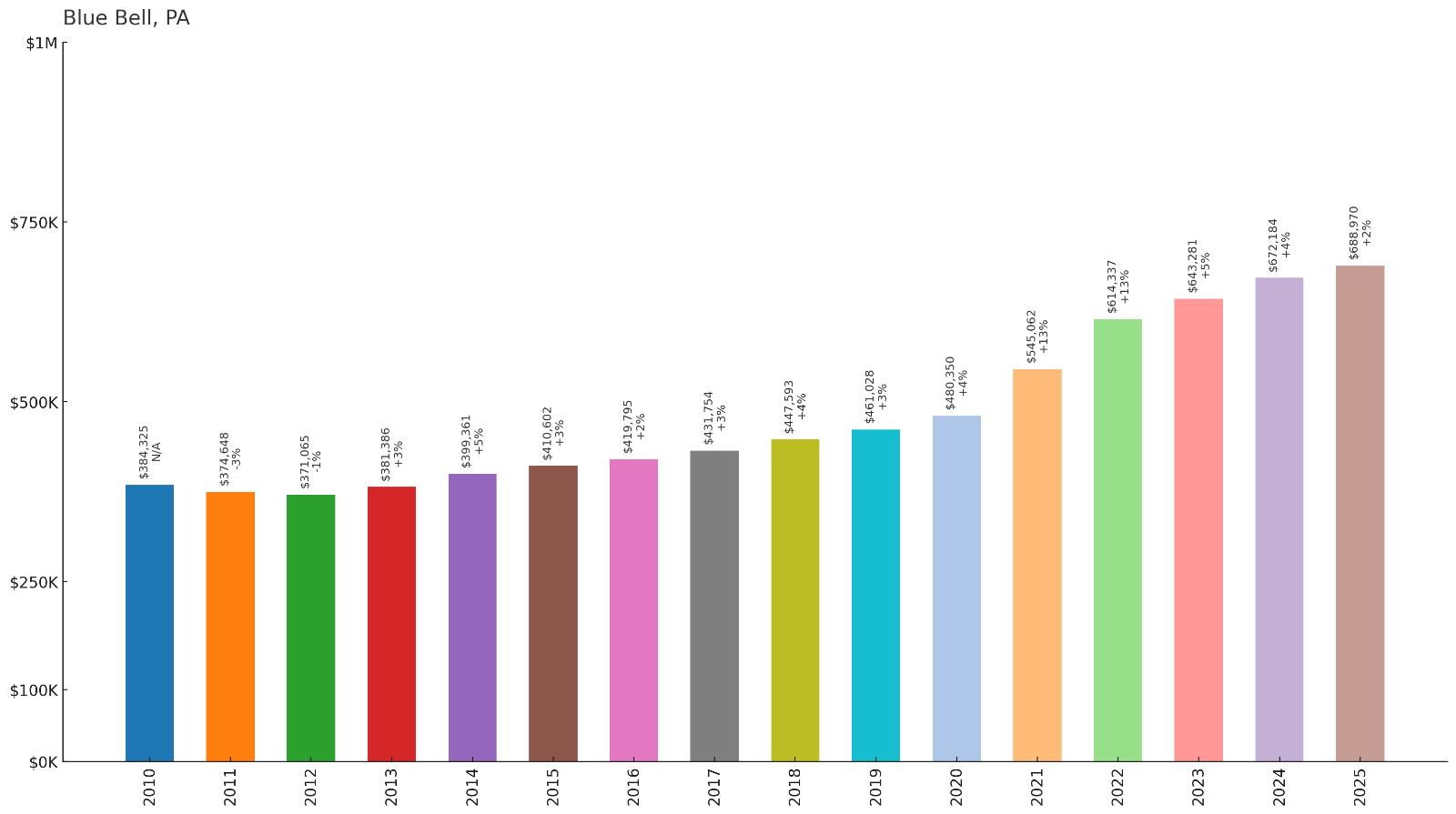
- 2010: $384,325
- 2011: $374,648
- 2012: $371,065
- 2013: $381,386
- 2014: $399,361
- 2015: $410,602
- 2016: $419,795
- 2017: $431,754
- 2018: $447,593
- 2019: $461,028
- 2020: $480,350
- 2021: $545,062
- 2022: $614,337
- 2023: $643,281
- 2024: $672,184
- 2025: $688,970
Blue Bell has delivered strong appreciation with a 79% increase since 2010, reaching $688,970 by 2025. The community experienced steady growth through the decade before accelerating significantly during the pandemic years. This Montgomery County location has become increasingly attractive to buyers seeking corporate convenience and suburban lifestyle.
Why Blue Bell?

Why are people willing to pay so much to live here? What’s special about it?
Blue Bell appeals to professionals and executives drawn to its concentration of corporate headquarters and business parks, creating a unique suburban environment where many residents can live close to work. The community features well-maintained neighborhoods, excellent schools through the Wissahickon School District, and convenient access to major highways. The area’s corporate presence has created a stable economic base that supports premium housing values.
The location offers an ideal balance for busy professionals, with short commutes to major employers like Merck, Unisys, and numerous pharmaceutical companies. Blue Bell’s shopping centers, restaurants, and recreational facilities cater to affluent residents who value convenience and quality. Property values reflect the premium buyers place on this rare combination of employment proximity, suburban amenities, and educational excellence.
How Blue Bell Rose to Prominence
Blue Bell’s prominence grew from its transformation in the mid-20th century from a rural crossroads community to a major corporate center. Named after the Blue Bell Inn, a colonial-era tavern that served travelers along the Skippack Pike, the area remained largely agricultural until after World War II. The construction of major highways and the availability of large tracts of developable land attracted corporate relocations from Philadelphia.
The establishment of major corporate campuses, particularly pharmaceutical and technology companies, created a unique suburban employment center that attracted both businesses and residential development. This corporate concentration generated high-paying jobs that supported premium housing markets while maintaining suburban character. Blue Bell successfully balanced commercial development with residential quality of life, creating the business-friendly environment that continues to drive property values.
3 Interesting Tidbits
1. Corporate Capital – Blue Bell hosts more Fortune 500 company headquarters per square mile than most Pennsylvania communities, creating a unique concentration of executive housing demand.
2. Historic Inn – The original Blue Bell Inn, dating to the 1740s, still operates as a restaurant and represents the community’s colonial heritage amid modern corporate development.
3. Pharmaceutical Hub – The area’s concentration of pharmaceutical and biotech companies has created a specialized employment cluster that supports high-end housing demand.
20. Richboro – 73% Home Price Increase Since 2010
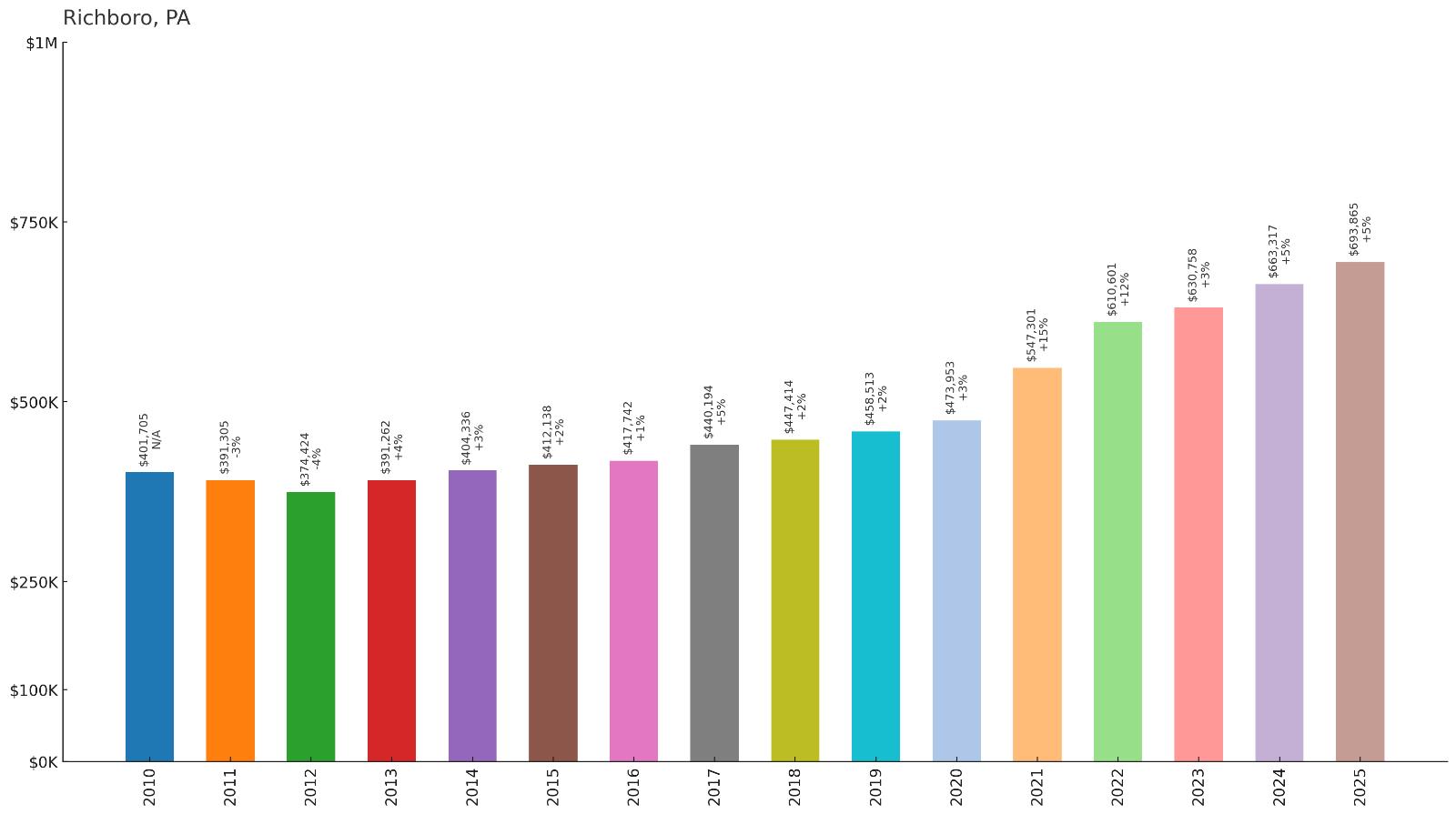
- 2010: $401,705
- 2011: $391,305
- 2012: $374,424
- 2013: $391,262
- 2014: $404,336
- 2015: $412,138
- 2016: $417,742
- 2017: $440,194
- 2018: $447,414
- 2019: $458,513
- 2020: $473,953
- 2021: $547,301
- 2022: $610,601
- 2023: $630,758
- 2024: $663,317
- 2025: $693,865
Richboro has shown solid appreciation with a 73% increase since 2010, reaching $693,865 in 2025. The community weathered some early decade fluctuations before establishing consistent growth, with particularly strong gains during the pandemic years. This Bucks County location has attracted families seeking excellent schools and suburban stability.
Why Richboro?
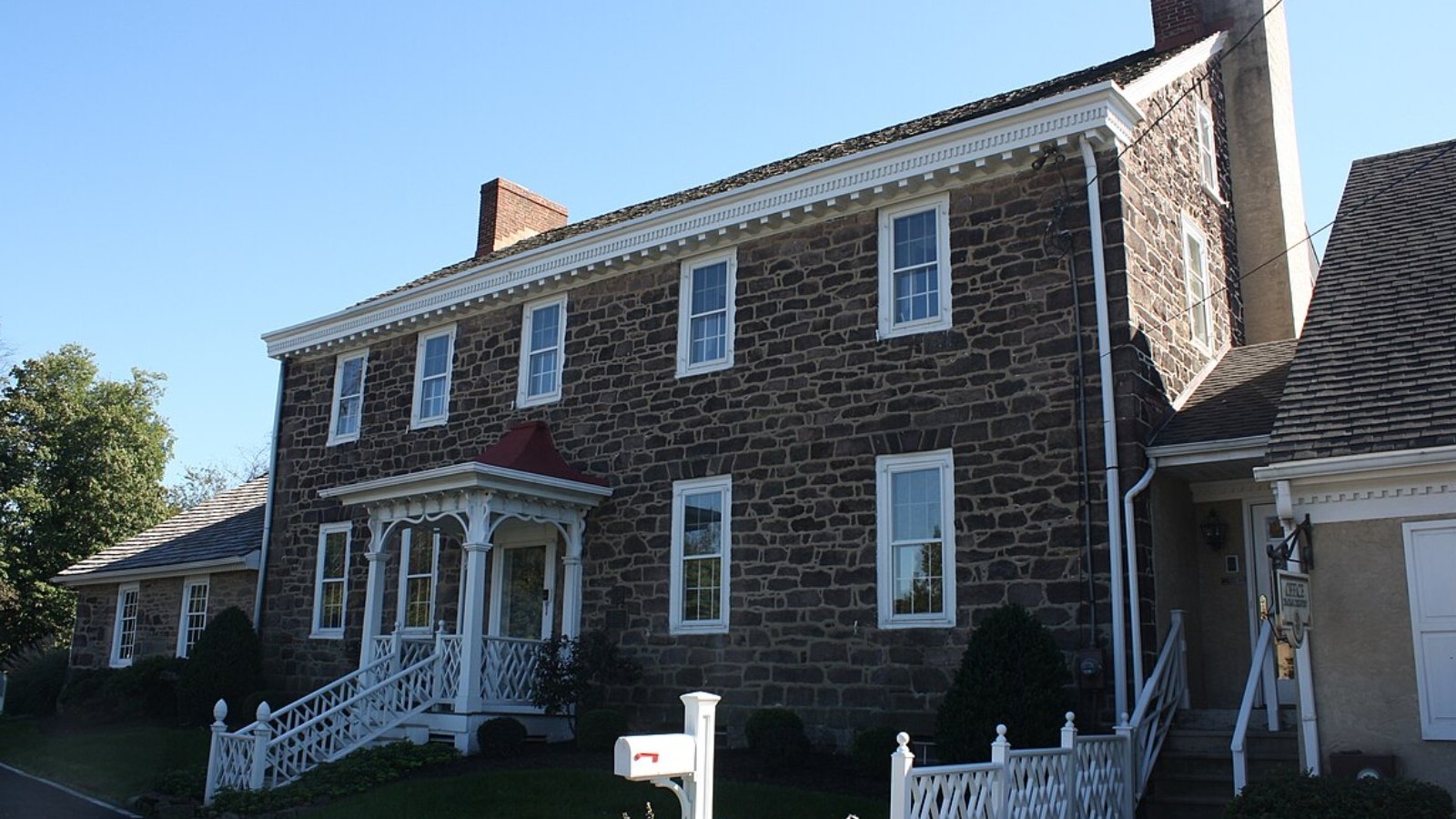
Why are people willing to pay so much to live here? What’s special about it?
Richboro attracts families primarily for its access to outstanding school districts, including both Council Rock and Central Bucks systems depending on exact location. The community offers well-established neighborhoods with mature landscaping, sidewalks, and a strong sense of safety that appeals to parents. The area’s central Bucks County location provides convenient access to both Philadelphia employment centers and New Jersey job markets.
The community features numerous parks and recreational facilities, including the popular Churchville Nature Center and various township parks that provide extensive outdoor opportunities. Richboro’s blend of established housing stock and newer developments appeals to diverse buyer preferences while maintaining consistent suburban character. Property values reflect the premium families place on educational excellence and community stability.
How Richboro Rose to Prominence
Richboro’s prominence developed from its roots as a small crossroads community in central Bucks County, where early settlers established farms and small businesses along major transportation routes. The area remained largely agricultural through the mid-20th century, with the name reflecting the rich soil that supported successful farming operations. Post-World War II suburban expansion transformed farmland into residential developments.
The community’s growth accelerated as excellent school districts attracted families seeking educational quality, while improved highways made commuting to Philadelphia and other employment centers more feasible. Richboro successfully balanced residential development with preservation of community character, creating the stable suburban environment that continues to appeal to homebuyers seeking family-friendly living.
3 Interesting Tidbits
1. School Choice – Depending on exact location, Richboro residents can access either the Council Rock or Central Bucks school districts, both ranked among Pennsylvania’s finest.
2. Nature Access – The community features easy access to Churchville Nature Center’s 160 acres of woodlands, meadows, and walking trails.
3. Historic Preservation – Several historic stone houses and barns throughout the area preserve connections to the community’s agricultural heritage.
19. Dresher – 60% Home Price Increase Since 2016
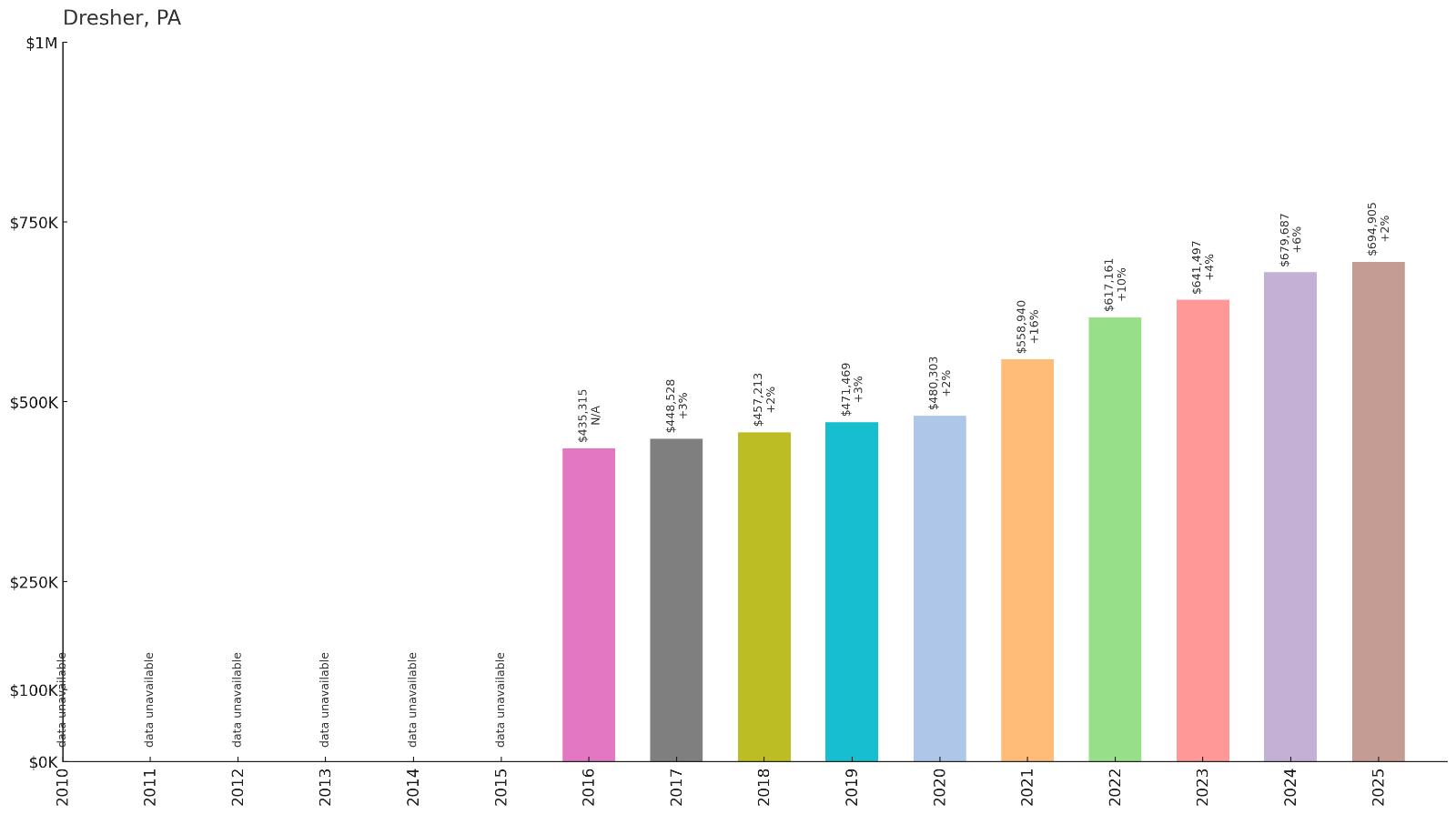
- 2010: N/A
- 2011: N/A
- 2012: N/A
- 2013: N/A
- 2014: N/A
- 2015: N/A
- 2016: $435,315
- 2017: $448,528
- 2018: $457,213
- 2019: $471,469
- 2020: $480,303
- 2021: $558,940
- 2022: $617,161
- 2023: $641,497
- 2024: $679,687
- 2025: $694,905
Dresher has achieved strong growth with a 60% increase since 2016, reaching $694,905 by 2025. The community showed steady appreciation through the late 2010s before accelerating significantly during the pandemic years. This Montgomery County location has attracted buyers seeking suburban excellence with convenient access to employment centers.
Why Dresher?
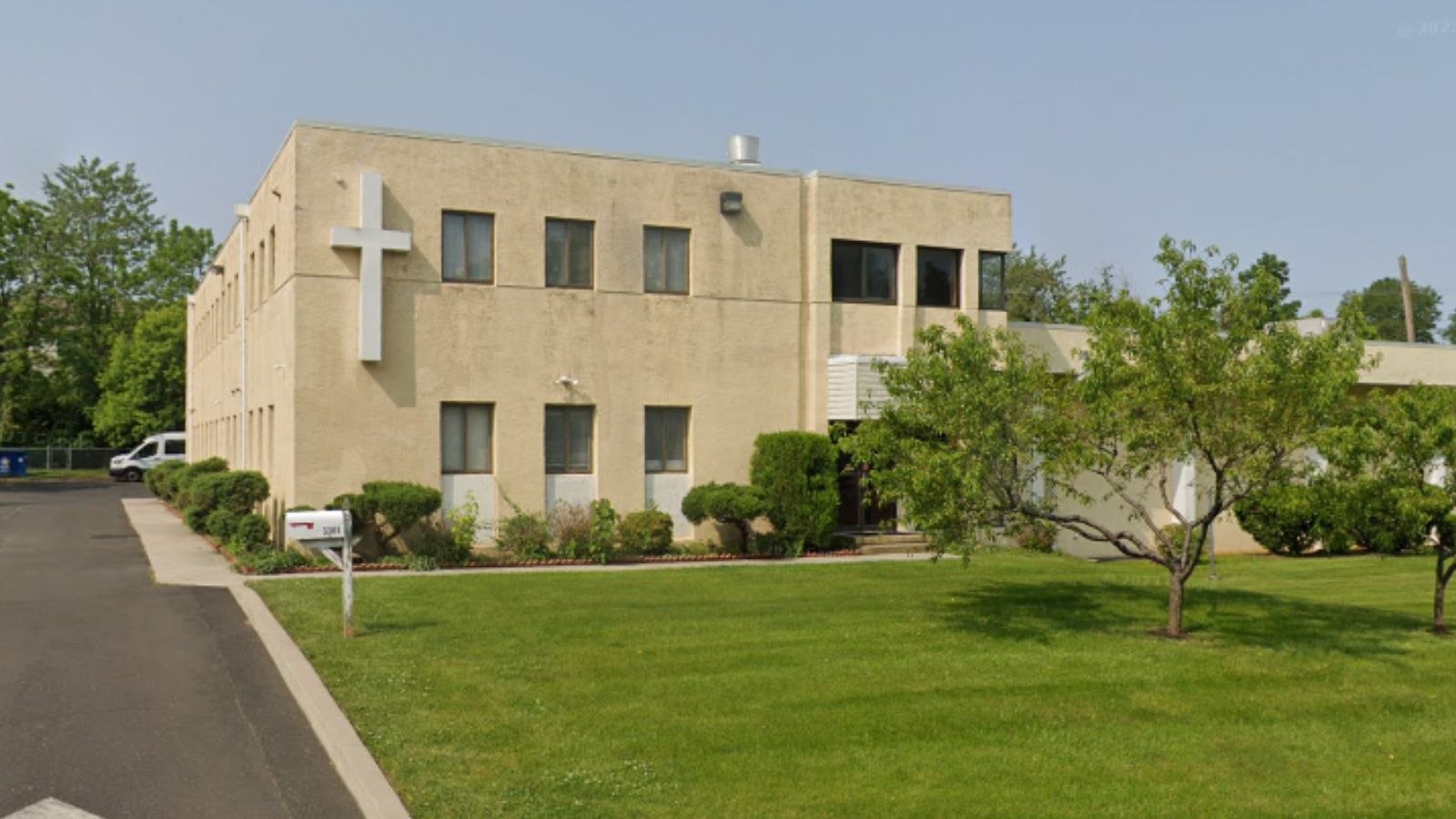
Why are people willing to pay so much to live here? What’s special about it?
Dresher appeals to affluent families seeking the perfect balance of suburban tranquility and urban accessibility, located in Upper Dublin Township with access to highly-rated schools and well-maintained neighborhoods. The community features tree-lined streets, larger lots, and newer housing developments that attract buyers looking for modern amenities. The area’s proximity to major highways provides convenient commuting options to Philadelphia and surrounding employment centers.
The community benefits from excellent recreational facilities including parks, golf courses, and proximity to natural areas that enhance quality of life. Dresher’s location within the Upper Dublin School District adds significant appeal for families prioritizing education. Property values reflect the premium buyers place on this combination of suburban lifestyle, educational quality, and convenient location.
How Dresher Rose to Prominence
Dresher’s prominence grew from its development as a planned suburban community in Montgomery County’s transformation from rural to suburban landscape. Named after early landowner Daniel Dresher, the area remained largely agricultural until post-World War II suburban expansion brought residential development to the region. The community’s location along major transportation corridors made it attractive for suburban development.
The establishment of quality school districts and the development of corporate campuses in nearby areas created employment opportunities that supported residential growth. Dresher successfully attracted middle and upper-middle-class families seeking newer suburban amenities while maintaining convenient access to Philadelphia employment opportunities.
3 Interesting Tidbits
1. School Excellence – Upper Dublin High School consistently ranks among Pennsylvania’s top schools with exceptional college preparation programs and extracurricular offerings.
2. Golf Destination – The area features several golf courses including the prestigious Philmont Country Club, adding recreational appeal for affluent residents.
3. Corporate Proximity – Dresher’s location provides easy access to major corporate centers in Fort Washington and Blue Bell, creating convenient commuting options.
18. Glen Mills – 84% Home Price Increase Since 2010
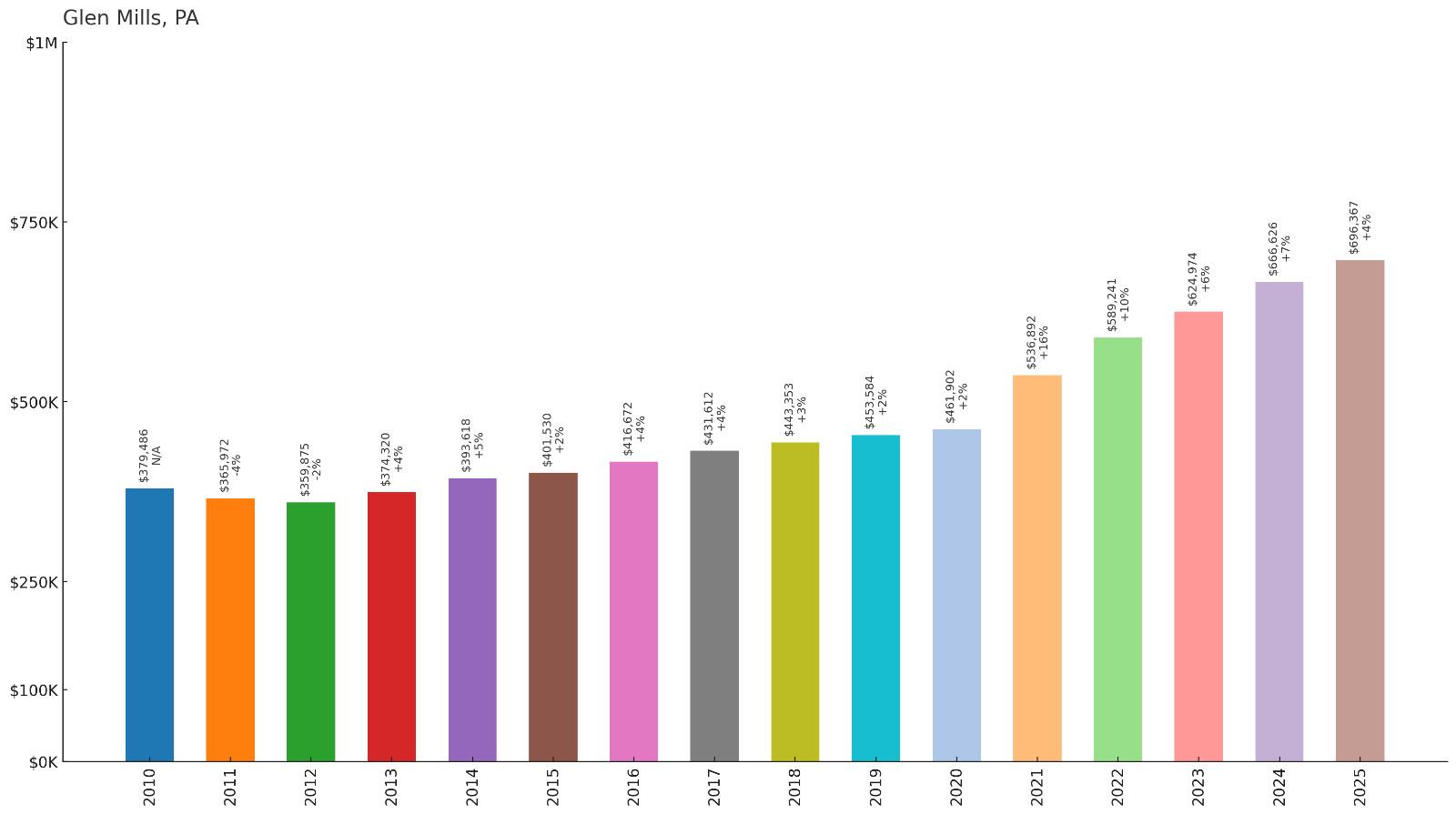
- 2010: $379,486
- 2011: $365,972
- 2012: $359,875
- 2013: $374,320
- 2014: $393,618
- 2015: $401,530
- 2016: $416,672
- 2017: $431,612
- 2018: $443,353
- 2019: $453,584
- 2020: $461,902
- 2021: $536,892
- 2022: $589,241
- 2023: $624,974
- 2024: $666,626
- 2025: $696,367
Glen Mills has delivered impressive returns with an 84% increase since 2010, reaching $696,367 in 2025. The community showed steady appreciation through the decade before accelerating significantly during the pandemic years. This Delaware County location has become increasingly popular with families seeking excellent schools and historic charm.
Why Glen Mills?
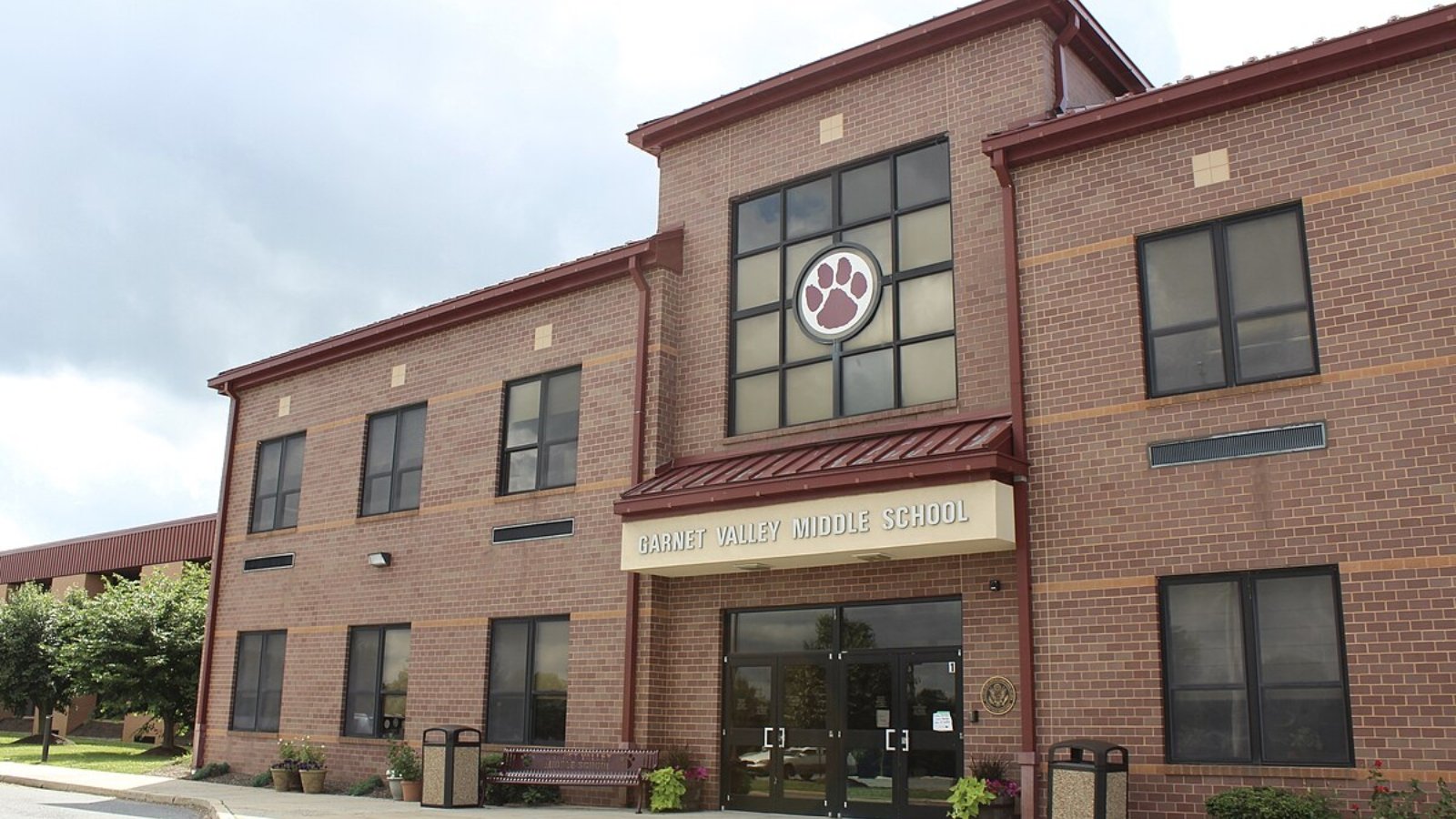
Why are people willing to pay so much to live here? What’s special about it?
Glen Mills attracts buyers seeking a rare combination of historical significance and modern suburban amenities, centered around the historic Glen Mills Schools campus and its beautiful stone architecture. The community features tree-lined streets, mature neighborhoods, and access to the highly-rated Garnet Valley School District. Families particularly value the area’s safety, community involvement, and proximity to both Philadelphia and Wilmington employment centers.
The location offers abundant recreational opportunities including nearby state parks, golf courses, and the scenic Brandywine Valley region known for its cultural attractions and natural beauty. Glen Mills’ blend of historical character and suburban convenience appeals to buyers who want more than typical subdivisions. Property values reflect the premium placed on this unique combination of history, education, and quality of life.
How Glen Mills Rose to Prominence
Glen Mills’ prominence grew from its establishment as the site of the Glen Mills Schools in 1826, originally founded as a reform school and later becoming a renowned residential treatment center for troubled youth. The institution’s impressive stone buildings and extensive campus created a distinctive architectural anchor that shaped the community’s character. The surrounding area developed as staff housing and support services clustered around this major institution.
As suburban development reached Delaware County, Glen Mills became increasingly attractive to families drawn by its combination of historical character and excellent schools. The community successfully balanced preservation of its historic core with modern residential development, creating an appealing blend of old and new that continues to attract homebuyers seeking character and convenience.
3 Interesting Tidbits
1. Historic Campus – The Glen Mills Schools campus features stunning 19th-century stone architecture that creates one of Pennsylvania’s most distinctive institutional landscapes.
2. Brandywine Beauty – The community sits in the scenic Brandywine Valley, known for its rolling hills, historic sites, and cultural attractions including Longwood Gardens.
3. Dual State Access – Glen Mills provides convenient access to both Pennsylvania and Delaware employment centers, expanding job market opportunities for residents.
17. Chadds Ford – 4% Home Price Increase Since 2024
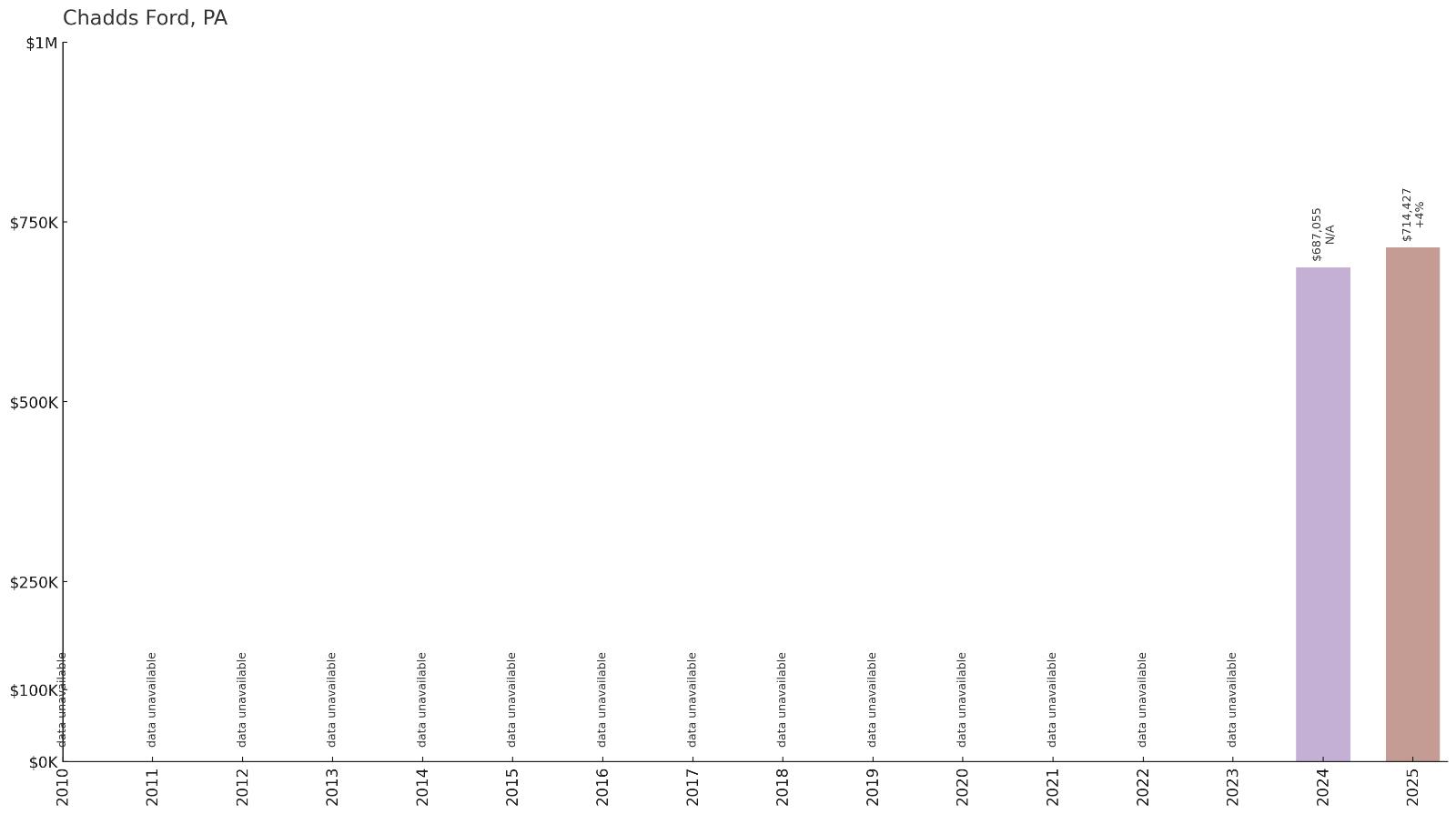
- 2010: N/A
- 2011: N/A
- 2012: N/A
- 2013: N/A
- 2014: N/A
- 2015: N/A
- 2016: N/A
- 2017: N/A
- 2018: N/A
- 2019: N/A
- 2020: N/A
- 2021: N/A
- 2022: N/A
- 2023: N/A
- 2024: $687,055
- 2025: $714,427
Chadds Ford achieved a modest 4% increase from 2024 to 2025, reaching $714,427 in median home value. This Delaware County community continues to attract buyers drawn to its rich history and cultural significance. The steady appreciation reflects ongoing demand for this prestigious area despite limited data availability.
Why Chadds Ford?
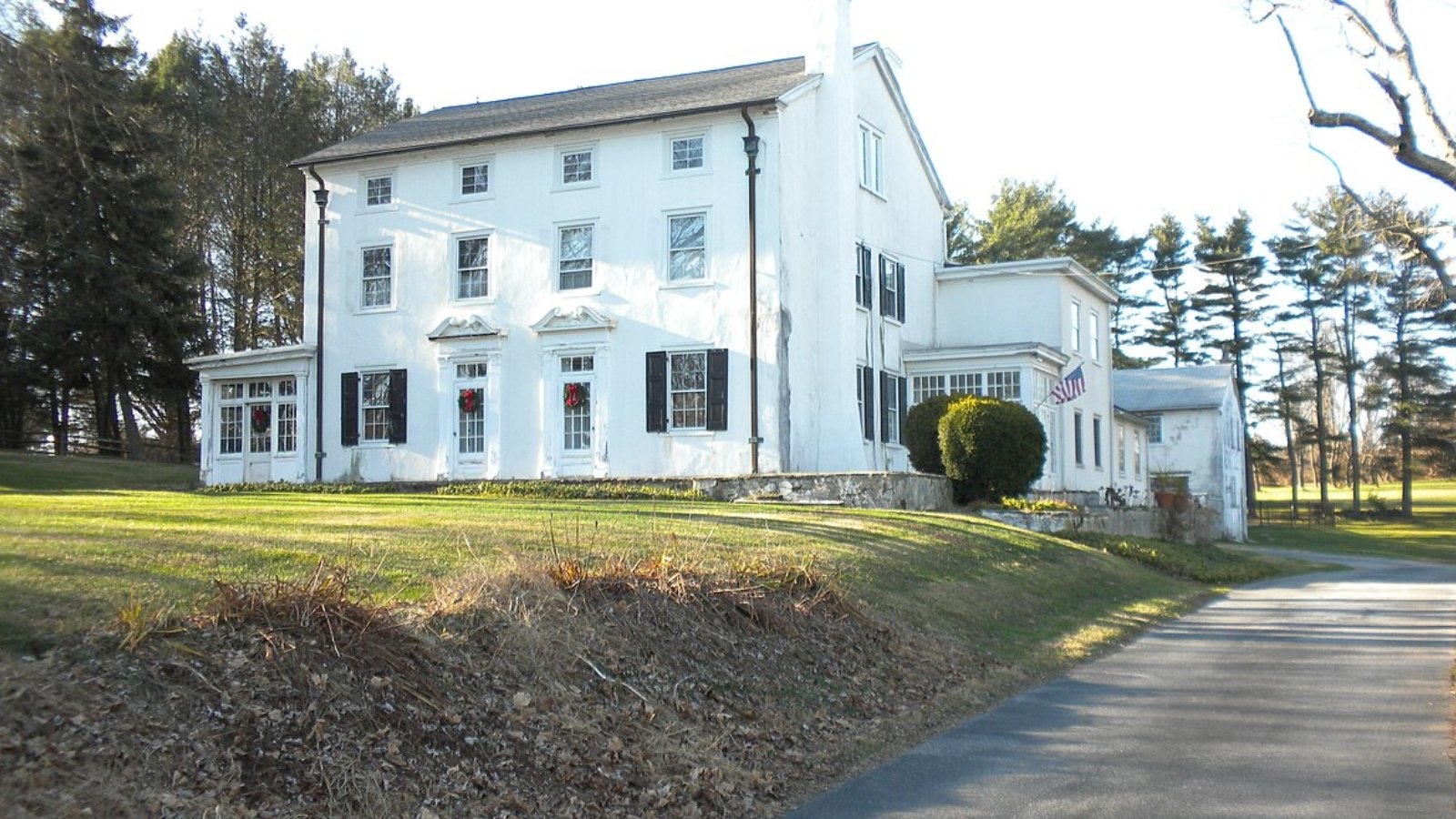
Why are people willing to pay so much to live here? What’s special about it?
Chadds Ford commands premium prices as one of Pennsylvania’s most culturally significant communities, home to the Brandywine River Museum and closely associated with the Wyeth family of artists. The area features rolling countryside, historic stone houses, and preserved battlefields that create an unmatched combination of natural beauty and historical importance. Buyers are drawn to the community’s artistic heritage and the prestige associated with living in this culturally renowned location.
The community offers proximity to world-class cultural attractions including Longwood Gardens and Winterthur Museum while maintaining a rural character that feels worlds away from suburban development pressures. Chadds Ford’s location in the heart of the Brandywine Valley provides easy access to Philadelphia and Wilmington employment centers. Property values reflect the premium buyers place on this rare combination of culture, history, and natural beauty.
How Chadds Ford Rose to Prominence
Chadds Ford’s prominence began with its role in the Revolutionary War, serving as the site of the Battle of Brandywine in 1777, where George Washington’s forces faced British troops under General Howe. The community developed around the historic ford crossing of the Brandywine Creek, which gave it strategic and commercial importance. Early mills and taverns served travelers and local residents in this fertile valley location.
The area’s transformation into a cultural destination began with the Wyeth family’s association with the region, particularly N.C. Wyeth and later his son Andrew Wyeth, whose paintings immortalized the Brandywine Valley landscape. The establishment of the Brandywine River Museum and preservation of historic sites created a unique community identity centered on art, history, and natural beauty that continues to attract affluent buyers seeking cultural sophistication.
3 Interesting Tidbits
1. Wyeth Legacy – Chadds Ford was home to three generations of Wyeth artists, with many of Andrew Wyeth’s most famous paintings depicting local landscapes and buildings.
2. Revolutionary Battlefield – The Battle of Brandywine, fought here in 1777, was the largest single-day battle of the Revolutionary War, with historic sites preserved throughout the area.
3. Museum Hub – The Brandywine River Museum houses the world’s largest collection of Wyeth family artwork, making Chadds Ford a destination for art lovers worldwide.
16. Furlong – 57% Home Price Increase Since 2016
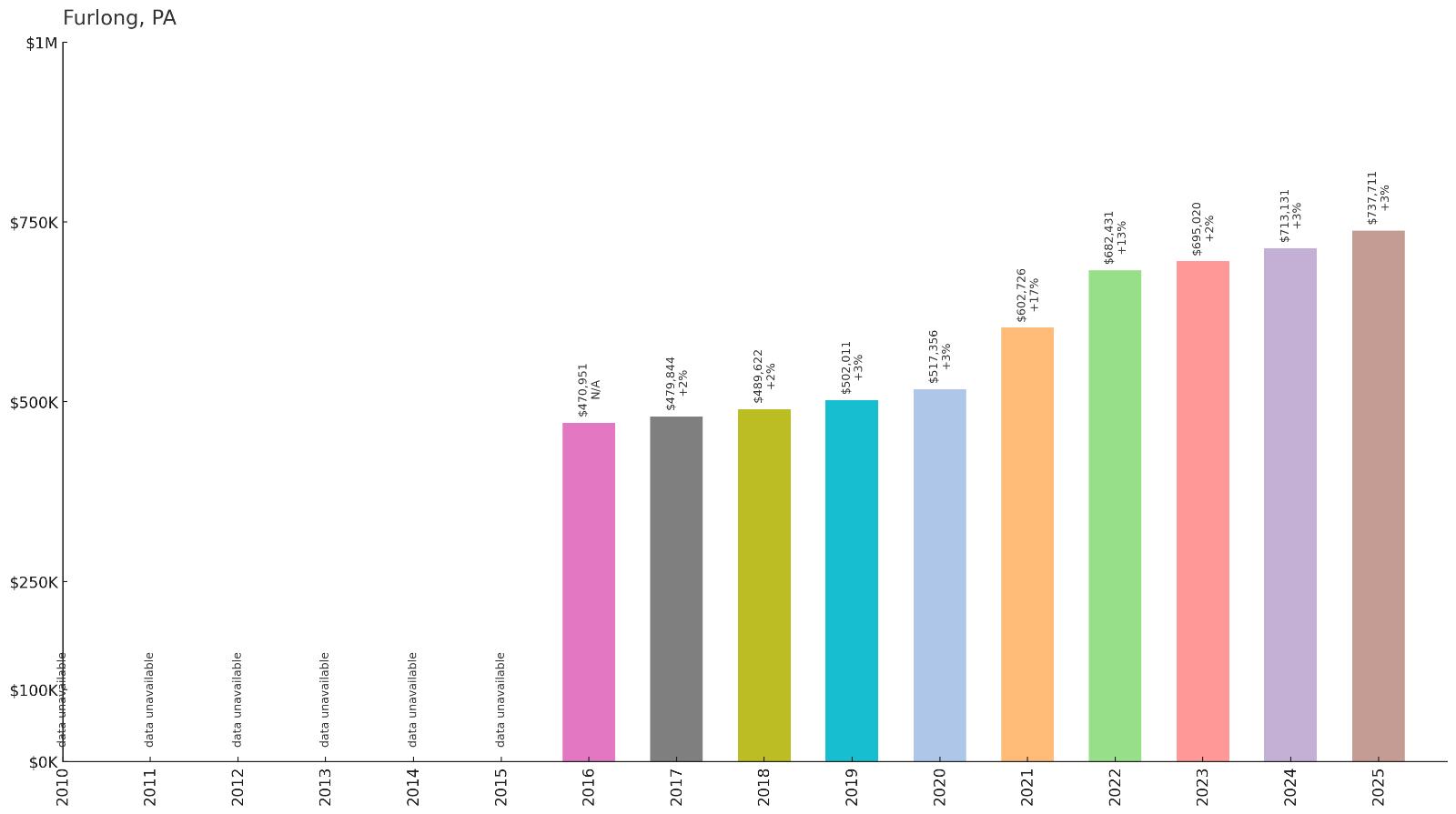
- 2010: N/A
- 2011: N/A
- 2012: N/A
- 2013: N/A
- 2014: N/A
- 2015: N/A
- 2016: $470,951
- 2017: $479,844
- 2018: $489,622
- 2019: $502,011
- 2020: $517,356
- 2021: $602,726
- 2022: $682,431
- 2023: $695,020
- 2024: $713,131
- 2025: $737,711
Furlong has achieved solid growth with a 57% increase since 2016, reaching $737,711 by 2025. The community showed steady appreciation through the late 2010s before accelerating during the pandemic years. This Bucks County location has attracted buyers seeking rural character with suburban conveniences.
Why Furlong?
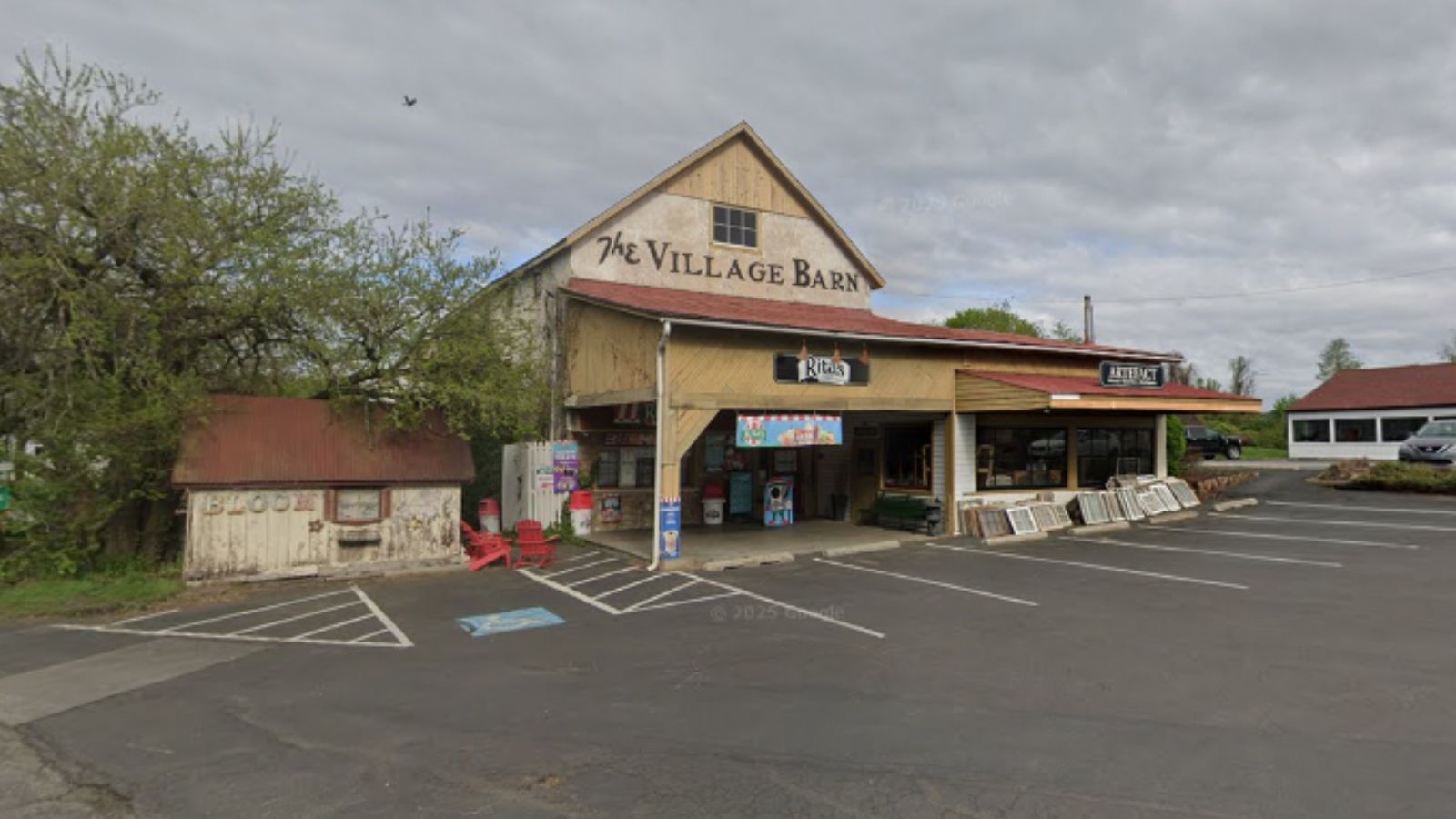
Why are people willing to pay so much to live here? What’s special about it?
Furlong appeals to buyers seeking a rural lifestyle with easy access to urban amenities, offering large lots, custom homes, and a peaceful setting in northern Bucks County. The community attracts families who value the highly-rated Central Bucks School District while wanting more space and privacy than typical suburban developments provide. The area’s rolling hills, horse farms, and preserved open space create a distinctive character that feels far removed from urban pressures.
The location provides reasonable access to both Philadelphia and New York employment markets while maintaining a country atmosphere with numerous recreational opportunities. Furlong’s equestrian-friendly zoning and agricultural preservation efforts appeal to buyers seeking authentic rural living. Property values reflect the premium placed on this increasingly rare combination of space, schools, and semi-rural lifestyle.
How Furlong Rose to Prominence
Furlong’s prominence grew from its agricultural heritage in Bucks County’s fertile northern reaches, where dairy farming and horse breeding established the area’s rural character. Originally settled by Quakers and German immigrants in the 18th century, the community remained largely agricultural through most of the 20th century. The area’s location along historic transportation routes connected it to Philadelphia markets while preserving its rural identity.
As suburban development pressure reached northern Bucks County, Furlong became increasingly attractive to buyers seeking larger properties and rural settings. The community successfully balanced new development with agricultural preservation through large-lot zoning and open space requirements, creating the blend of rural character and modern amenities that continues to attract affluent homebuyers.
3 Interesting Tidbits
1. Equestrian Excellence – Furlong maintains numerous horse farms, training facilities, and riding trails that preserve the area’s agricultural traditions and appeal to horse enthusiasts.
2. Historic Architecture – Many properties feature restored 18th and 19th-century stone farmhouses and barns that showcase Pennsylvania’s rural architectural heritage.
3. Agricultural Preservation – Bucks County’s farmland preservation program has protected thousands of acres around Furlong, maintaining the rural character that drives property values.
15. Chester Springs – 78% Home Price Increase Since 2010
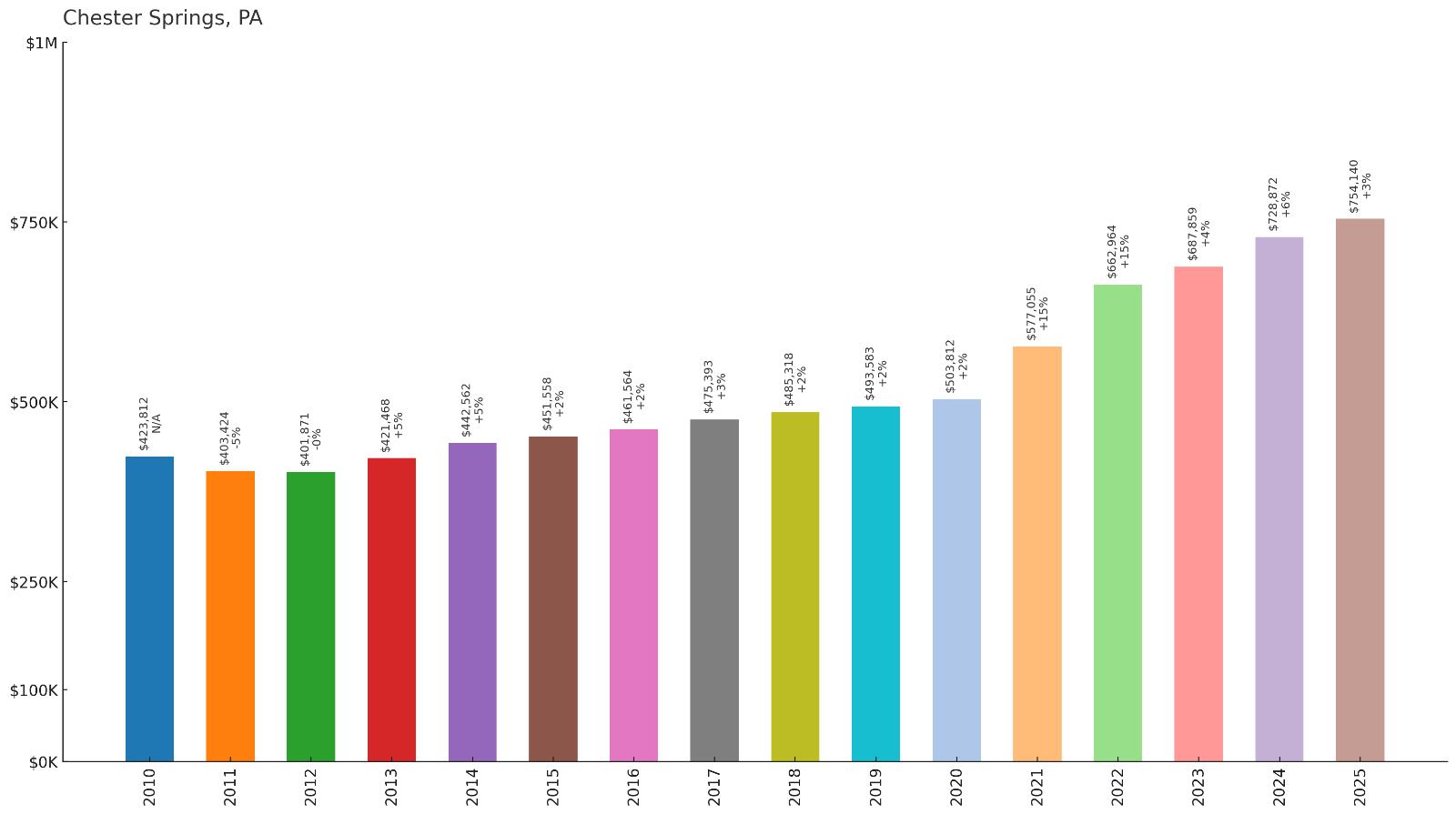
- 2010: $423,812
- 2011: $403,424
- 2012: $401,871
- 2013: $421,468
- 2014: $442,562
- 2015: $451,558
- 2016: $461,564
- 2017: $475,393
- 2018: $485,318
- 2019: $493,583
- 2020: $503,812
- 2021: $577,055
- 2022: $662,964
- 2023: $687,859
- 2024: $728,872
- 2025: $754,140
Chester Springs has delivered excellent returns with a 78% increase since 2010, reaching $754,140 by 2025. The community experienced steady growth through the decade before accelerating significantly during the pandemic years. This Chester County location has become increasingly popular with buyers seeking rural elegance and proximity to employment centers.
Why Chester Springs?
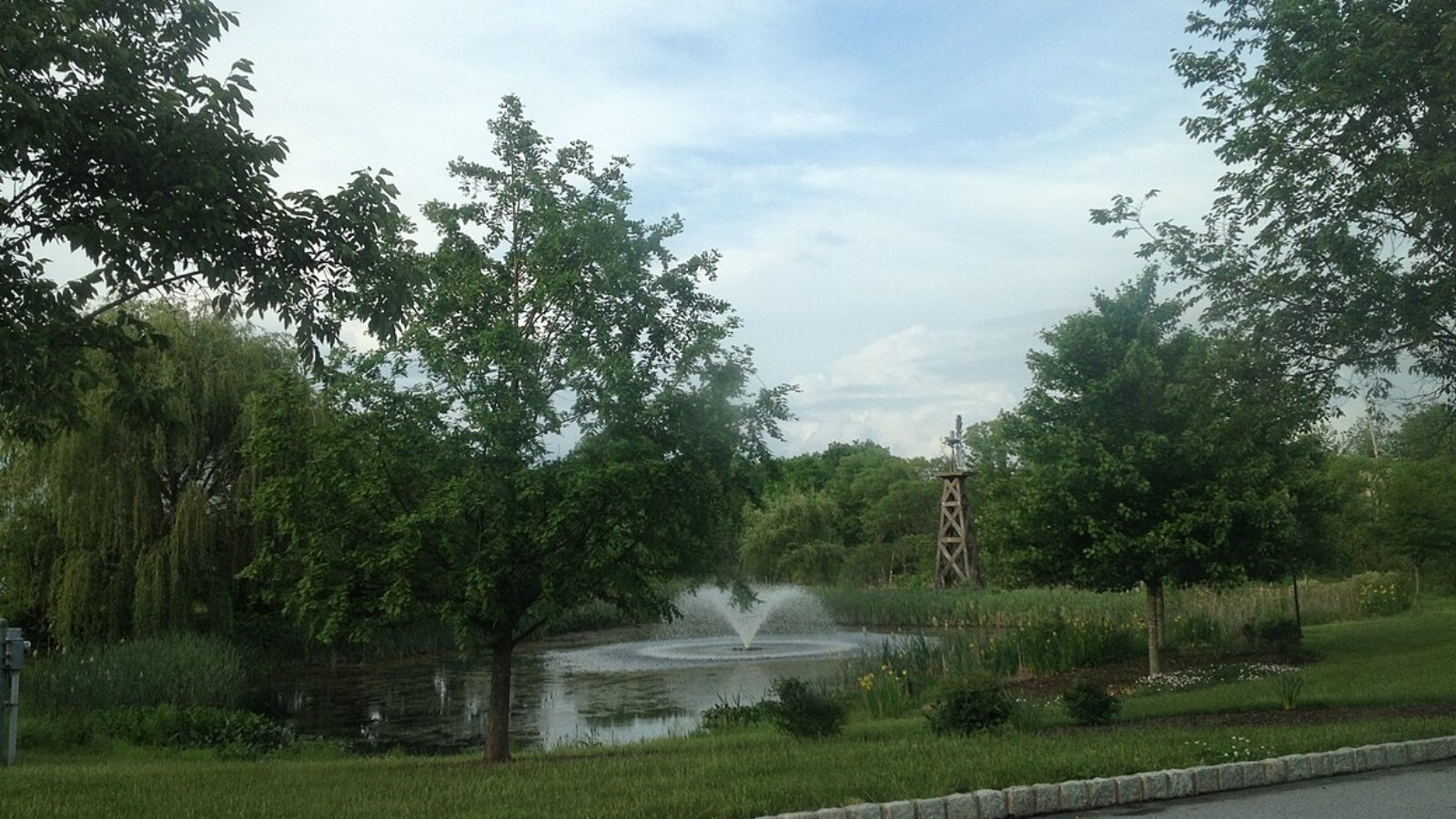
Why are people willing to pay so much to live here? What’s special about it?
Chester Springs attracts affluent buyers seeking a sophisticated country lifestyle, offering large estates, custom homes, and preserved rural character in one of Chester County’s most desirable areas. The community features rolling hills, horse farms, and historic stone architecture that creates an atmosphere of refined rural living. Families value access to excellent schools and the area’s reputation for safety and community involvement.
The location provides convenient access to Philadelphia employment centers while maintaining a distinctly rural character with numerous recreational opportunities including parks, trails, and equestrian facilities. Chester Springs’ blend of natural beauty and upscale amenities appeals to executives and professionals seeking privacy and prestige. Property values reflect the premium buyers place on this rare combination of rural sophistication and urban accessibility.
How Chester Springs Rose to Prominence
Chester Springs’ prominence began with its natural mineral springs, which attracted visitors seeking health benefits as early as the 18th century. The area developed as a resort destination with hotels and spas catering to Philadelphia’s elite seeking respite from city life. The mineral springs gave the community its name and established its reputation as a place of natural beauty and healthful living.
As the resort era faded, Chester Springs evolved into a residential community that preserved its rural character while attracting affluent families seeking country estates. The area’s location in western Chester County provided sufficient distance from urban development pressures while maintaining accessibility to employment centers. This balance of preservation and development created the upscale rural community that continues to attract high-end buyers.
3 Interesting Tidbits
1. Mineral Springs Heritage – The historic mineral springs that gave the community its name are preserved in local parks, maintaining connections to the area’s spa resort origins.
2. Corporate Campus – Chester Springs is home to several major corporate campuses, including pharmaceutical companies that provide high-paying employment opportunities.
3. Preserved Landscapes – Extensive agricultural preservation efforts have protected the rolling farmland and scenic vistas that define the community’s rural character.
14. Fort Washington – 62% Home Price Increase Since 2016

- 2010: N/A
- 2011: N/A
- 2012: N/A
- 2013: N/A
- 2014: N/A
- 2015: N/A
- 2016: $474,105
- 2017: $479,958
- 2018: $492,448
- 2019: $510,756
- 2020: $523,205
- 2021: $613,075
- 2022: $678,858
- 2023: $703,702
- 2024: $737,164
- 2025: $766,202
Fort Washington has achieved strong growth with a 62% increase since 2016, reaching $766,202 by 2025. The community showed steady appreciation through the late 2010s before accelerating during the pandemic years. This Montgomery County location has attracted buyers seeking corporate convenience and upscale suburban living.
Why Fort Washington?
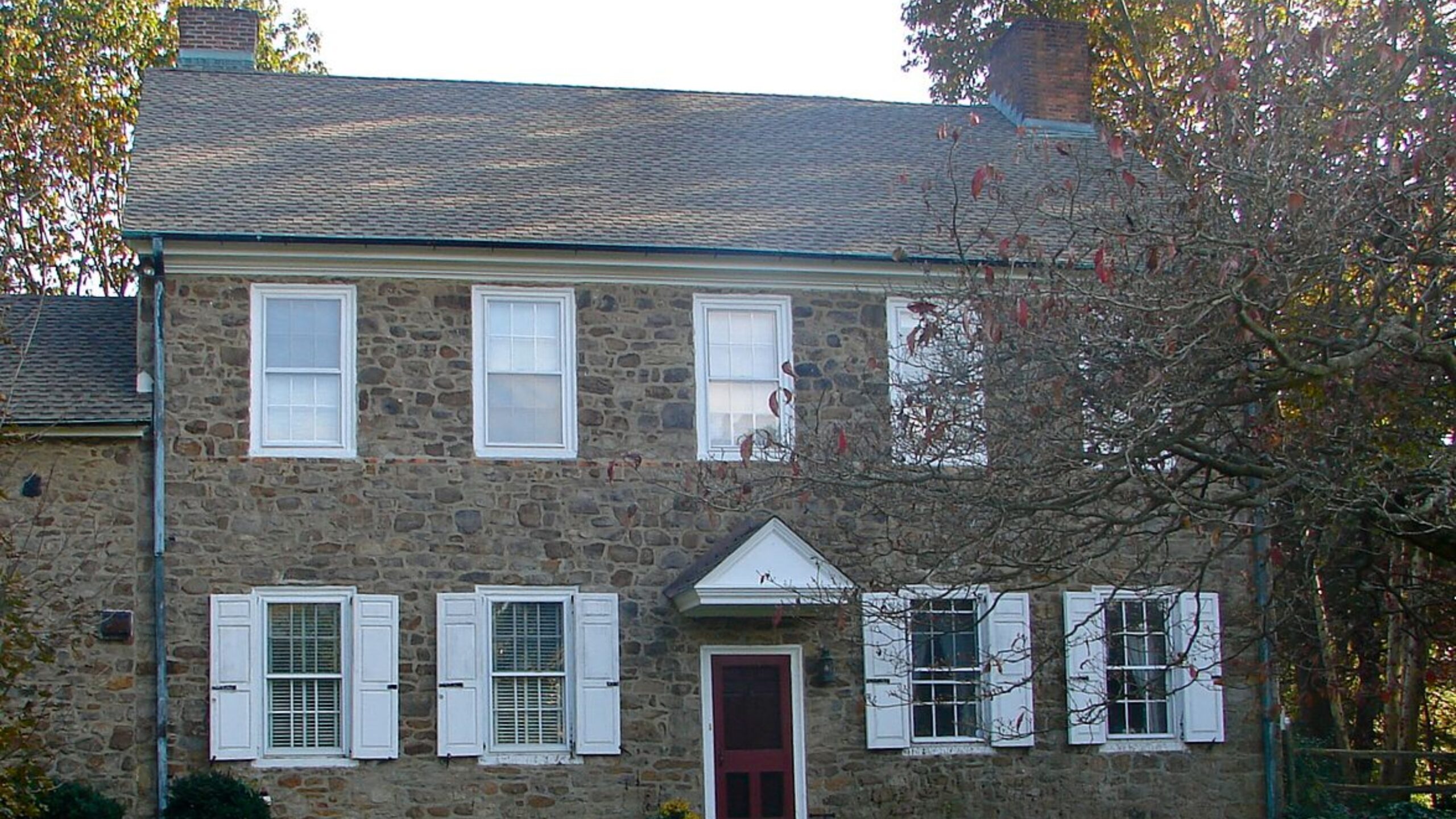
Why are people willing to pay so much to live here? What’s special about it?
Fort Washington appeals to executives and professionals drawn to its concentration of corporate headquarters and business parks, creating an ideal environment where residents can live close to high-paying employment opportunities. The community features well-established neighborhoods, excellent access to major highways, and proximity to the highly-rated Upper Dublin School District. The area’s corporate presence has created economic stability that supports premium housing values.
The location offers an exceptional balance for busy professionals, with short commutes to major employers in pharmaceutical, technology, and financial services industries. Fort Washington’s shopping centers, restaurants, and recreational facilities cater to affluent residents who value convenience and quality. Property values reflect the premium buyers place on this unique combination of employment proximity, suburban amenities, and educational excellence.
How Fort Washington Rose to Prominence
Fort Washington’s prominence began with its historical significance as the site of Continental Army encampments during the Revolutionary War, where George Washington’s troops established winter quarters in 1777. The area’s strategic location and transportation connections made it attractive for both military and later commercial purposes. The community’s name honors this Revolutionary War heritage and Washington’s presence in the area.
The transformation into a modern corporate center began in the mid-20th century when major companies relocated from Philadelphia to suburban campuses offering more space and modern facilities. Fort Washington’s location along major highways and availability of large developable parcels attracted corporate headquarters, particularly in pharmaceutical and technology sectors. This corporate concentration created high-paying employment that supported premium residential development.
3 Interesting Tidbits
1. Revolutionary Heritage – Fort Washington State Park preserves the site where Continental Army troops were stationed during the harsh winter of 1777-1778.
2. Corporate Concentration – The area hosts numerous Fortune 500 company offices, creating one of the region’s highest concentrations of executive-level employment.
3. Transportation Hub – Fort Washington’s location at the intersection of major highways provides exceptional access to Philadelphia, New York, and regional employment centers.
13. Newtown Square – 3% Home Price Increase Since 2024

- 2010: N/A
- 2011: N/A
- 2012: N/A
- 2013: N/A
- 2014: N/A
- 2015: N/A
- 2016: N/A
- 2017: N/A
- 2018: N/A
- 2019: N/A
- 2020: N/A
- 2021: N/A
- 2022: N/A
- 2023: N/A
- 2024: $757,767
- 2025: $777,348
Newtown Square posted a modest 3% gain from 2024 to 2025, reaching $777,348 in median home value. This Delaware County community continues to attract buyers with its combination of suburban amenities and proximity to employment centers. The steady appreciation reflects ongoing demand despite limited historical data availability.
Why Newtown Square?
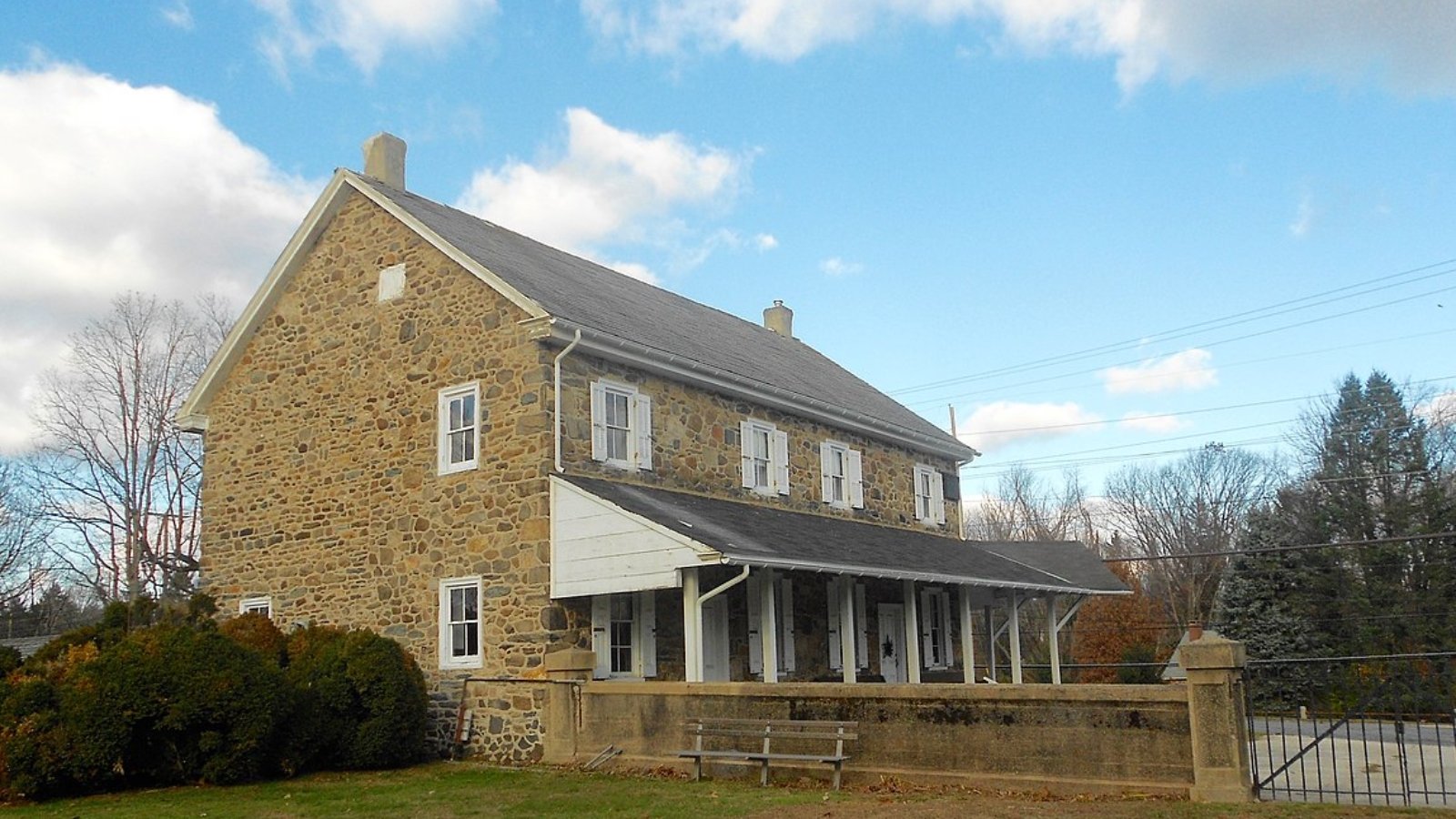
Why are people willing to pay so much to live here? What’s special about it?
Newtown Square commands premium prices as an established suburban community offering large lots, mature neighborhoods, and convenient access to both Philadelphia and corporate centers in Chester County. The area attracts affluent families seeking a suburban lifestyle with excellent schools and recreational amenities. The community’s location provides easy access to major highways while maintaining a residential character that appeals to executives and professionals.
The area features numerous parks, golf courses, and recreational facilities that enhance quality of life for residents willing to pay premium prices for suburban excellence. Newtown Square’s proximity to major employment centers combined with its established neighborhoods creates sustained demand from buyers seeking stability and convenience. Property values reflect the premium placed on this combination of location, amenities, and suburban character.
How Newtown Square Rose to Prominence
Newtown Square’s prominence developed from its origins as a crossroads community in Delaware County, where early transportation routes created a natural gathering point for commerce and settlement. The area remained largely agricultural until post-World War II suburban expansion transformed farmland into residential developments. The community’s central location made it attractive for suburban development as Philadelphia’s metropolitan area expanded westward.
The establishment of major corporate campuses and business parks in nearby areas created employment opportunities that supported residential growth and attracted affluent families. Newtown Square successfully balanced development with preservation of green space and community character, creating the stable suburban environment that continues to appeal to homebuyers seeking family-friendly living with convenient access to employment centers.
3 Interesting Tidbits
1. Corporate Gateway – Newtown Square serves as a residential hub for executives working in nearby corporate centers including King of Prussia and West Chester.
2. Recreation Central – The community features multiple golf courses and country clubs that cater to affluent residents and add to the area’s prestige.
3. Historic Preservation – Several historic sites and buildings throughout the area preserve connections to the community’s colonial and agricultural heritage.
12. Malvern – 76% Home Price Increase Since 2010
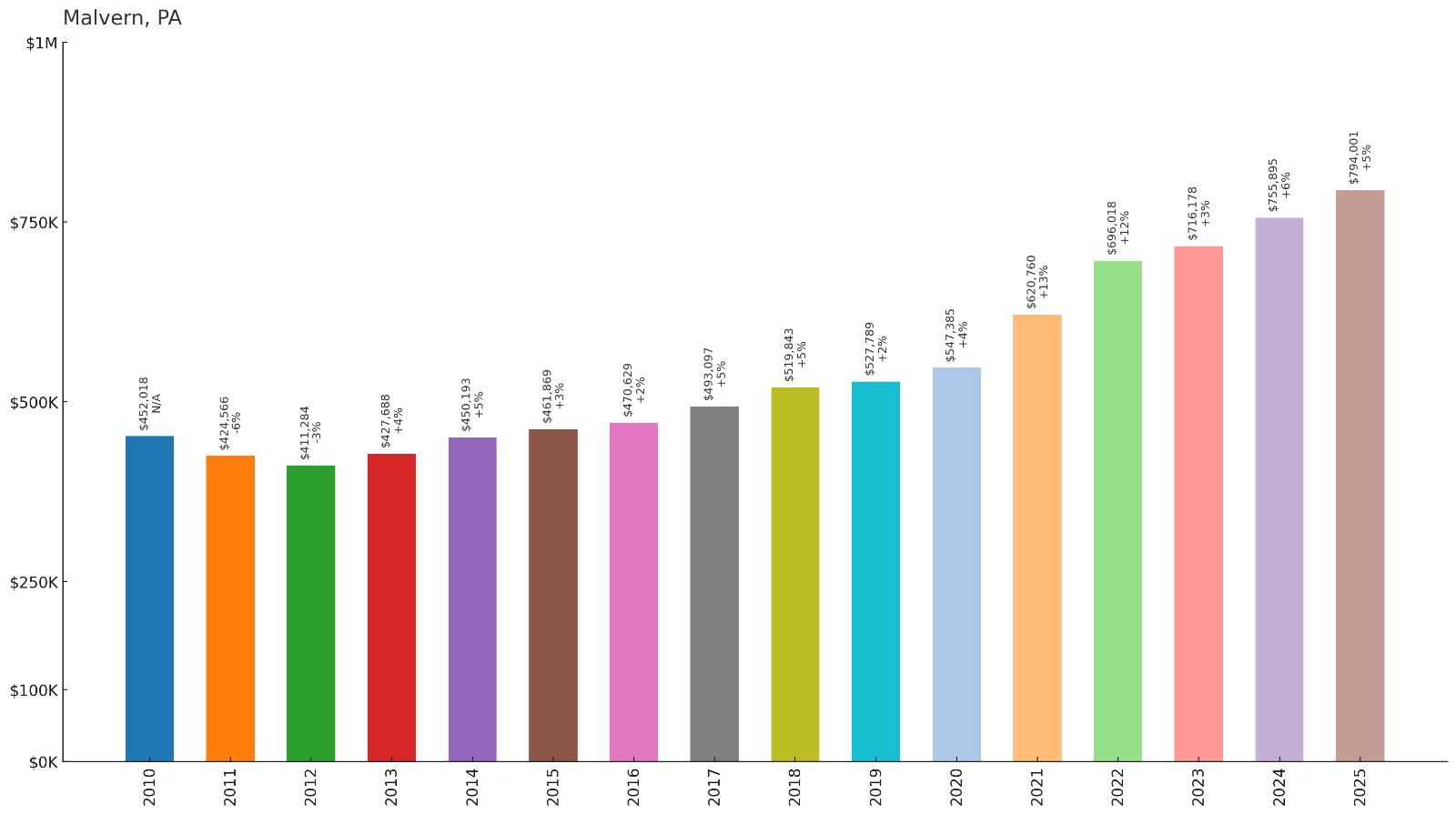
- 2010: $452,018
- 2011: $424,566
- 2012: $411,284
- 2013: $427,688
- 2014: $450,193
- 2015: $461,869
- 2016: $470,629
- 2017: $493,097
- 2018: $519,843
- 2019: $527,789
- 2020: $547,385
- 2021: $620,760
- 2022: $696,018
- 2023: $716,178
- 2024: $755,895
- 2025: $794,001
Malvern has delivered strong returns with a 76% increase since 2010, reaching $794,001 by 2025. The community experienced steady growth through the decade before accelerating significantly during the pandemic years. This Chester County borough has become increasingly attractive to buyers seeking small-town character with corporate convenience.
Why Malvern?
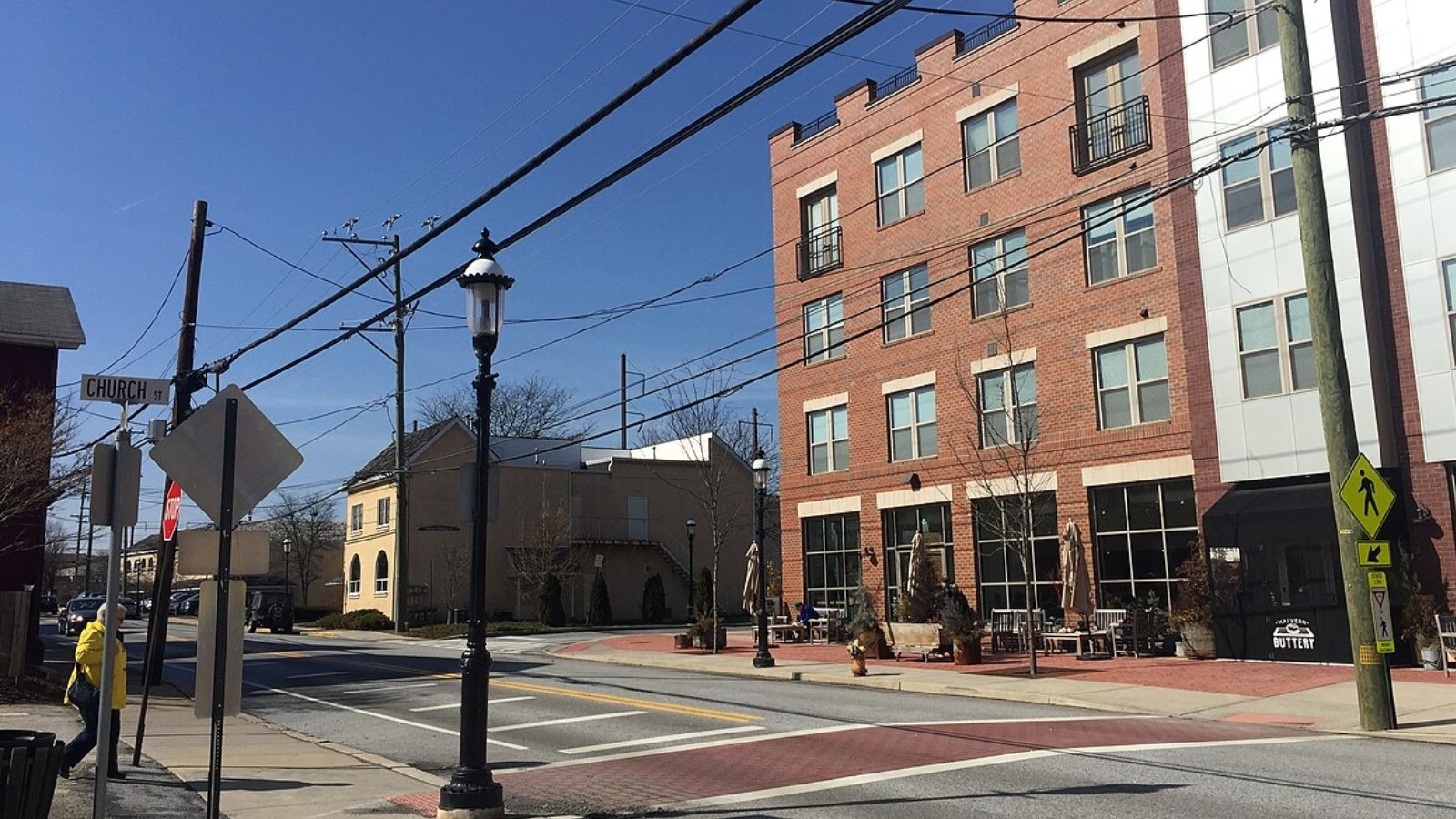
Why are people willing to pay so much to live here? What’s special about it?
Malvern appeals to professionals and executives seeking small-town charm combined with proximity to major corporate centers, offering a walkable downtown area with local shops, restaurants, and community events. The borough attracts families who value excellent schools and safe neighborhoods while wanting easy access to employment opportunities in King of Prussia and Philadelphia. The area’s historic character and community involvement create an appealing lifestyle that justifies premium housing costs.
The location provides exceptional transportation access via SEPTA’s Paoli/Thorndale Line, making Philadelphia commuting convenient while maintaining suburban character. Malvern’s blend of historic architecture, newer developments, and preserved green space appeals to diverse buyer preferences. Property values reflect the premium buyers place on this rare combination of small-town atmosphere, corporate convenience, and transportation access.
How Malvern Rose to Prominence
Malvern’s prominence began with its establishment as a railroad town in the 1850s, when the Pennsylvania Railroad brought transportation connectivity and development opportunities to the area. Named after Malvern Hill in Virginia, the community developed around the railroad station as both a residential and commercial center. The railroad connection made it possible for residents to commute to Philadelphia while enjoying small-town living.
The town’s growth accelerated in the 20th century as corporate development in nearby areas created employment opportunities that attracted affluent residents. Malvern successfully preserved its historic downtown core while accommodating residential growth, creating the blend of character and convenience that continues to drive housing demand. The community’s incorporation as a borough helped maintain local control over development and preserve its distinctive small-town identity.
3 Interesting Tidbits
1. Railroad Heritage – Malvern’s historic train station continues to serve commuters, maintaining the transportation connection that originally established the community.
2. Corporate Neighbors – The borough’s proximity to major corporate campuses in King of Prussia and Malvern makes it highly attractive to executives and professionals.
3. Community Character – Malvern maintains an active downtown area with local businesses, restaurants, and regular community events that create strong neighborhood connections.
11. Wynnewood – 93% Home Price Increase Since 2010
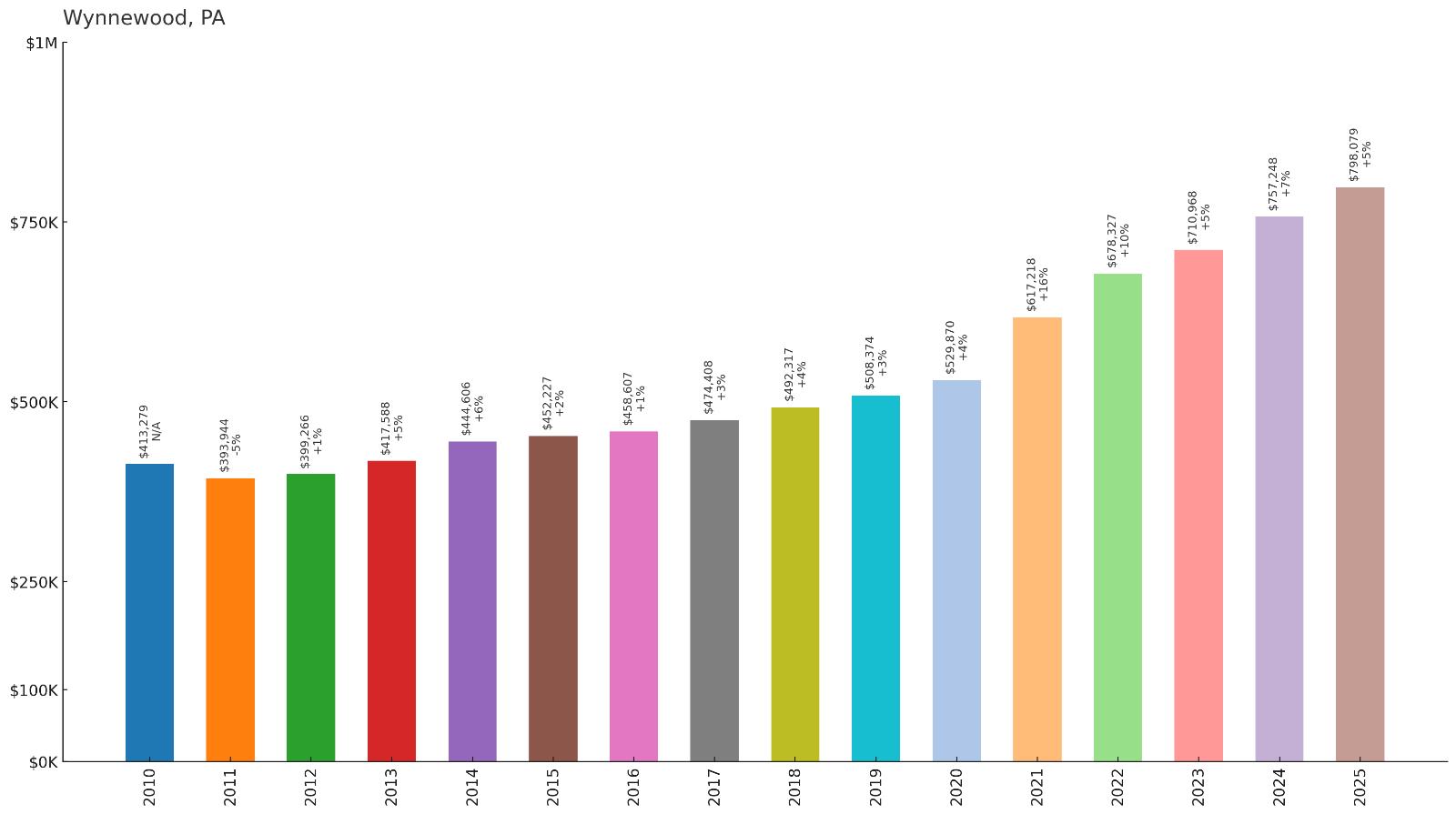
- 2010: $413,279
- 2011: $393,944
- 2012: $399,266
- 2013: $417,588
- 2014: $444,606
- 2015: $452,227
- 2016: $458,607
- 2017: $474,408
- 2018: $492,317
- 2019: $508,374
- 2020: $529,870
- 2021: $617,218
- 2022: $678,327
- 2023: $710,968
- 2024: $757,248
- 2025: $798,079
Wynnewood has achieved outstanding growth with a 93% increase since 2010, reaching $798,079 by 2025. The community showed steady appreciation through the decade before accelerating dramatically during the pandemic years. This Montgomery County location has become one of the Main Line’s most sought-after communities for families and professionals.
Why Wynnewood?
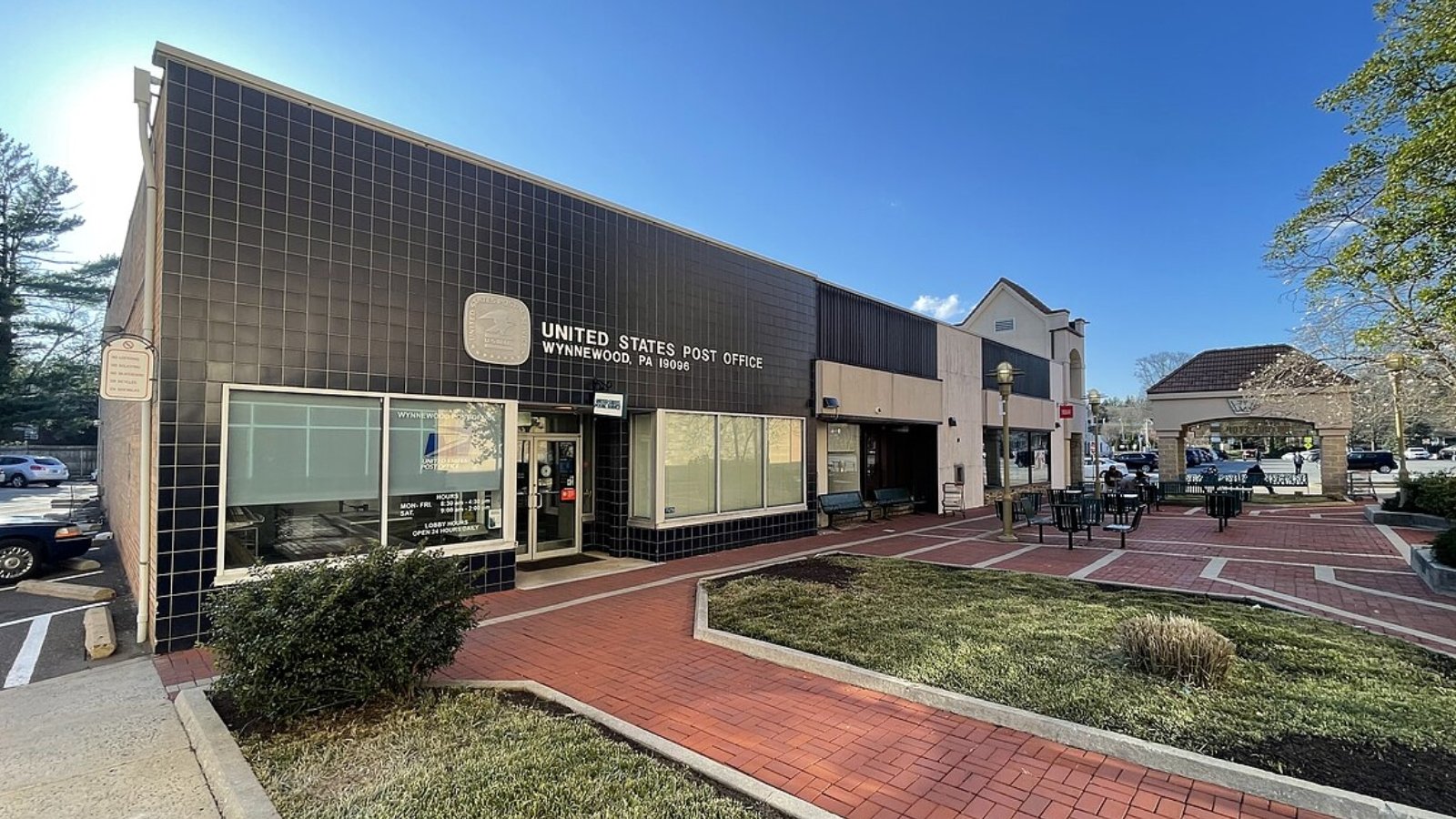
Why are people willing to pay so much to live here? What’s special about it?
Wynnewood attracts buyers seeking Main Line prestige with excellent transportation access, featuring beautiful tree-lined streets, architectural variety, and proximity to outstanding schools in the Lower Merion School District. The community offers a perfect balance of suburban tranquility and urban accessibility, with easy access to Philadelphia via multiple SEPTA lines. Families particularly value the area’s safety, walkability, and strong community involvement.
The location provides convenient access to shopping, dining, and cultural amenities while maintaining a distinctly residential character that appeals to professionals and executives. Wynnewood’s blend of historic homes and newer developments creates options for diverse buyer preferences while preserving neighborhood character. Property values reflect the premium buyers place on this combination of Main Line prestige, transportation convenience, and educational excellence.
How Wynnewood Rose to Prominence
Wynnewood’s prominence grew as one of the original Main Line communities, developed in the late 19th century when the Pennsylvania Railroad’s suburban line made commuting to Philadelphia practical for affluent families. Named after Dr. Thomas Wynne, an early Welsh settler and friend of William Penn, the community was designed as a suburban retreat for Philadelphia’s business elite. The railroad connection enabled residents to maintain city business interests while enjoying suburban living.
The community’s development accelerated in the early 20th century with the addition of shopping centers and improved transportation infrastructure. Wynnewood successfully balanced commercial development with residential character, creating a walkable community that combined suburban amenities with urban convenience. The establishment of excellent schools and preservation of architectural character helped maintain the community’s appeal to successive generations of affluent families.
3 Interesting Tidbits
1. Shopping Pioneer – Wynnewood was home to one of America’s first planned suburban shopping centers, establishing retail patterns that influenced development nationwide.
2. Transportation Hub – Multiple SEPTA train lines serve the community, providing exceptional access to Philadelphia and regional destinations.
3. Architectural Heritage – The community features a diverse mix of architectural styles from colonial revival to contemporary, creating distinctive neighborhood character.
10. Narberth – 98% Home Price Increase Since 2010
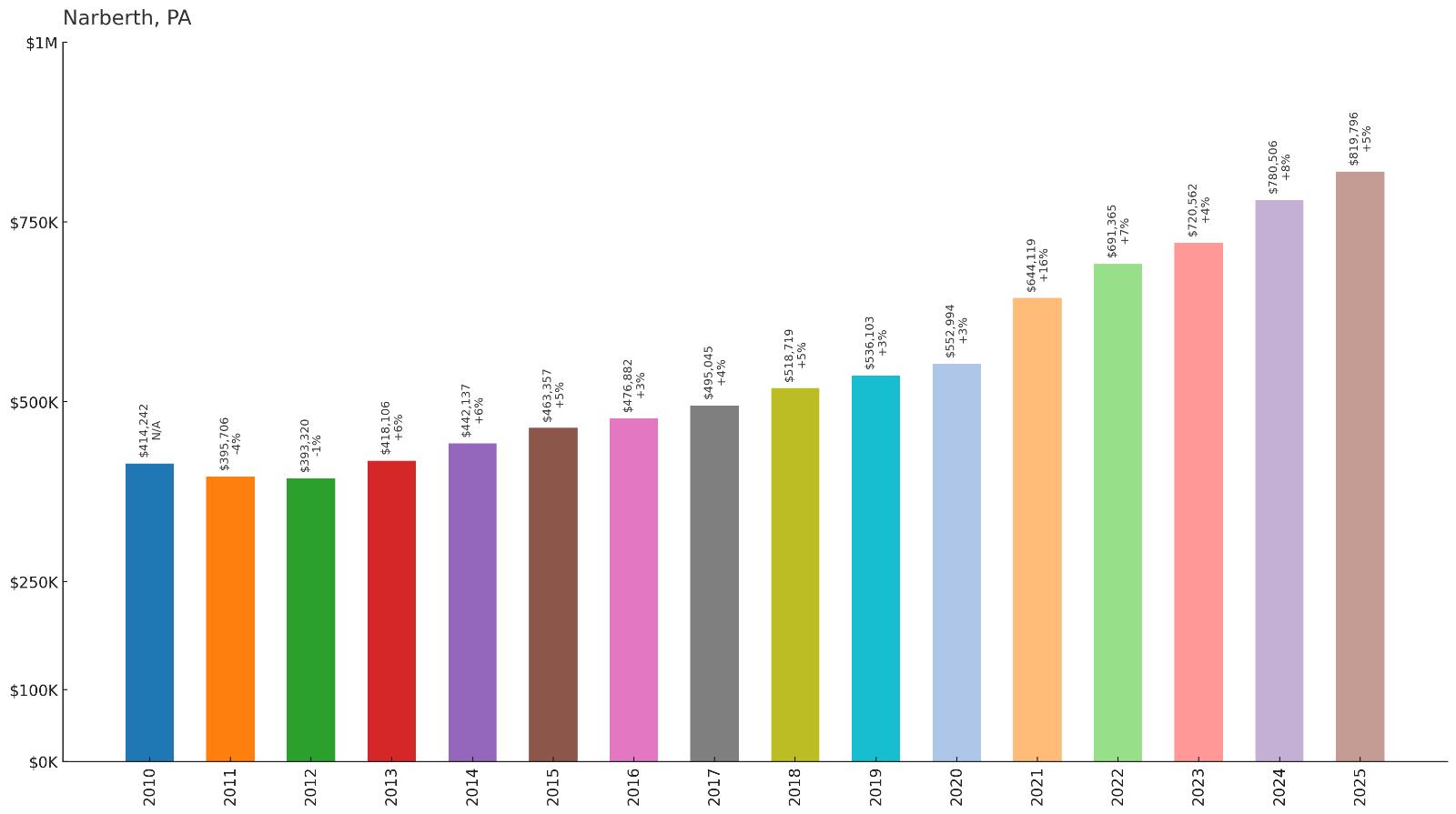
- 2010: $414,242
- 2011: $395,706
- 2012: $393,320
- 2013: $418,106
- 2014: $442,137
- 2015: $463,357
- 2016: $476,882
- 2017: $495,045
- 2018: $518,719
- 2019: $536,103
- 2020: $552,994
- 2021: $644,119
- 2022: $691,365
- 2023: $720,562
- 2024: $780,506
- 2025: $819,796
Narberth has delivered exceptional returns with a 98% increase since 2010, nearly doubling home values to reach $819,796 by 2025. The community showed consistent growth through the decade before accelerating dramatically during the pandemic years. This Montgomery County borough has become one of the region’s most desirable small-town communities.
Why Narberth?
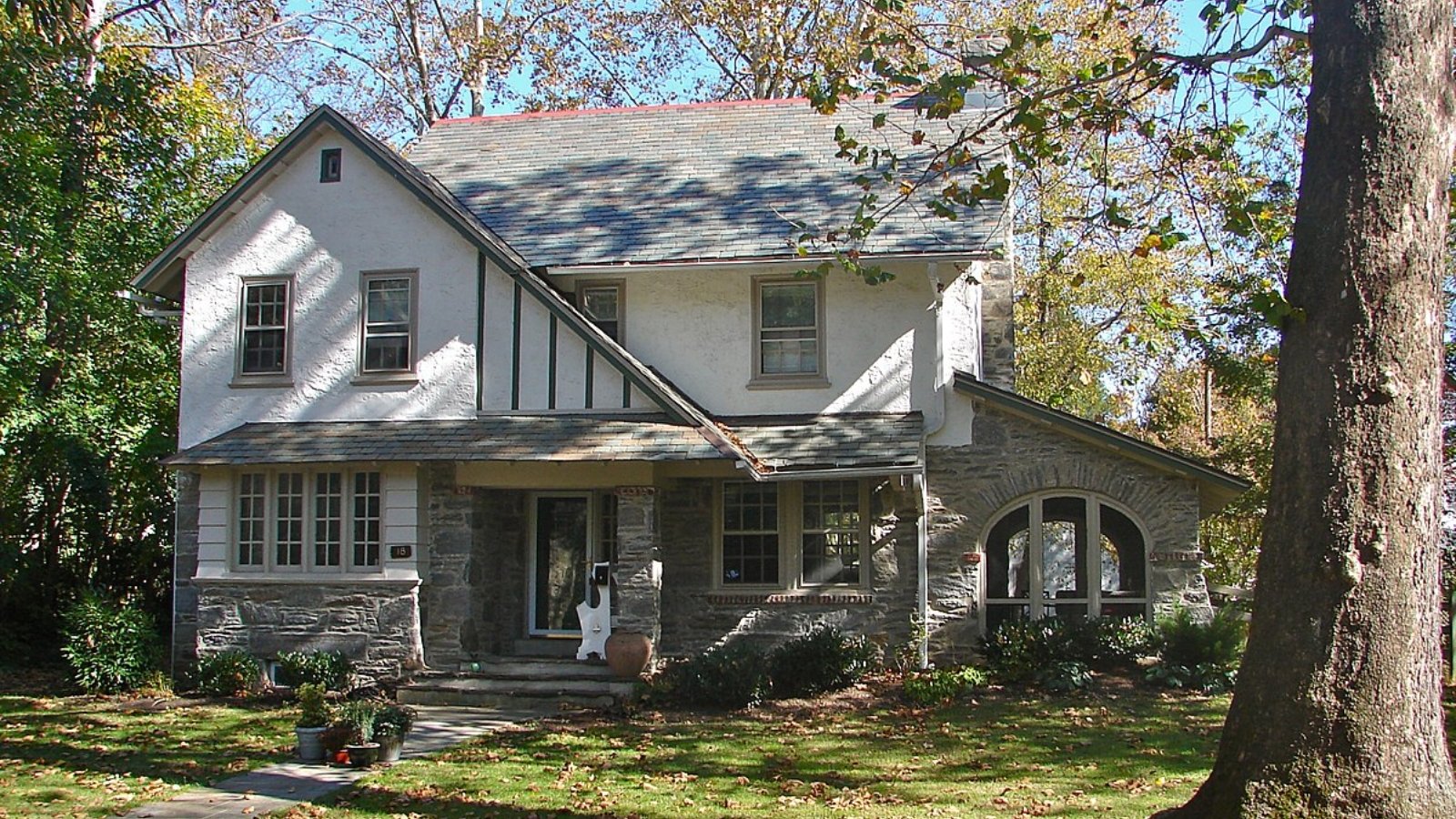
Why are people willing to pay so much to live here? What’s special about it?
Narberth commands premium prices as a charming small borough that perfectly balances small-town character with Main Line convenience, featuring walkable streets, local shops, and strong community events that create exceptional neighborhood cohesion. The borough attracts families seeking excellent schools through the Lower Merion School District while wanting a close-knit community atmosphere. The area’s tree-lined streets, historic architecture, and active civic life create an appealing lifestyle that justifies high housing costs.
The location provides excellent transportation access to Philadelphia via SEPTA while maintaining a village-like atmosphere that feels distinct from typical suburban developments. Narberth’s annual events, local businesses, and community involvement create social connections that many suburban areas lack. Property values reflect the premium buyers place on this rare combination of small-town charm, excellent schools, and urban accessibility.
How Narberth Rose to Prominence
Narberth’s prominence began with its incorporation as Pennsylvania’s smallest borough in 1895, when residents sought local control over their community’s development and character. Originally part of larger townships, the area developed around the Pennsylvania Railroad station as a residential enclave for commuters seeking small-town living with Philadelphia access. The Welsh-inspired name reflects the area’s early development patterns and cultural heritage.
The borough’s small size and local governance enabled residents to maintain tight control over development and preserve community character through the 20th century. Narberth successfully resisted pressures for larger-scale development while enhancing its walkable downtown and community amenities. This careful balance of preservation and improvement created the distinctive small-town environment that continues to attract buyers willing to pay premium prices for authentic community living.
3 Interesting Tidbits
1. Smallest Borough – At just 0.6 square miles, Narberth is Pennsylvania’s smallest incorporated borough, creating an intimate community atmosphere.
2. Community Events – The borough hosts numerous annual events including the popular Narberth Community Day that brings residents together and creates strong social connections.
3. Walkable Design – The borough’s compact size and grid street pattern create excellent walkability that many suburban communities lack.
9. Bryn Mawr – 80% Home Price Increase Since 2010

- 2010: $491,353
- 2011: $463,788
- 2012: $461,508
- 2013: $475,728
- 2014: $506,883
- 2015: $514,721
- 2016: $519,053
- 2017: $532,640
- 2018: $551,551
- 2019: $567,504
- 2020: $587,860
- 2021: $681,877
- 2022: $759,067
- 2023: $797,941
- 2024: $849,713
- 2025: $884,655
Bryn Mawr has achieved strong growth with an 80% increase since 2010, reaching $884,655 by 2025. The community showed steady appreciation through the decade before accelerating during the pandemic years. This Montgomery County location represents the epitome of Main Line prestige and educational excellence.
Why Bryn Mawr?
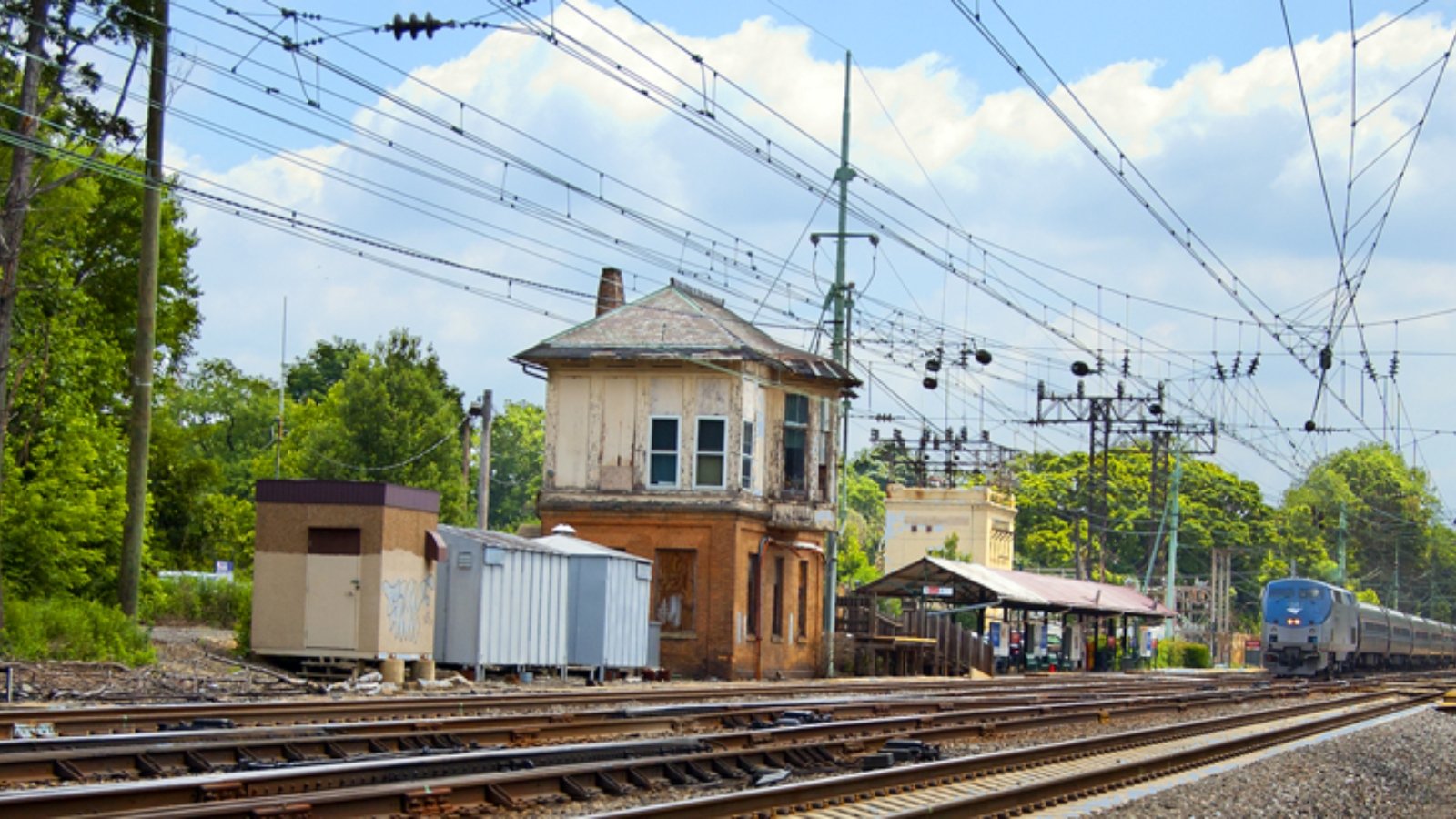
Why are people willing to pay so much to live here? What’s special about it?
Bryn Mawr commands premium prices as the crown jewel of the Main Line, home to prestigious Bryn Mawr College and featuring some of the region’s most beautiful residential architecture and tree-lined streets. The community attracts affluent families seeking the ultimate combination of educational excellence, cultural sophistication, and social prestige. The presence of the college adds intellectual vitality and cultural resources that enhance the community’s appeal beyond typical suburban offerings.
The location provides exceptional access to Philadelphia while maintaining an atmosphere of academic distinction and architectural beauty that sets it apart from other wealthy suburbs. Bryn Mawr’s blend of historic estates, elegant neighborhoods, and cultural amenities appeals to buyers seeking not just luxury but sophistication and prestige. Property values reflect the premium buyers place on this unique combination of Main Line heritage, educational excellence, and cultural distinction.
How Bryn Mawr Rose to Prominence
Bryn Mawr’s prominence began with the establishment of Bryn Mawr College in 1885, which brought academic prestige and cultural sophistication to what was then a rural area along the Pennsylvania Railroad’s Main Line. The college’s presence attracted affluent families who valued educational excellence and cultural opportunities, leading to the development of elegant residential neighborhoods surrounding the campus. The Welsh name, meaning “big hill,” reflects the area’s topography and cultural heritage.
The community’s development accelerated as the Main Line became synonymous with Philadelphia’s social elite, with Bryn Mawr emerging as one of its most prestigious addresses. The combination of the college’s intellectual atmosphere, beautiful architecture, and convenient railroad access created a unique environment that attracted generations of affluent families. This foundation of education, culture, and social prestige continues to drive property values and community desirability.
3 Interesting Tidbits
1. College Town Elite – Bryn Mawr College, one of the prestigious Seven Sisters colleges, brings academic distinction and cultural events that enhance community life.
2. Architectural Showcase – The community features some of the Main Line’s most impressive residential architecture, from Victorian mansions to elegant colonial revivals.
3. Cultural Hub – The presence of the college provides access to lectures, performances, and cultural events that create intellectual vitality rare in suburban communities.
8. New Hope – 81% Home Price Increase Since 2010
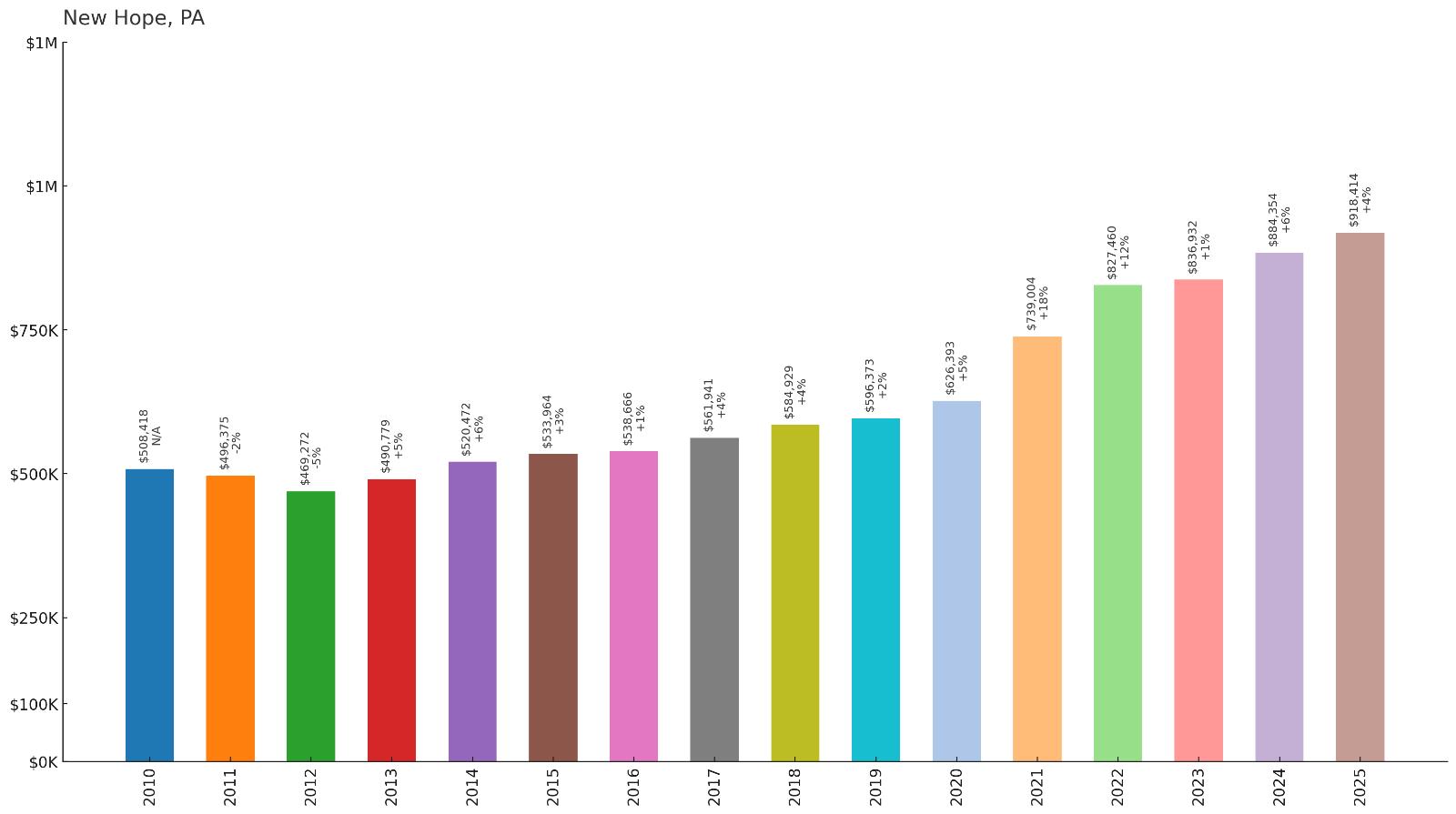
- 2010: $508,418
- 2011: $496,375
- 2012: $469,272
- 2013: $490,779
- 2014: $520,472
- 2015: $533,964
- 2016: $538,666
- 2017: $561,941
- 2018: $584,929
- 2019: $596,373
- 2020: $626,393
- 2021: $739,004
- 2022: $827,460
- 2023: $836,932
- 2024: $884,354
- 2025: $918,414
New Hope has achieved impressive growth with an 81% increase since 2010, reaching $918,414 by 2025. The community showed steady appreciation through the decade before surging during the pandemic years, with particularly strong gains in 2021 and 2022. This Bucks County borough has attracted buyers seeking artistic charm and riverfront beauty.
Why New Hope?

Why are people willing to pay so much to live here? What’s special about it?
New Hope commands premium prices as a unique artistic and cultural destination, offering historic charm, Delaware River beauty, and a vibrant arts scene that creates an atmosphere unlike any other Pennsylvania community. The borough attracts buyers seeking creativity, culture, and natural beauty, with its galleries, theaters, restaurants, and antique shops creating a distinctive lifestyle. The area’s scenic location along the Delaware River adds natural beauty and recreational opportunities that enhance property values.
The community’s artistic reputation and tourism appeal create economic vitality while maintaining historic character that dates to the 18th century. New Hope’s blend of cultural sophistication, natural beauty, and small-town charm appeals to buyers seeking something beyond typical suburban living. Property values reflect the premium buyers place on this rare combination of arts culture, historic character, and riverfront location.
How New Hope Rose to Prominence
New Hope’s prominence began with its establishment as a colonial-era mill town along the Delaware River, where Benjamin Parry built mills and gave the community its optimistic name in the 1790s. The town’s location made it an important transportation hub with ferry connections to New Jersey and canal access for commerce. The Delaware Canal and later railroad connections maintained the town’s commercial importance through the 19th century.
The transformation into an arts destination began in the early 20th century when the area’s natural beauty and affordable real estate attracted artists, writers, and theater people seeking creative communities. The establishment of the Bucks County Playhouse in 1939 cemented New Hope’s reputation as a cultural center, attracting visitors and residents who valued arts and culture. This artistic foundation continues to drive the community’s unique character and appeal to buyers seeking creative environments.
3 Interesting Tidbits
1. Theater Legacy – The historic Bucks County Playhouse has hosted major Broadway productions and continues to attract top-tier performances to the community.
2. Artist Colony – New Hope has been home to numerous famous artists and writers, creating a creative legacy that continues to attract arts-minded residents.
3. Delaware Canal – The restored Delaware Canal provides scenic walking and biking trails that showcase the area’s industrial heritage and natural beauty.
7. Wayne – 6% Home Price Increase Since 2024
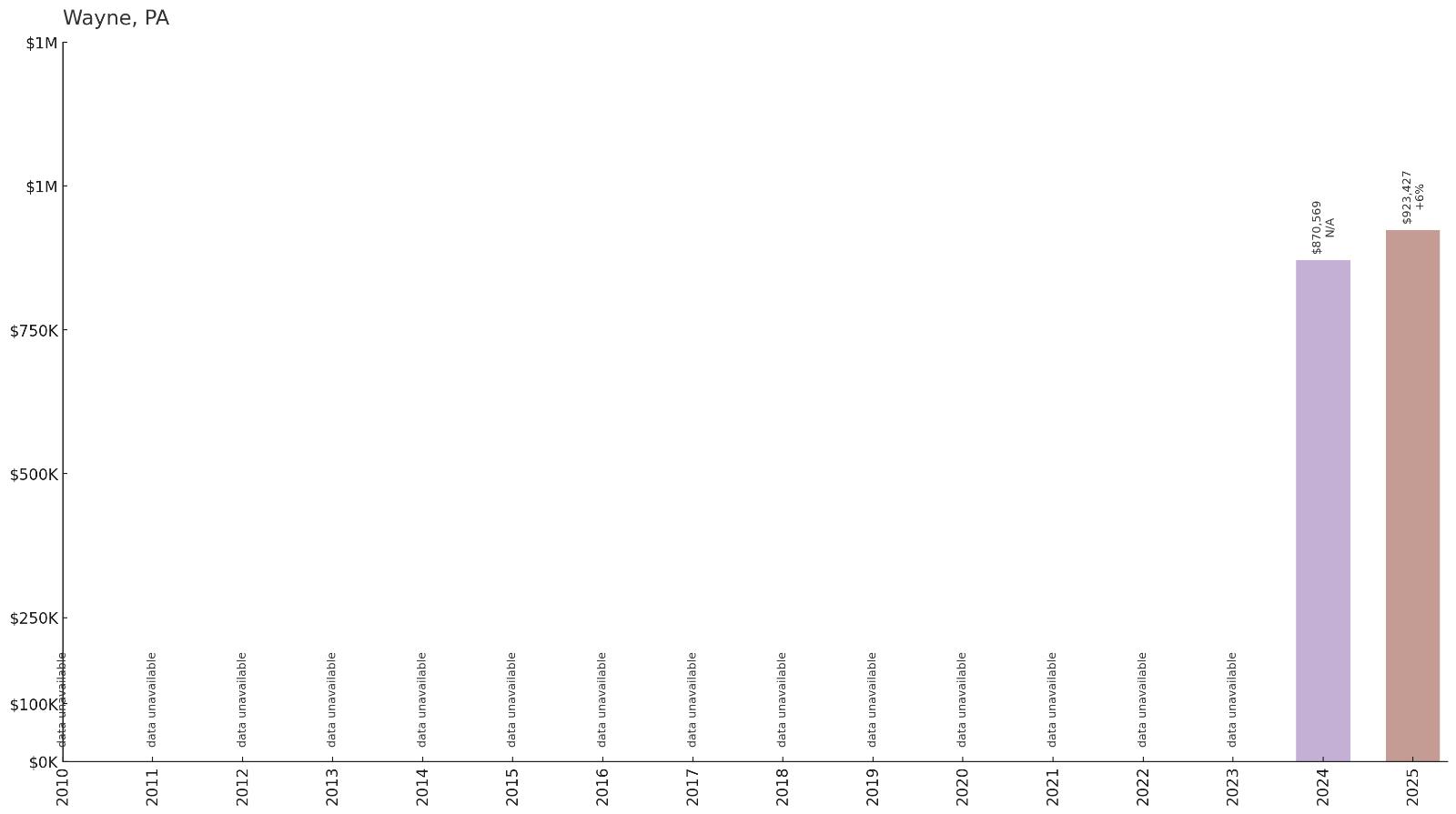
- 2010: N/A
- 2011: N/A
- 2012: N/A
- 2013: N/A
- 2014: N/A
- 2015: N/A
- 2016: N/A
- 2017: N/A
- 2018: N/A
- 2019: N/A
- 2020: N/A
- 2021: N/A
- 2022: N/A
- 2023: N/A
- 2024: $870,569
- 2025: $923,427
Wayne achieved a solid 6% increase from 2024 to 2025, reaching $923,427 in median home value. This Montgomery County community continues to represent Main Line prestige at its finest. The steady appreciation reflects consistent demand for this premier suburban location despite limited historical data availability.
Why Wayne?

Why are people willing to pay so much to live here? What’s special about it?
Wayne commands premium prices as one of the most prestigious Main Line communities, offering elegant neighborhoods, exceptional schools through the Radnor Township School District, and unparalleled access to Philadelphia via SEPTA’s Paoli/Thorndale Line. The community attracts affluent professionals and executives seeking the ultimate suburban lifestyle with top-tier amenities. The area’s beautiful tree-lined streets, architectural variety, and strong community involvement create an appealing environment that justifies premium housing costs.
The location provides perfect balance between suburban tranquility and urban accessibility, with excellent shopping, dining, and cultural amenities complementing residential excellence. Wayne’s reputation as a Main Line anchor community appeals to buyers seeking prestige and stability. Property values reflect the premium buyers place on this combination of educational excellence, transportation convenience, and social status that defines Main Line living.
How Wayne Rose to Prominence
Wayne’s prominence began with its establishment as a major station on the Pennsylvania Railroad’s Main Line in the 1880s, named after Revolutionary War General Anthony Wayne. The community developed as a residential and commercial center serving the railroad’s suburban expansion, attracting affluent Philadelphia families seeking country living with city convenience. The railroad connection made Wayne a natural hub for Main Line development.
The community’s growth accelerated in the early 20th century with the development of elegant residential neighborhoods and commercial districts that established Wayne as a Main Line anchor. The combination of excellent transportation, quality schools, and attractive neighborhoods created enduring appeal that has sustained premium property values through multiple generations. Wayne successfully balanced growth with preservation of community character, maintaining its position as a premier suburban destination.
3 Interesting Tidbits
1. Transportation Hub – Wayne Station serves as a major SEPTA hub with multiple train lines providing exceptional access to Philadelphia and regional destinations.
2. Shopping Destination – Wayne’s downtown area features upscale shopping and dining that serves the broader Main Line community.
3. Educational Excellence – The Radnor Township School District consistently ranks among Pennsylvania’s top districts, driving sustained housing demand from families.
6. Berwyn – 66% Home Price Increase Since 2016
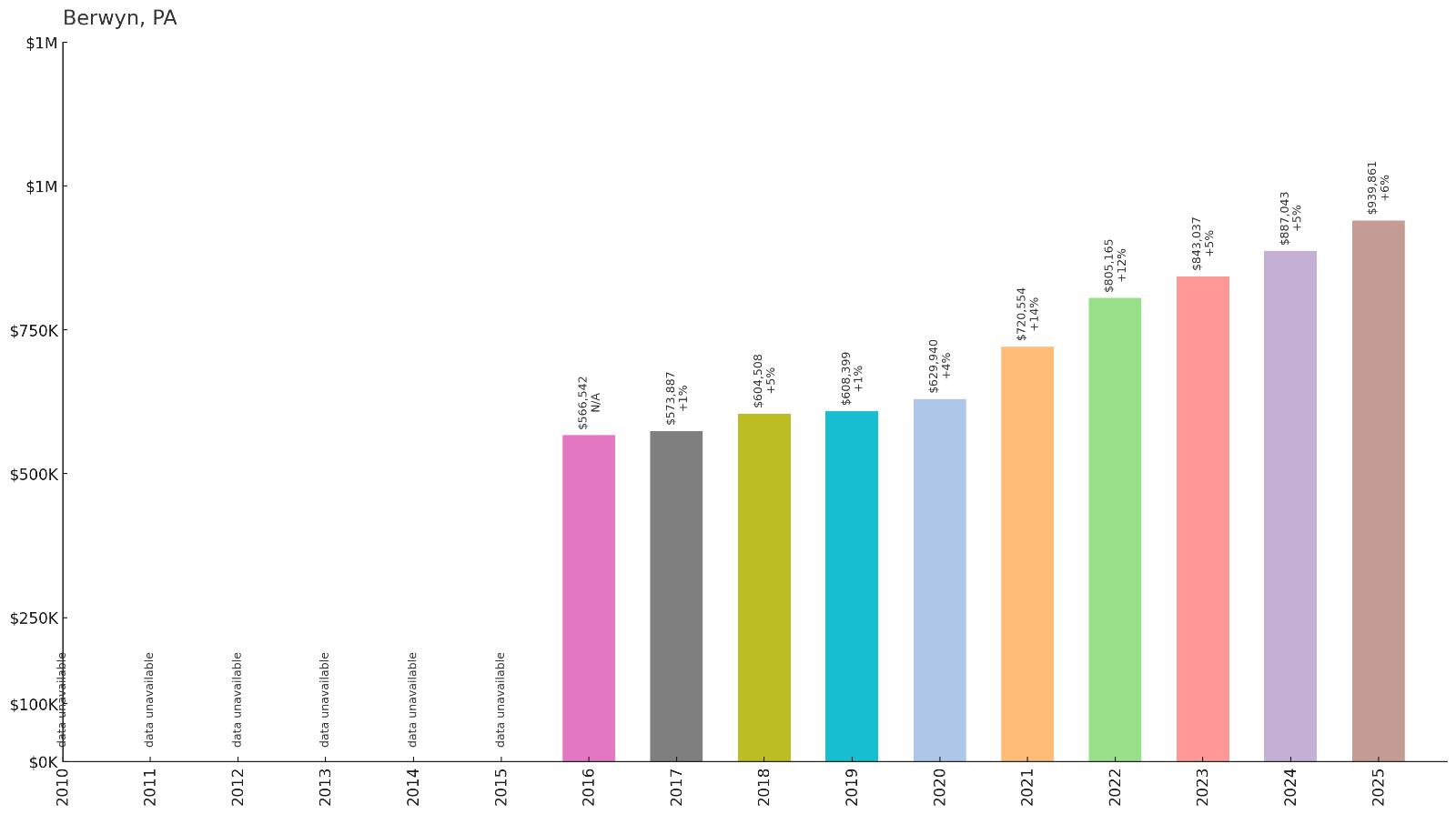
- 2010: N/A
- 2011: N/A
- 2012: N/A
- 2013: N/A
- 2014: N/A
- 2015: N/A
- 2016: $566,542
- 2017: $573,887
- 2018: $604,508
- 2019: $608,399
- 2020: $629,940
- 2021: $720,554
- 2022: $805,165
- 2023: $843,037
- 2024: $887,043
- 2025: $939,861
Berwyn has achieved strong growth with a 66% increase since 2016, reaching $939,861 by 2025. The community showed steady appreciation through the late 2010s before accelerating during the pandemic years. This Chester County location has become increasingly attractive to buyers seeking Main Line prestige with excellent schools.
Why Berwyn?
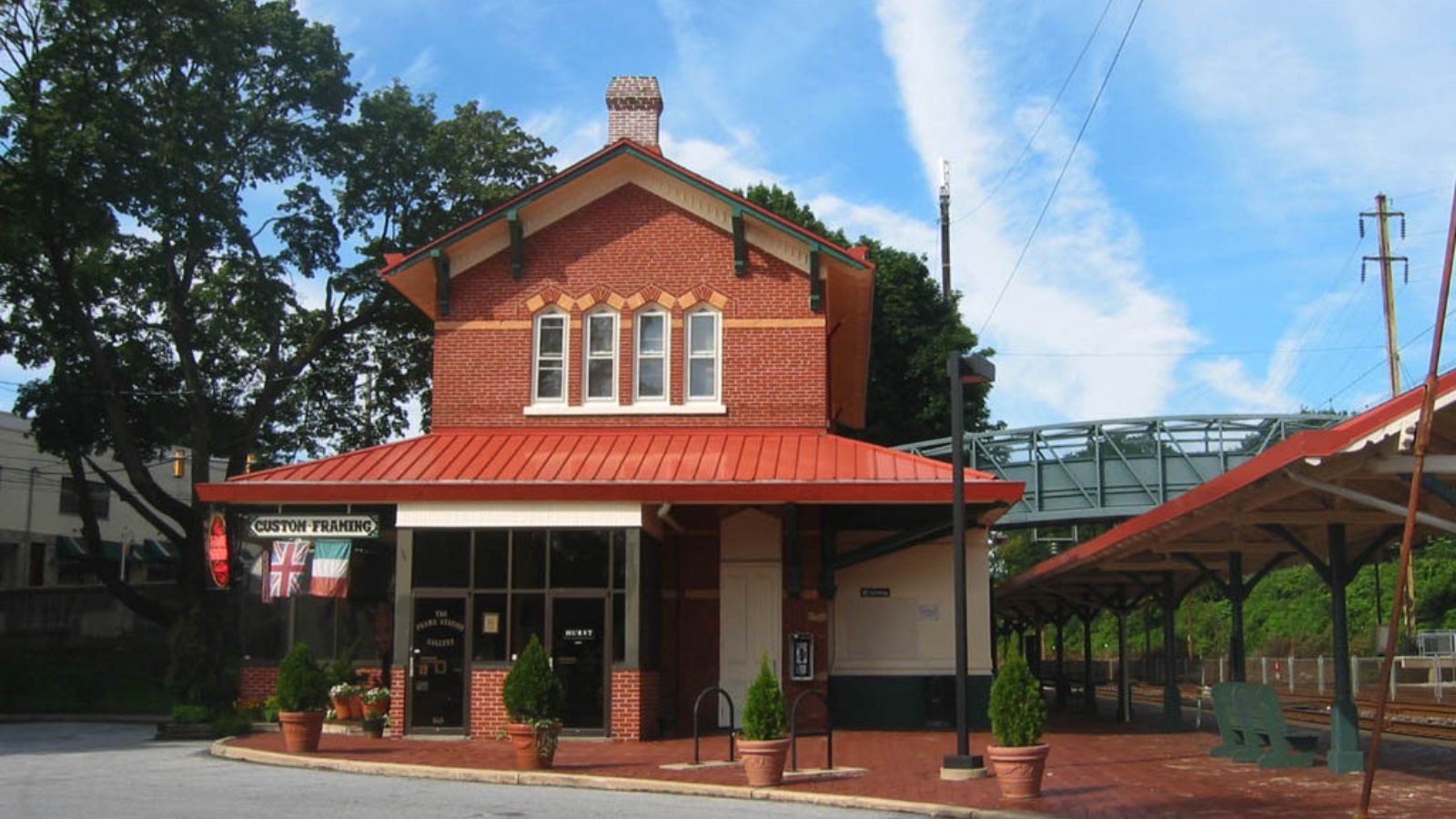
Why are people willing to pay so much to live here? What’s special about it?
Berwyn appeals to affluent families seeking Main Line excellence through the highly-regarded Tredyffrin/Easttown School District, consistently ranked among Pennsylvania’s finest educational systems. The community offers beautiful residential neighborhoods, convenient access to major employment centers, and proximity to excellent shopping and recreational amenities. The area’s location along the Main Line provides easy access to Philadelphia while maintaining suburban character that appeals to executives and professionals.
The community’s blend of established neighborhoods and newer developments creates options for diverse buyer preferences while preserving the Main Line’s distinctive character. Berwyn’s proximity to corporate centers in King of Prussia and Malvern makes it particularly attractive to business leaders. Property values reflect the premium buyers place on this combination of educational excellence, corporate convenience, and Main Line prestige.
How Berwyn Rose to Prominence
Berwyn’s prominence developed as part of the Main Line’s expansion in the late 19th and early 20th centuries, when improved railroad service made suburban living practical for Philadelphia’s business elite. The community was named after Berwyn in Wales, reflecting the area’s Welsh heritage and the Main Line’s tradition of Welsh place names. The Pennsylvania Railroad’s investment in suburban service created development opportunities that attracted affluent families.
The area’s growth accelerated with the establishment of excellent schools and the development of corporate campuses in nearby areas, creating employment opportunities that supported residential development. Berwyn successfully balanced residential growth with preservation of Main Line character, maintaining the suburban excellence that continues to attract homebuyers seeking prestige and convenience.
3 Interesting Tidbits
1. School Prestige – The Tredyffrin/Easttown School District consistently ranks in Pennsylvania’s top five, with multiple schools receiving national recognition.
2. Corporate Access – Berwyn provides convenient access to major corporate centers including King of Prussia, creating ideal conditions for executive housing.
3. Main Line Heritage – The community maintains the Welsh naming tradition and architectural character that defines Main Line identity.
5. Edgeworth – 105% Home Price Increase Since 2010
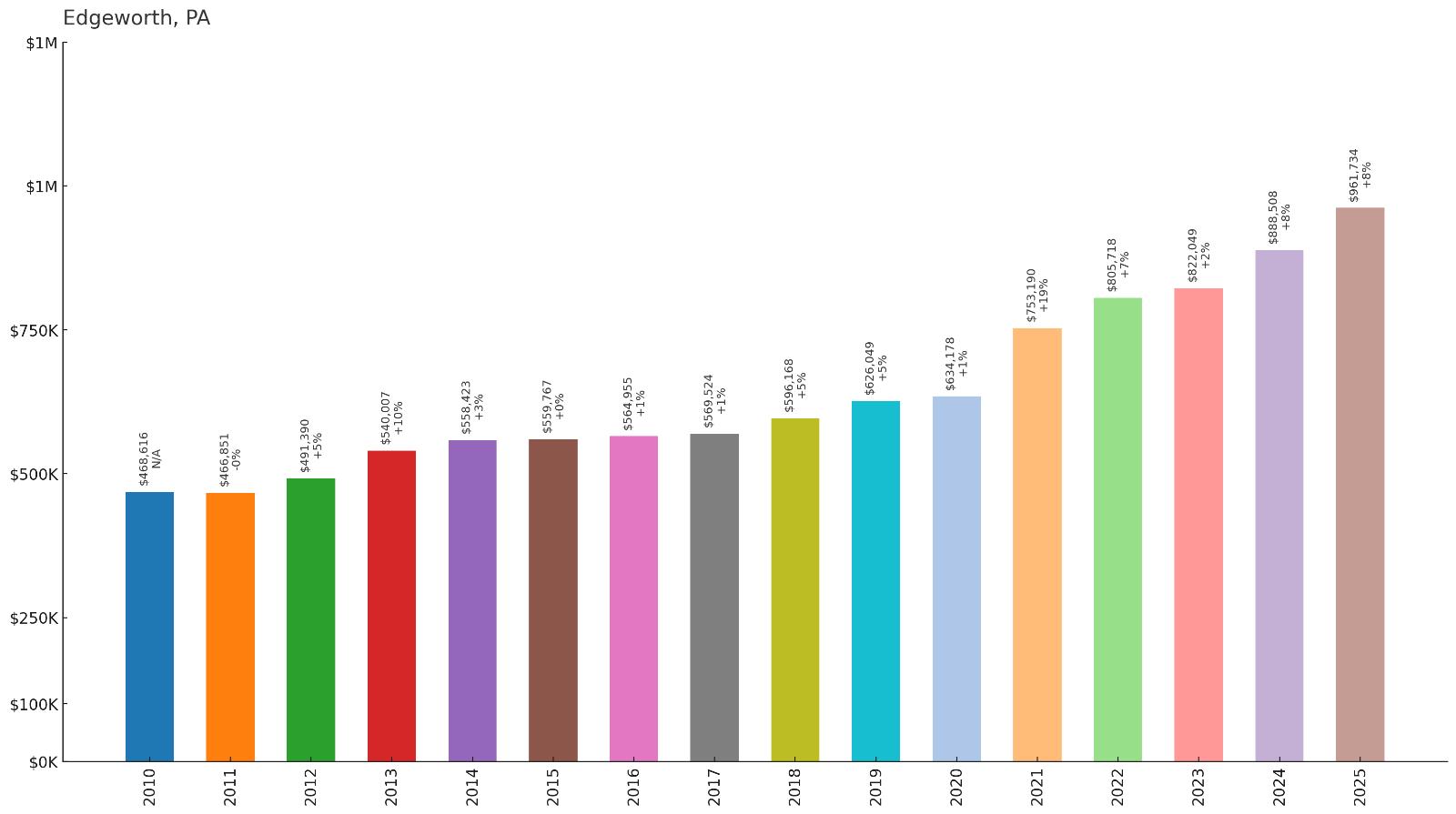
- 2010: $468,616
- 2011: $466,851
- 2012: $491,390
- 2013: $540,007
- 2014: $558,423
- 2015: $559,767
- 2016: $564,955
- 2017: $569,524
- 2018: $596,168
- 2019: $626,049
- 2020: $634,178
- 2021: $753,190
- 2022: $805,718
- 2023: $822,049
- 2024: $888,508
- 2025: $961,734
Edgeworth has delivered outstanding returns with a 105% increase since 2010, more than doubling home values to reach $961,734 by 2025. The community showed steady growth through the decade before accelerating significantly during the pandemic years. This Allegheny County borough has emerged as Pittsburgh’s premier suburban enclave.
Why Edgeworth?
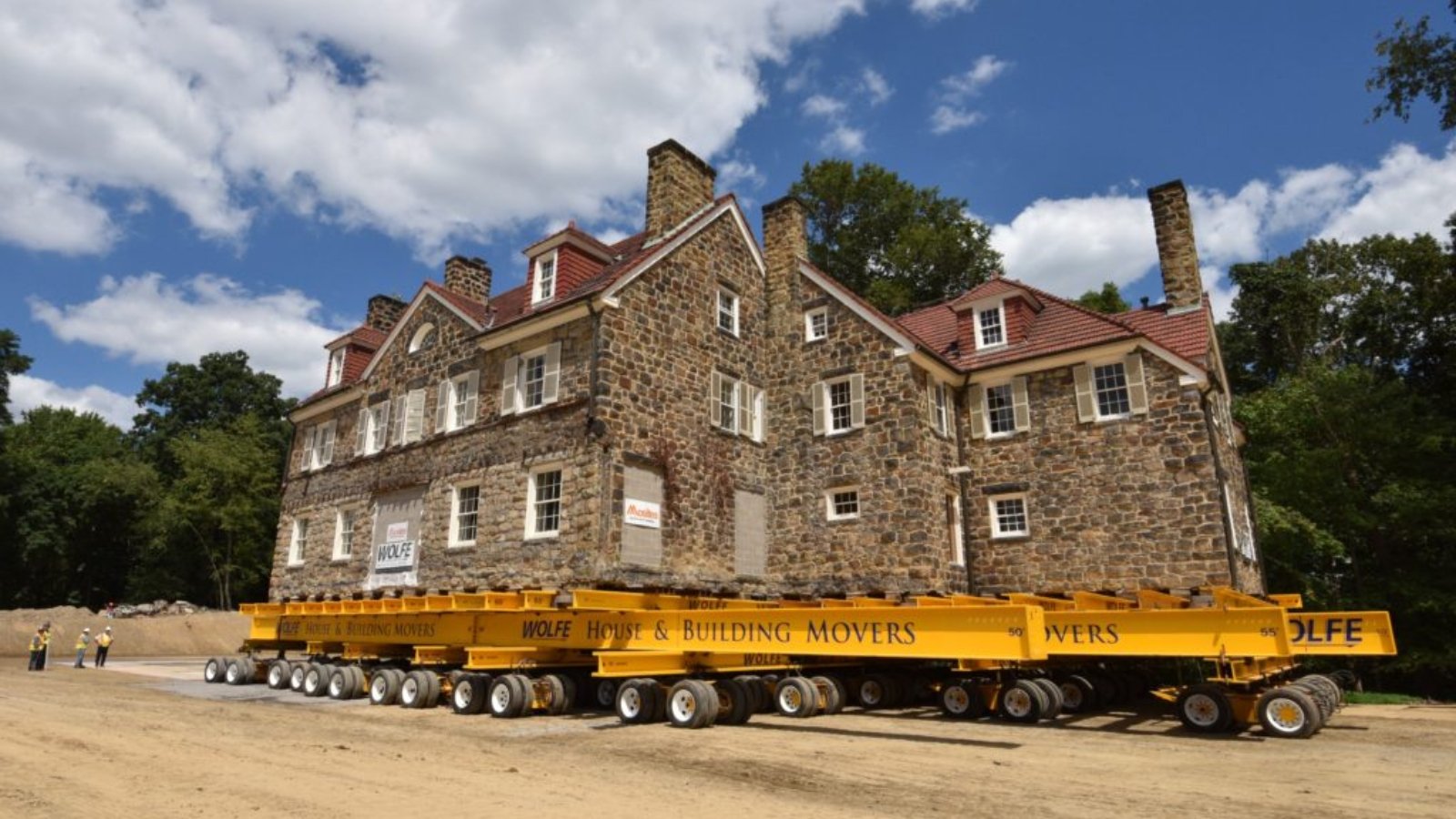
Why are people willing to pay so much to live here? What’s special about it?
Edgeworth commands premium prices as Pittsburgh’s most exclusive suburban community, offering large estates, historic architecture, and unparalleled privacy along the Ohio River. The borough attracts wealthy families and executives seeking the ultimate in suburban luxury with beautiful homes on substantial lots. The area’s tree-lined streets, mature landscaping, and architectural variety create an atmosphere of established wealth and sophistication rare in western Pennsylvania.
The community’s location provides convenient access to Pittsburgh’s business district while maintaining a distinctly separate identity that feels far removed from urban pressures. Edgeworth’s excellent schools, low crime rates, and stable property values appeal to buyers seeking long-term investment and lifestyle quality. Property values reflect the premium buyers place on this rare combination of exclusivity, natural beauty, and proximity to Pittsburgh employment opportunities.
How Edgeworth Rose to Prominence
Edgeworth’s prominence began in the late 19th century when Pittsburgh’s industrial wealth created demand for exclusive residential enclaves away from the city’s smoke and noise. The borough was developed as a planned community for Pittsburgh’s elite, with large lots, architectural restrictions, and careful planning that created the exclusive character still evident today. The name reflects the community’s location on the edge of bluffs overlooking the Ohio River.
The community’s development attracted Pittsburgh’s most successful industrialists, creating a concentration of wealth that supported premium amenities and services. Edgeworth’s incorporation as a borough in 1904 provided local control that enabled residents to maintain exclusivity and architectural standards. This foundation of wealth, exclusivity, and careful planning continues to drive property values and community desirability among Pittsburgh’s affluent families.
3 Interesting Tidbits
1. River Frontage – Many Edgeworth properties feature Ohio River frontage, providing scenic views and recreational access that enhance property values significantly.
2. Historic Estates – The borough features numerous historic mansions and estates dating to Pittsburgh’s industrial heyday, creating architectural distinction.
3. Exclusive Zoning – Large minimum lot sizes and architectural standards help preserve the community’s exclusive character and property values.
4. Devon – 66% Home Price Increase Since 2016
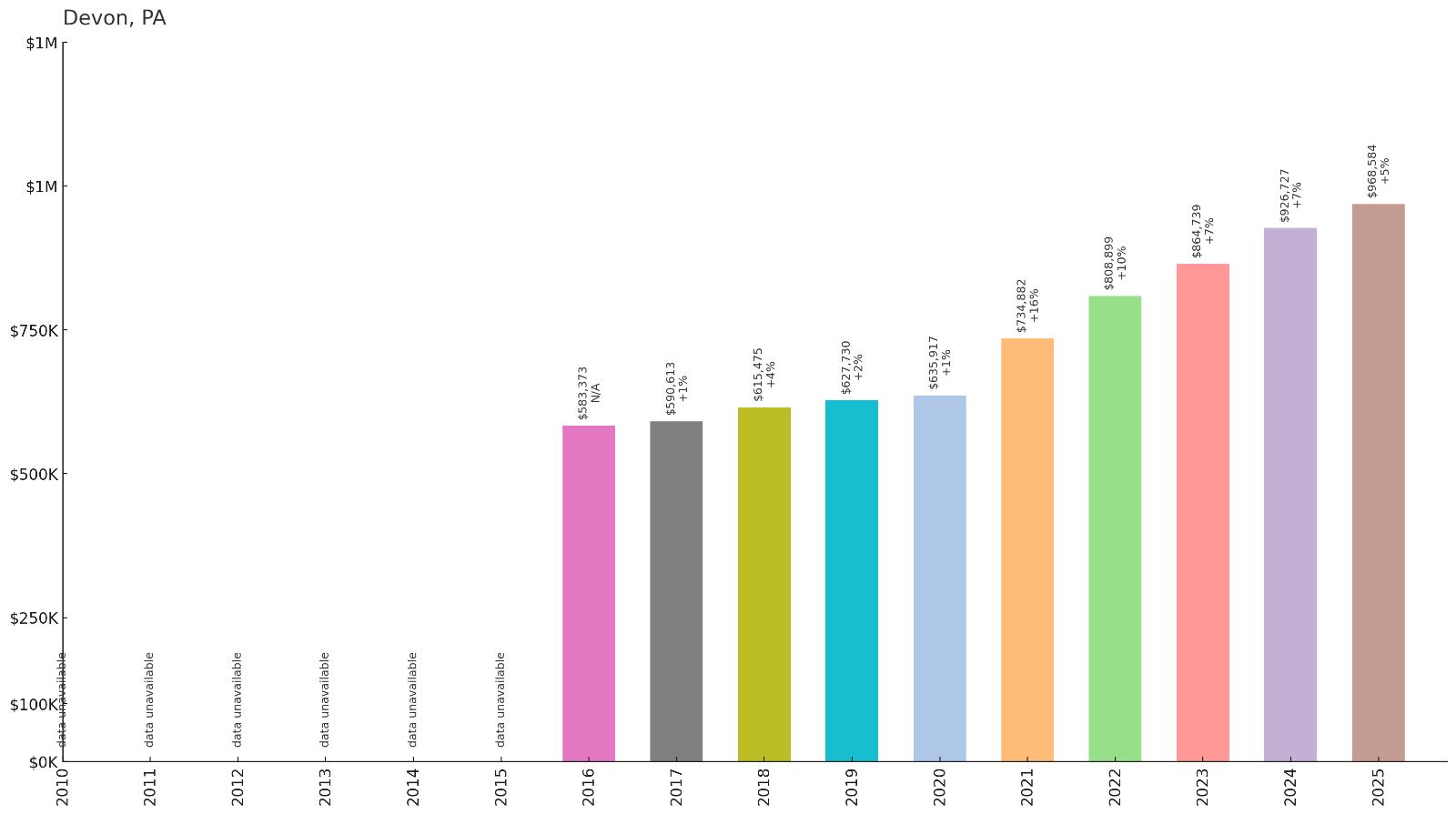
- 2010: N/A
- 2011: N/A
- 2012: N/A
- 2013: N/A
- 2014: N/A
- 2015: N/A
- 2016: $583,373
- 2017: $590,613
- 2018: $615,475
- 2019: $627,730
- 2020: $635,917
- 2021: $734,882
- 2022: $808,899
- 2023: $864,739
- 2024: $926,727
- 2025: $968,584
Devon has achieved strong growth with a 66% increase since 2016, reaching $968,584 by 2025. The community showed steady appreciation through the late 2010s before accelerating during the pandemic years. This Chester County location has become one of the most sought-after Main Line communities.
Why Devon?
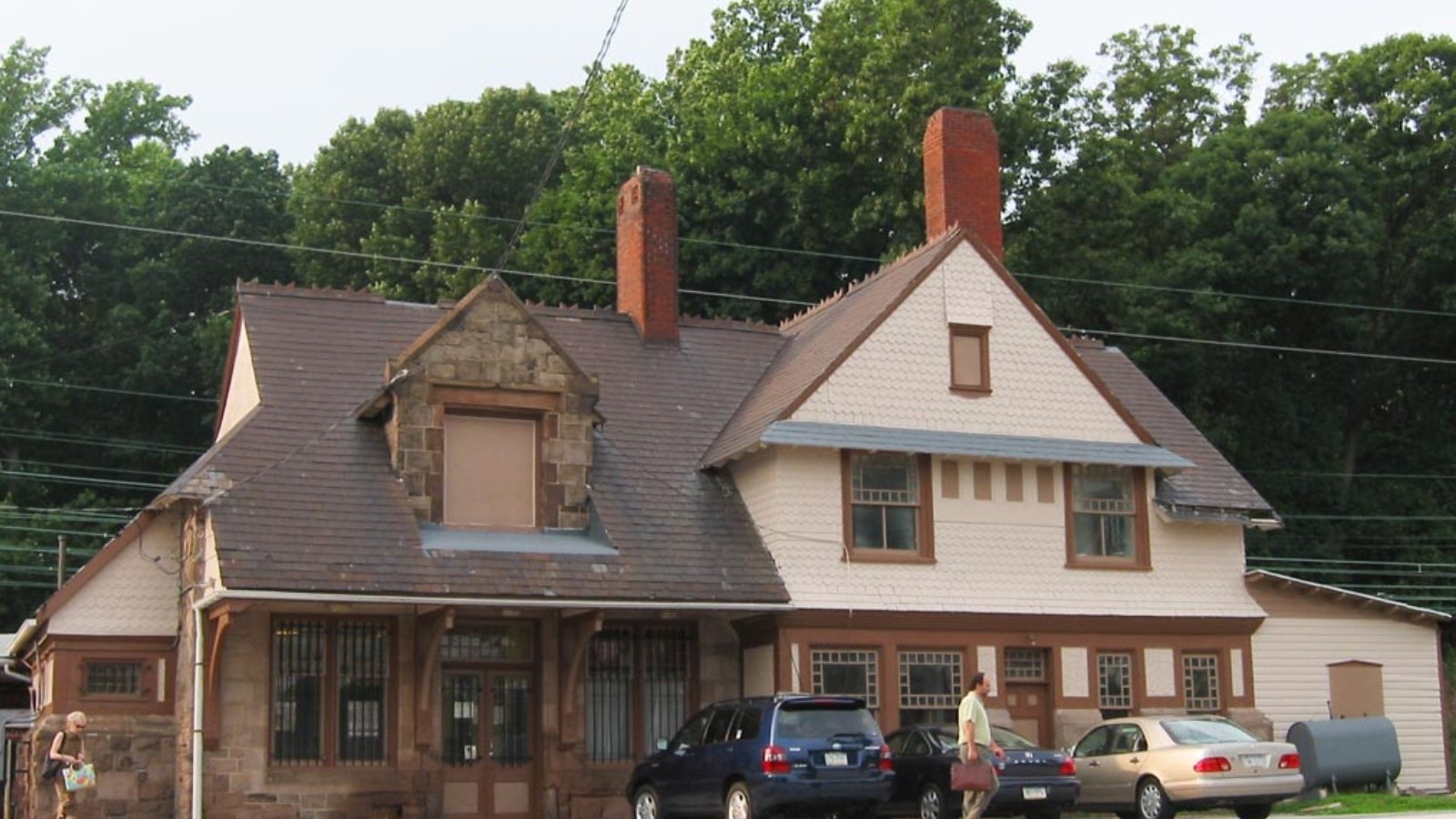
Why are people willing to pay so much to live here? What’s special about it?
Devon commands premium prices as an exclusive Main Line community known for its equestrian heritage, elegant estates, and proximity to the world-famous Devon Horse Show. The area attracts affluent families seeking luxury living with country club amenities, featuring large properties, beautiful landscapes, and access to the highly-rated Tredyffrin/Easttown School District. The community’s association with equestrian sports and high society creates prestige that appeals to wealthy buyers.
The location offers exceptional convenience to Philadelphia employment centers while maintaining a distinctly rural character with horse farms, rolling hills, and preserved open space. Devon’s blend of luxury amenities, natural beauty, and social prestige appeals to buyers seeking the ultimate suburban lifestyle. Property values reflect the premium buyers place on this unique combination of equestrian culture, educational excellence, and Main Line distinction.
How Devon Rose to Prominence
Devon’s prominence grew from its establishment as a railroad stop on the Pennsylvania Railroad’s Main Line, named after Devon, England, reflecting the area’s English heritage. The community’s development accelerated with the founding of the Devon Horse Show in 1896, which brought national attention and established Devon’s reputation as a center for equestrian sports and high society. This annual event continues to define the community’s character and social calendar.
The area’s appeal to Philadelphia’s wealthy elite led to the development of large estates and country homes that established Devon’s exclusive character. The combination of railroad access, equestrian culture, and natural beauty created a unique community identity that attracted generations of affluent families. This foundation of wealth, tradition, and exclusivity continues to drive property values and maintain Devon’s position among Pennsylvania’s most prestigious addresses.
3 Interesting Tidbits
1. Horse Show Heritage – The Devon Horse Show, established in 1896, is one of America’s oldest and most prestigious equestrian competitions, drawing international attention annually.
2. Country Club Life – Devon is home to exclusive country clubs and golf courses that cater to affluent residents and add to the community’s social prestige.
3. Equestrian Estates – Many properties feature horse facilities, stables, and riding trails that preserve the community’s equestrian heritage and appeal to horse enthusiasts.
3. Merion Station – 5% Home Price Increase Since 2024

- 2010: N/A
- 2011: N/A
- 2012: N/A
- 2013: N/A
- 2014: N/A
- 2015: N/A
- 2016: N/A
- 2017: N/A
- 2018: N/A
- 2019: N/A
- 2020: N/A
- 2021: N/A
- 2022: N/A
- 2023: N/A
- 2024: $1,000,942
- 2025: $1,050,527
Merion Station achieved a solid 5% increase from 2024 to 2025, reaching $1,050,527 in median home value. This Montgomery County community represents the pinnacle of Main Line prestige and exclusivity. The steady appreciation reflects sustained demand for this ultra-premium location despite limited historical data availability.
Why Merion Station?

Why are people willing to pay so much to live here? What’s special about it?
Merion Station commands the highest prices among Main Line communities as an ultra-exclusive enclave featuring magnificent estates, world-class golf courses, and unparalleled social prestige. The community attracts the region’s wealthiest families seeking the ultimate in suburban luxury, with properties featuring extensive grounds, architectural distinction, and privacy that creates an atmosphere of established wealth. The presence of prestigious institutions like Merion Golf Club adds international recognition and social cachet.
The location offers exceptional access to Philadelphia while maintaining exclusivity through large lot requirements and architectural standards that preserve community character. Merion Station’s combination of natural beauty, social prestige, and proximity to excellent schools appeals to buyers seeking not just luxury but distinction. Property values reflect the premium buyers place on this rare combination of exclusivity, prestige, and Main Line heritage.
How Merion Station Rose to Prominence
Merion Station’s prominence began with its development as one of the original Main Line communities in the late 19th century, when Philadelphia’s wealthiest families sought exclusive suburban retreats accessible by the Pennsylvania Railroad. The area was named after the Welsh township of Merion, reflecting the Main Line’s Welsh heritage. Early development featured large estates and grand homes that established the community’s exclusive character.
The establishment of Merion Golf Club in 1896 brought international attention and cemented the community’s reputation as a destination for America’s elite. The club’s hosting of major golf championships, including multiple U.S. Opens, created worldwide recognition that enhanced property values and social prestige. This foundation of wealth, exclusivity, and international recognition continues to drive Merion Station’s position as Pennsylvania’s most prestigious address.
3 Interesting Tidbits
1. Golf Royalty – Merion Golf Club has hosted more USGA championships than any other course, including legendary U.S. Opens that created golfing history.
2. Estate Living – The community features some of Pennsylvania’s most magnificent private estates with extensive grounds and architectural significance.
3. Social Prestige – Merion Station addresses carry exceptional social cachet, representing the pinnacle of Main Line society and exclusivity.
2. Villanova – 5% Home Price Increase Since 2024

- 2010: N/A
- 2011: N/A
- 2012: N/A
- 2013: N/A
- 2014: N/A
- 2015: N/A
- 2016: N/A
- 2017: N/A
- 2018: N/A
- 2019: N/A
- 2020: N/A
- 2021: N/A
- 2022: N/A
- 2023: N/A
- 2024: $1,407,288
- 2025: $1,474,951
Villanova achieved a steady 5% increase from 2024 to 2025, reaching $1,474,951 in median home value. This Montgomery County community represents academic prestige combined with Main Line elegance. The consistent appreciation reflects ongoing demand for this premier location despite limited historical data availability.
Why Villanova?
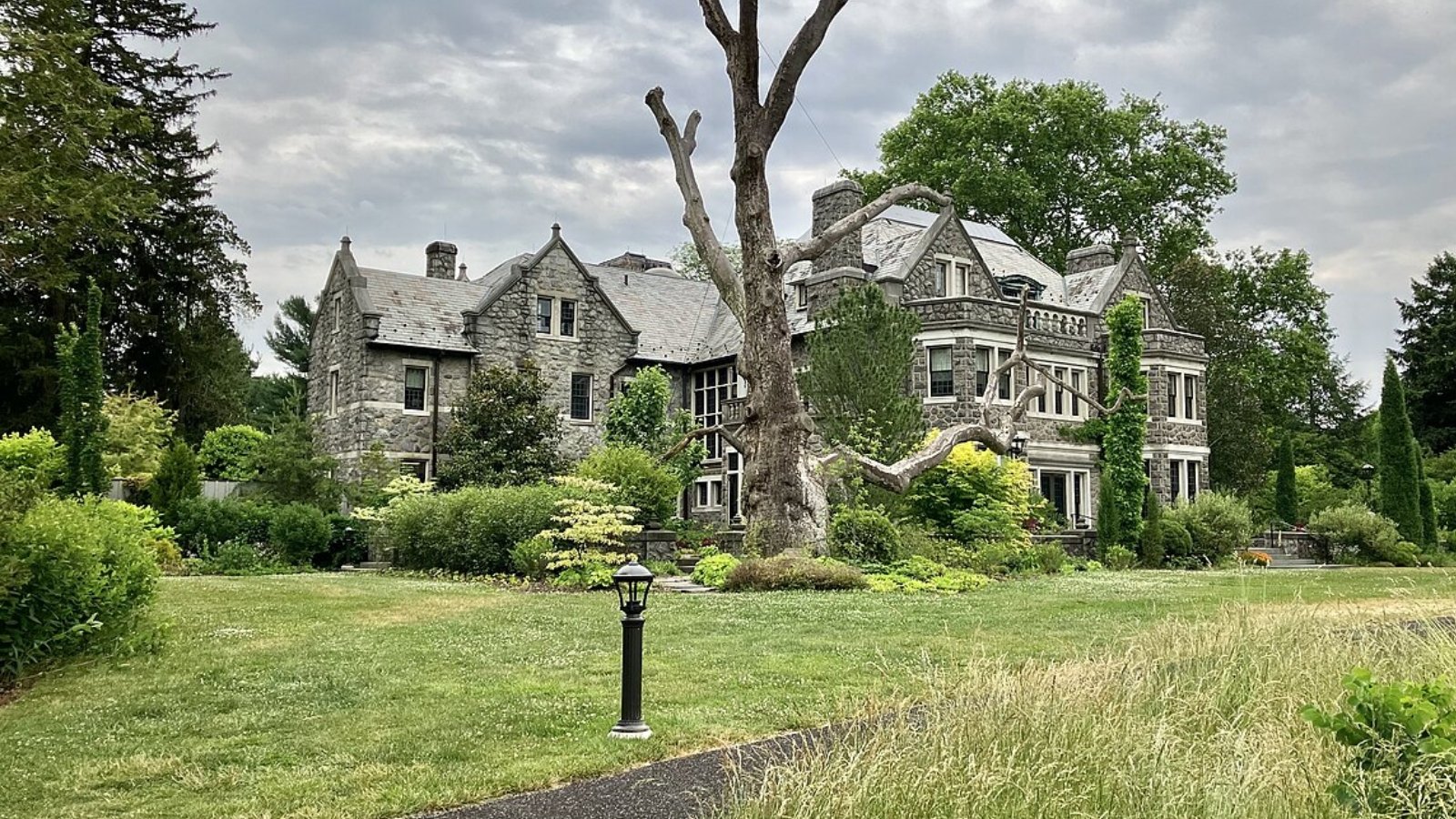
Why are people willing to pay so much to live here? What’s special about it?
Villanova commands exceptional prices as home to prestigious Villanova University and some of the Main Line’s most elegant residential neighborhoods, creating a unique combination of academic distinction and suburban luxury. The community attracts affluent families seeking the ultimate in educational excellence, with access to both the university’s resources and top-rated local schools. The presence of the university adds cultural vitality, athletic excitement, and intellectual atmosphere that enhances residential appeal beyond typical wealthy suburbs.
The location provides perfect balance between academic culture and suburban elegance, with beautiful tree-lined streets, architectural variety, and convenient access to Philadelphia. Villanova’s reputation for educational excellence and social prestige appeals to buyers seeking distinction and long-term value. Property values reflect the premium buyers place on this extraordinary combination of university presence, Main Line heritage, and residential excellence.
How Villanova Rose to Prominence
Villanova’s prominence began with the establishment of Villanova University by Augustinian friars in 1842, creating an educational anchor that shaped the community’s character and development. The university was named after Saint Thomas of Villanova, and its presence attracted families who valued educational excellence and Catholic tradition. The Main Line railroad connection made the area accessible to Philadelphia families seeking suburban living near quality education.
The community’s development accelerated as the university grew in reputation and the Main Line became synonymous with Philadelphia’s elite. The combination of academic prestige, beautiful campus, and excellent railroad access created unique appeal that attracted generations of affluent families. This foundation of education, tradition, and accessibility continues to drive property values and maintain Villanova’s position among America’s most prestigious college towns.
3 Interesting Tidbits
1. Basketball Royalty – Villanova University’s championship basketball program brings national attention and creates community excitement that enhances local appeal.
2. Academic Excellence – The university consistently ranks among America’s top institutions, creating intellectual atmosphere and cultural resources that benefit the entire community.
3. Campus Beauty – The university’s stunning Gothic Revival architecture and landscaped campus create visual appeal that enhances surrounding property values.
1. Gladwyne – 5% Home Price Increase Since 2024
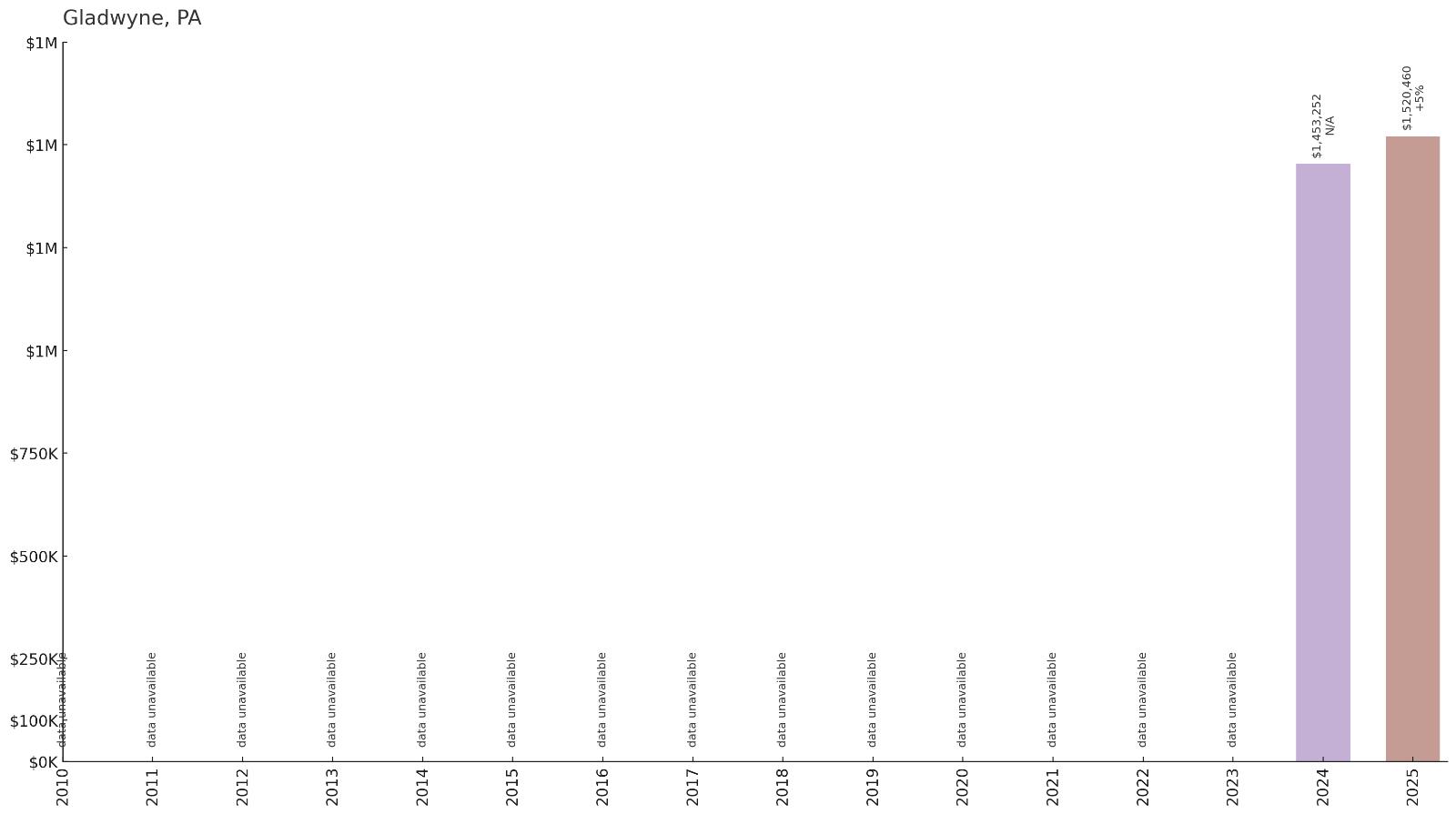
- 2010: N/A
- 2011: N/A
- 2012: N/A
- 2013: N/A
- 2014: N/A
- 2015: N/A
- 2016: N/A
- 2017: N/A
- 2018: N/A
- 2019: N/A
- 2020: N/A
- 2021: N/A
- 2022: N/A
- 2023: N/A
- 2024: $1,453,252
- 2025: $1,520,460
Gladwyne achieved a solid 5% increase from 2024 to 2025, reaching $1,520,460 in median home value. This Montgomery County community represents the absolute pinnacle of Pennsylvania’s luxury housing market. The steady appreciation reflects sustained demand from the region’s wealthiest buyers for this ultra-exclusive location.
Why Gladwyne?

Why are people willing to pay so much to live here? What’s special about it?
Gladwyne commands Pennsylvania’s highest home prices as the most exclusive community in the state, featuring magnificent estates, pristine natural settings, and unparalleled privacy that creates the ultimate in luxury living. The area attracts the region’s wealthiest families seeking expansive properties with architectural distinction and complete privacy. The community’s location along the Main Line provides convenience to Philadelphia while maintaining exclusivity through large lot requirements and natural barriers that preserve character.
The combination of natural beauty, architectural excellence, and social prestige creates an environment that appeals to buyers seeking the absolute best in suburban luxury. Gladwyne’s reputation as Pennsylvania’s most expensive community reflects not just high prices but the exceptional quality of life and exclusivity that these prices represent. Property values reflect the ultimate premium buyers place on privacy, prestige, and perfection in residential living.
How Gladwyne Rose to Prominence
Gladwyne’s prominence grew from its development as the most exclusive enclave along the Main Line, where Philadelphia’s wealthiest families built grand estates in a naturally beautiful setting along the Schuylkill River. The area’s name derives from the Welsh “glad,” meaning riverbank, reflecting both its geography and Main Line heritage. Early development featured the largest and most impressive properties along the entire Main Line corridor.
The community’s exclusivity was enhanced by its natural barriers and careful development that preserved privacy and architectural distinction. Unlike other Main Line communities that accommodated various housing types, Gladwyne maintained its character as an enclave for grand estates and luxury living. This foundation of exclusivity, natural beauty, and architectural excellence continues to drive Gladwyne’s position as Pennsylvania’s most expensive and prestigious residential community.
3 Interesting Tidbits
1. Estate Grandeur – Gladwyne features some of Pennsylvania’s most magnificent private estates with extensive grounds, architectural significance, and complete privacy.
2. Natural Beauty – The community’s location along the Schuylkill River and wooded hillsides creates scenic beauty that enhances property values and residential appeal.
3. Ultimate Exclusivity – With Pennsylvania’s highest home prices and most restrictive zoning, Gladwyne represents the absolute pinnacle of residential prestige in the state.






